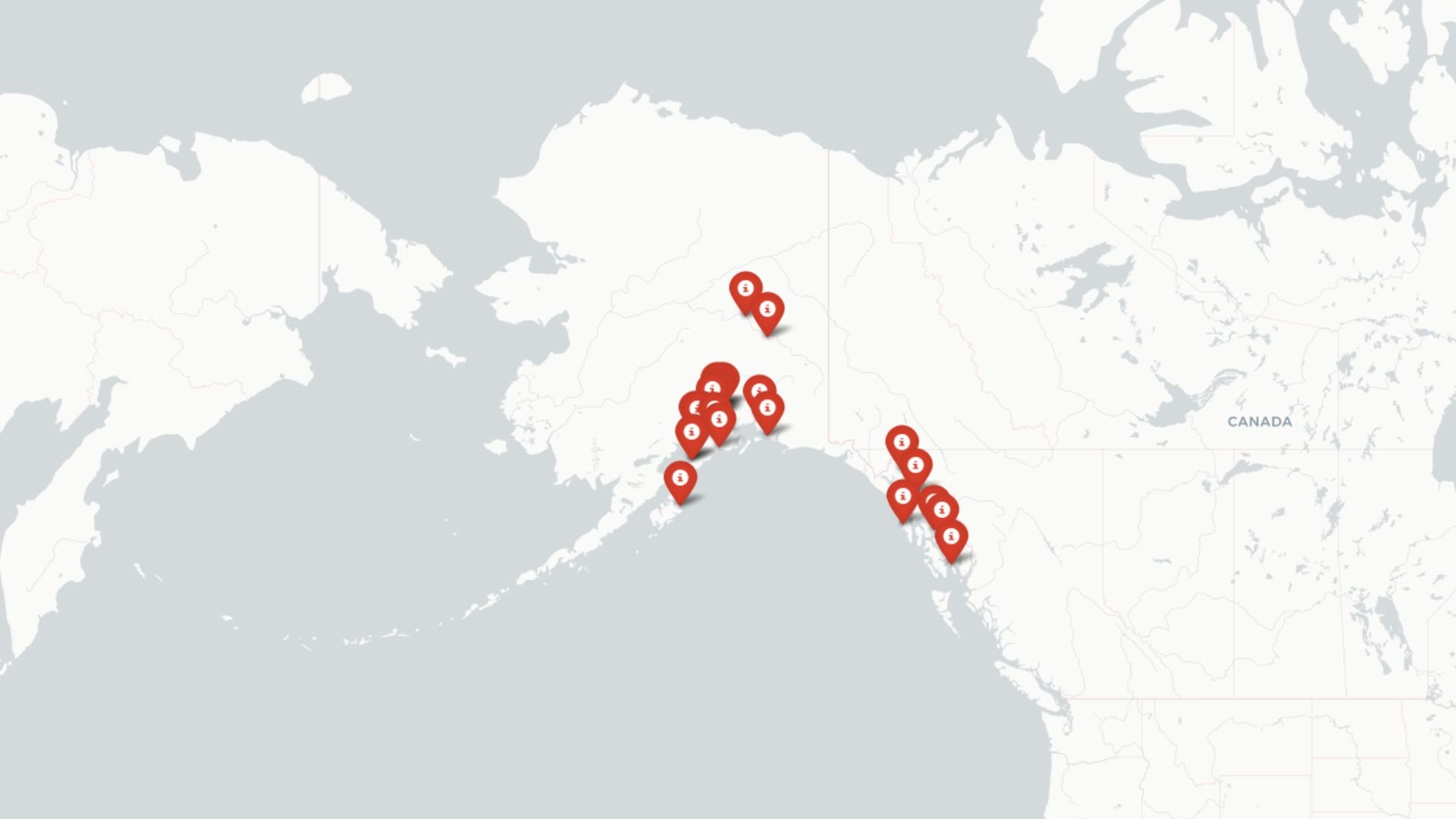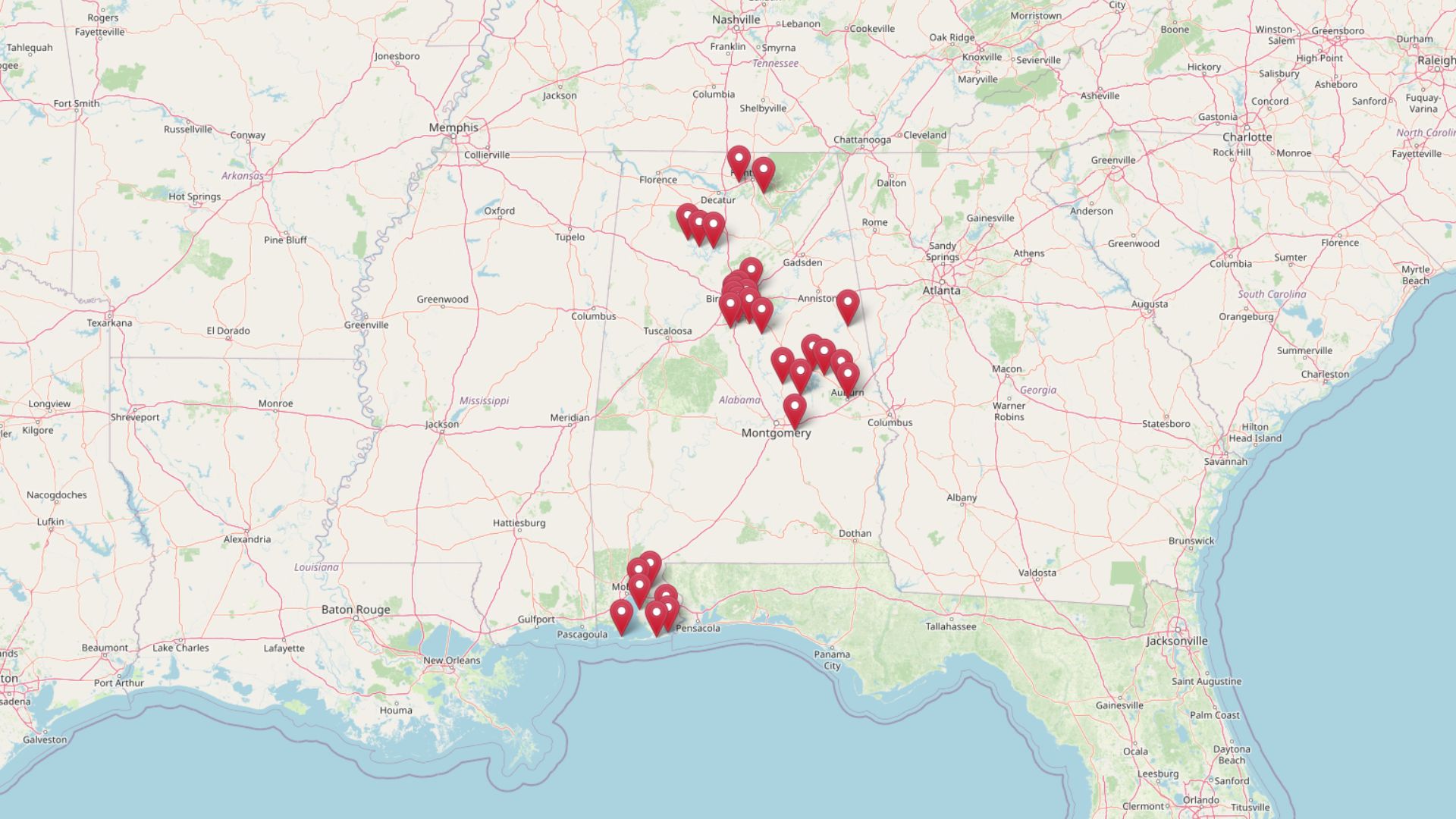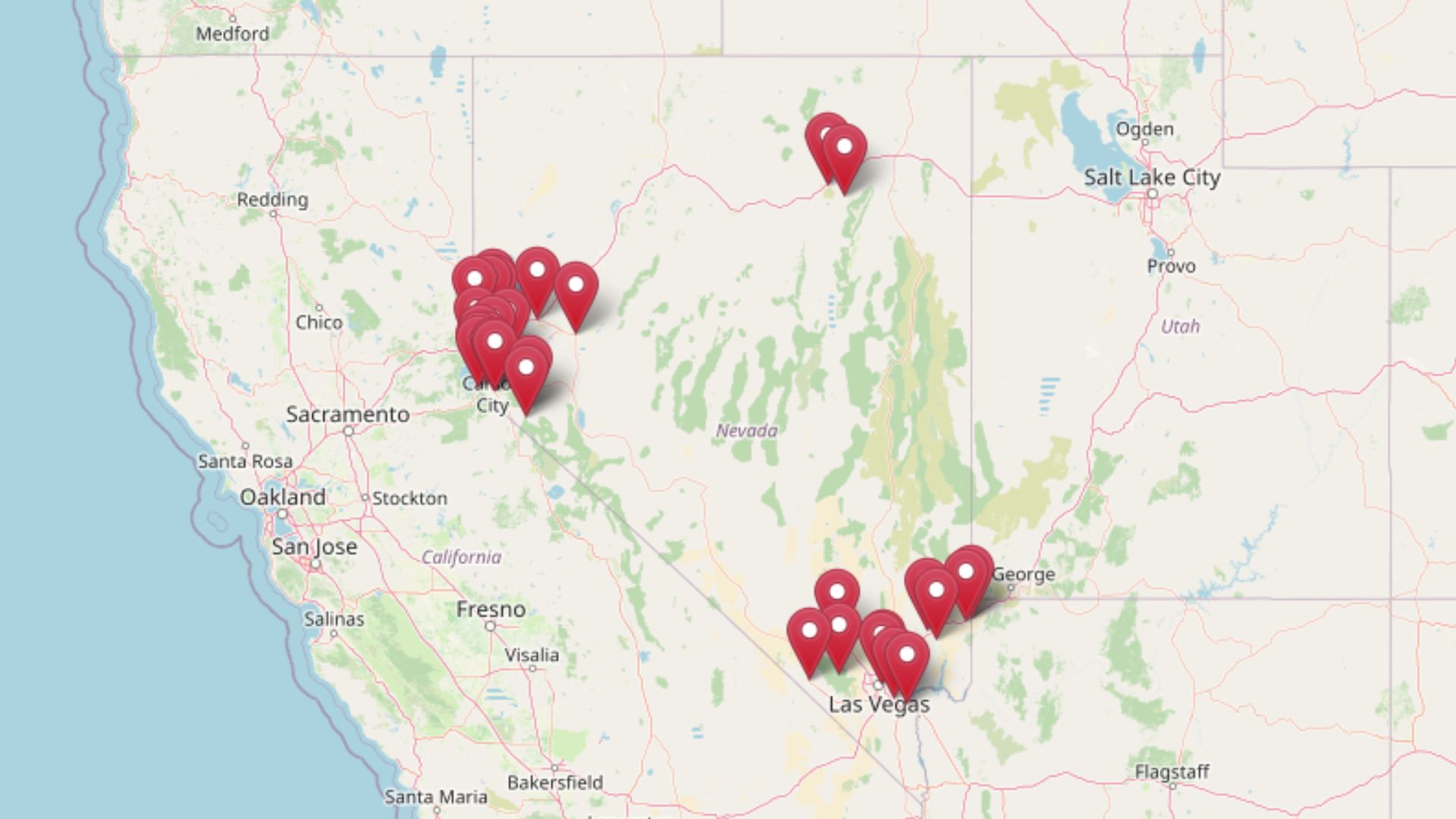
The latest Zillow Home Value Index data shows Nevada’s real estate market has experienced dramatic growth across the state’s most coveted communities. These 30 towns represent the peak of Nevada’s housing market, where property values have soared far beyond state averages. From Lake Tahoe’s exclusive shoreline communities to Northern Nevada’s affluent suburbs, each location demonstrates the lasting appeal of Nevada living.
Many of these communities have doubled or even tripled their home values since 2010, reflecting both California migration patterns and Nevada’s tax advantages. The data reveals clear regional clusters around Lake Tahoe, Reno-Sparks, and select Las Vegas suburbs where premium locations continue commanding top dollar. Whether driven by natural beauty, proximity to major employment centers, or exclusive community amenities, these towns showcase where Nevada’s real estate market reaches its highest peaks.
30. Elko – 47.0% Home Price Increase Since 2010

- 2010: $241,734
- 2011: $222,408
- 2012: $228,390
- 2013: $244,172
- 2014: $244,130
- 2015: $251,250
- 2016: $252,736
- 2017: $254,999
- 2018: $259,696
- 2019: $265,826
- 2020: $273,846
- 2021: $298,843
- 2022: $323,450
- 2023: $330,041
- 2024: $342,640
- 2025: $355,420
Elko has shown steady but modest growth compared to other Nevada communities, with current home values at $355,420. The city experienced some volatility in the early 2010s but has maintained consistent upward momentum since 2013. Mining industry stability and regional economic development have helped support property values in this northeastern Nevada hub.
Why Elko?

Why are people willing to pay so much to live here? What’s special about it?
Elko attracts residents with its blend of small-town charm and economic opportunity, anchored by Nevada’s gold mining industry. Families appreciate the strong community feel, outdoor recreation access, and relatively affordable cost of living compared to urban Nevada centers. The city offers four-season outdoor activities from skiing to hunting, plus cultural events like the National Cowboy Poetry Gathering that draw visitors nationwide.
Unlike larger Nevada cities, Elko provides a genuine Western lifestyle with modern amenities and stable employment opportunities. The mining sector provides high-paying jobs while the cost of living remains reasonable. Historic downtown charm combined with newer residential developments creates options for different lifestyle preferences while maintaining the area’s authentic character.
How Elko Rose to Prominence
Elko was founded in 1868 as a railroad town along the Central Pacific Railroad, serving as a key stop on the transcontinental route. The discovery of gold in nearby mountains during the late 1800s established the area’s mining heritage, which continues to drive the local economy today. The name “Elko” was chosen by railroad officials, though its exact origin remains debated among historians.
The modern gold boom beginning in the 1960s transformed Elko from a small railroad town into a mining industry center. Major mining companies established operations in the region, creating high-paying jobs and attracting workers from across the country. This economic foundation has provided stability that many rural Nevada communities lack, supporting consistent population growth and property value appreciation over decades.
3 Interesting Tidbits
1. Cowboy Poetry Capital – Elko hosts the annual National Cowboy Poetry Gathering, drawing thousands of visitors and showcasing the area’s Western heritage through literature and music.
2. Gold Country – The surrounding region produces more gold than any other area in the United States, making Elko the unofficial capital of American gold mining.
3. Basque Culture – Elko has one of the largest Basque populations in the American West, with authentic restaurants, festivals, and cultural traditions that date back to the 1800s sheep ranching era.
29. Pahrump – 204.3% Home Price Increase Since 2010
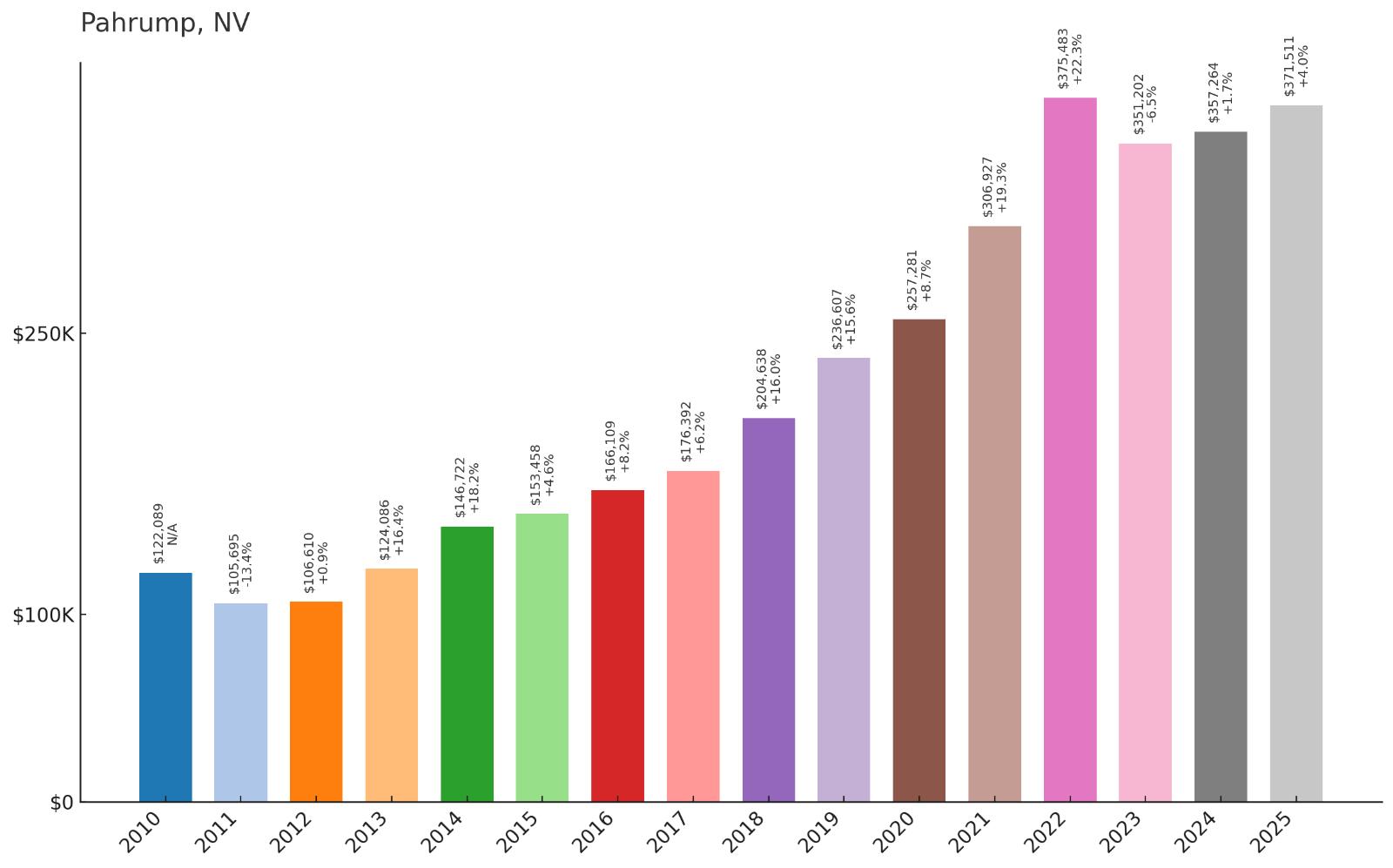
- 2010: $122,089
- 2011: $105,695
- 2012: $106,610
- 2013: $124,086
- 2014: $146,722
- 2015: $153,458
- 2016: $166,109
- 2017: $176,392
- 2018: $204,638
- 2019: $236,607
- 2020: $257,281
- 2021: $306,927
- 2022: $375,483
- 2023: $351,202
- 2024: $357,264
- 2025: $371,511
Pahrump has experienced remarkable growth, with home values more than tripling since 2010 to reach $371,511 in 2025. The community saw significant acceleration after 2018, with values jumping dramatically during the pandemic-era real estate boom. Despite some cooling in 2023, prices have resumed their upward trajectory, reflecting strong demand for this desert community.
Why Pahrump?
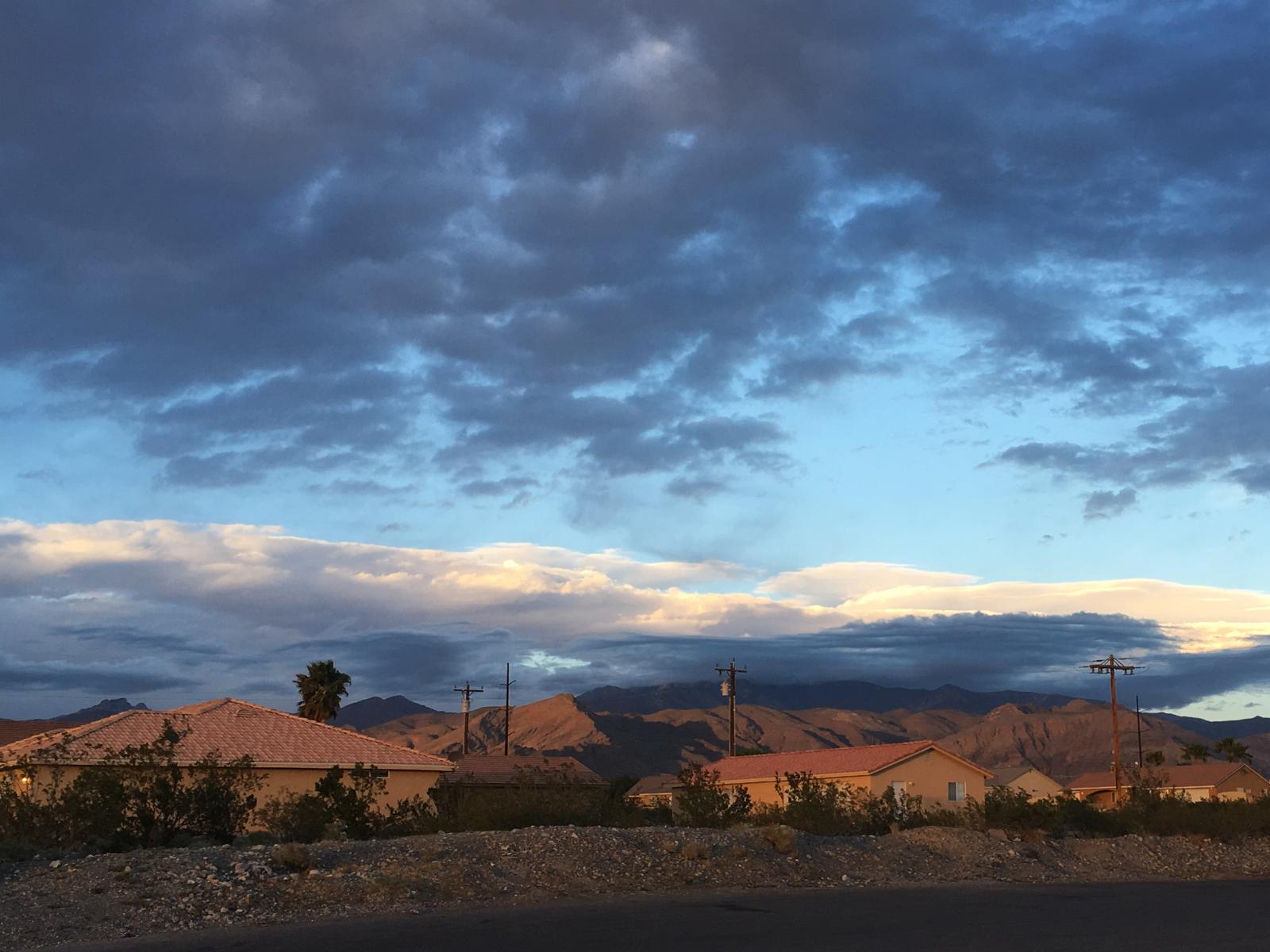
Why are people willing to pay so much to live here? What’s special about it?
Pahrump appeals to buyers seeking affordable desert living with proximity to Las Vegas amenities. Retirees are drawn to the tax-friendly environment, lower cost of living, and wide-open spaces that offer privacy and room to roam. The area provides a slower pace of life while keeping Las Vegas just an hour away for entertainment, shopping, and healthcare needs.
Unlike crowded Las Vegas suburbs, Pahrump offers larger lots, horse-friendly zoning, and mountain views in every direction. The community attracts those who want to escape city congestion while maintaining access to urban conveniences. Rural character combined with modern infrastructure appeals to buyers seeking the best of both worlds in Southern Nevada.
How Pahrump Rose to Prominence
Pahrump Valley was originally settled by Native American tribes who used the area’s natural springs for thousands of years. Mormon pioneers arrived in the 1870s, followed by homesteaders who established small farms and ranches using artesian wells. The name “Pahrump” comes from the Southern Paiute word meaning “water rock,” reflecting the area’s precious water resources in the Mojave Desert.
Modern development began in earnest during the 1960s and 1970s as Las Vegas grew and people sought affordable land nearby. The completion of improved highway connections made commuting to Las Vegas feasible, while Nevada’s lack of state income tax attracted California transplants. Population exploded from a few hundred residents in 1970 to over 36,000 today, driven by retirees and those seeking rural Nevada lifestyle.
3 Interesting Tidbits
1. Wine Country – Pahrump Valley Winery, Nevada’s first commercial winery, has been producing award-winning wines since 1990 in this unlikely desert location.
2. Extraterrestrial Highway – State Route 375 passes through Pahrump area and is officially designated as the “Extraterrestrial Highway” due to its proximity to Area 51 and UFO sightings.
3. Brothel Central – Pahrump is home to several of Nevada’s legal brothels, including some featured in HBO documentaries and reality shows about the state’s unique prostitution laws.
28. Bunkerville – 196.9% Home Price Increase Since 2010

- 2010: $125,538
- 2011: $109,812
- 2012: $100,398
- 2013: $135,203
- 2014: $160,122
- 2015: $173,651
- 2016: $187,813
- 2017: $205,698
- 2018: $238,824
- 2019: $256,743
- 2020: $256,820
- 2021: $306,299
- 2022: $364,413
- 2023: $342,424
- 2024: $365,567
- 2025: $372,736
Bunkerville has nearly tripled its home values since hitting a low point in 2012, now reaching $372,736. The community bounced back strongly from early 2010s lows, showing consistent growth that accelerated significantly after 2020. This small southern Nevada town has proven surprisingly resilient despite its remote location and limited amenities.
Why Bunkerville?

Why are people willing to pay so much to live here? What’s special about it?
Bunkerville attracts buyers seeking rural tranquility with stunning red rock desert scenery and proximity to outdoor recreation. The community offers small-town atmosphere where neighbors know each other, combined with larger lots and privacy that’s increasingly rare in Southern Nevada. Residents appreciate the area’s conservative values, agricultural heritage, and strong community bonds forged by shared challenges.
Unlike urban Nevada communities, Bunkerville provides genuine rural living with farming and ranching still part of daily life. The Virgin River runs through the area, supporting agriculture and creating green corridors in the desert landscape. Buyers are drawn to the peaceful setting, dark night skies, and escape from city pressures while remaining within reach of Las Vegas amenities.
How Bunkerville Rose to Prominence
Bunkerville was founded in 1877 by Mormon pioneers led by Edward Bunker, for whom the town is named. These early settlers established farms along the Virgin River, using irrigation to grow cotton, grapes, and other crops in the desert valley. The community remained largely agricultural and isolated until modern highway connections improved access to Las Vegas and St. George, Utah.
The town gained national attention in 2014 during the Cliven Bundy standoff, highlighting tensions between federal land management and local ranching traditions. While controversial, this event brought awareness to the area’s rural character and independent spirit. Recent growth reflects broader trends of Las Vegas area expansion and buyers seeking authentic Western lifestyle experiences.
3 Interesting Tidbits
1. Historic Cotton Mission – Bunkerville was part of the Mormon Cotton Mission, an early attempt to grow cotton in the American Southwest that helped establish several southern Nevada communities.
2. Virgin River Oasis – The Virgin River provides the only year-round flowing water in this part of southern Nevada, creating a green ribbon of agriculture and wildlife habitat in the Mojave Desert.
3. Ranching Heritage – Several families have ranched in the area for over 140 years, maintaining traditional Western lifestyles and cattle operations despite urban encroachment from Las Vegas.
27. Fallon – 172.7% Home Price Increase Since 2010
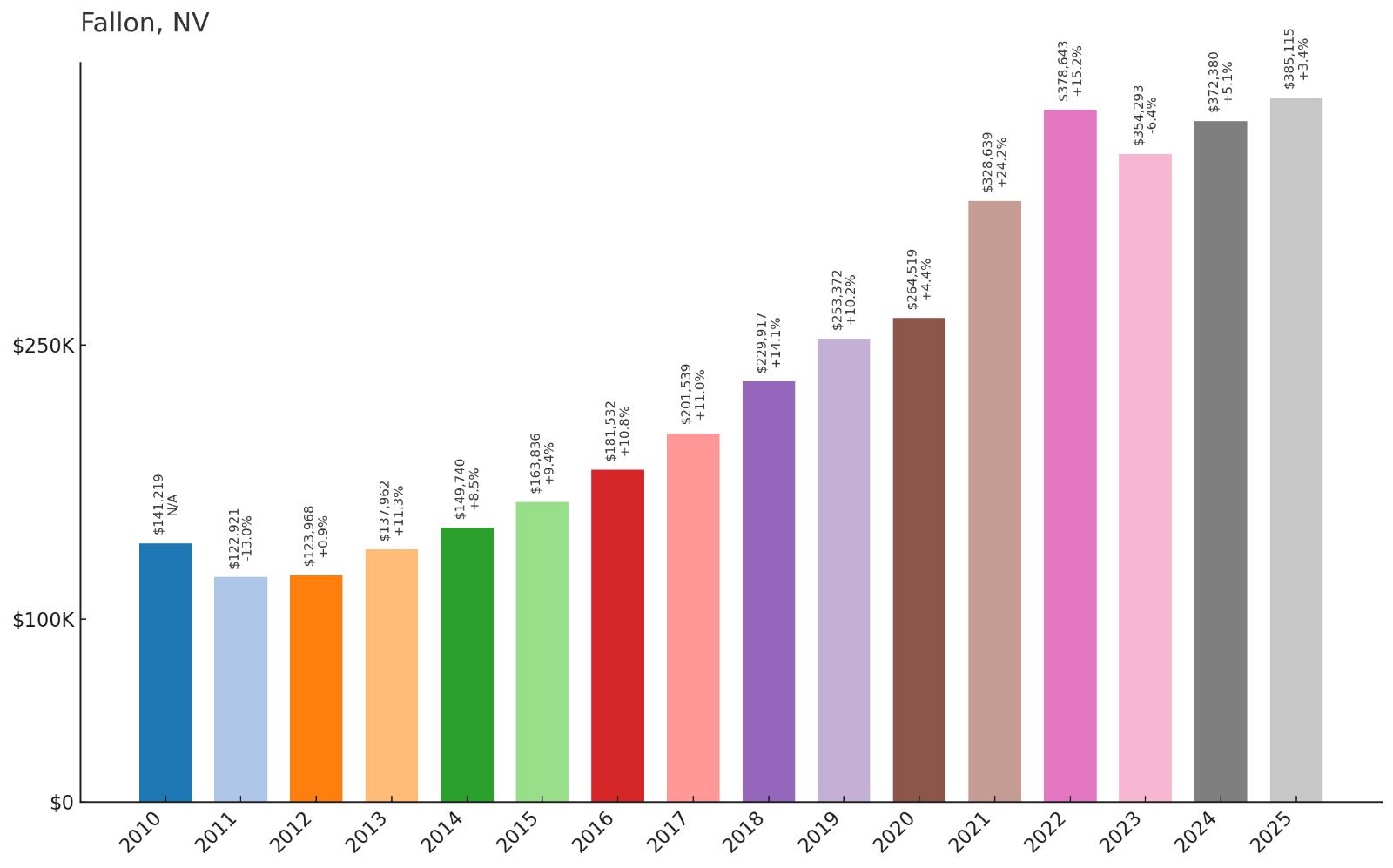
- 2010: $141,219
- 2011: $122,921
- 2012: $123,968
- 2013: $137,962
- 2014: $149,740
- 2015: $163,836
- 2016: $181,532
- 2017: $201,539
- 2018: $229,917
- 2019: $253,372
- 2020: $264,519
- 2021: $328,639
- 2022: $378,643
- 2023: $354,293
- 2024: $372,380
- 2025: $385,115
Fallon has achieved impressive growth with home values reaching $385,115, representing a 172.7% increase since 2010. After struggling through the early 2010s recession, the community has shown strong recovery with particularly notable gains after 2020. The city’s military presence and agricultural economy have provided stability supporting consistent property value appreciation.
Why Fallon?
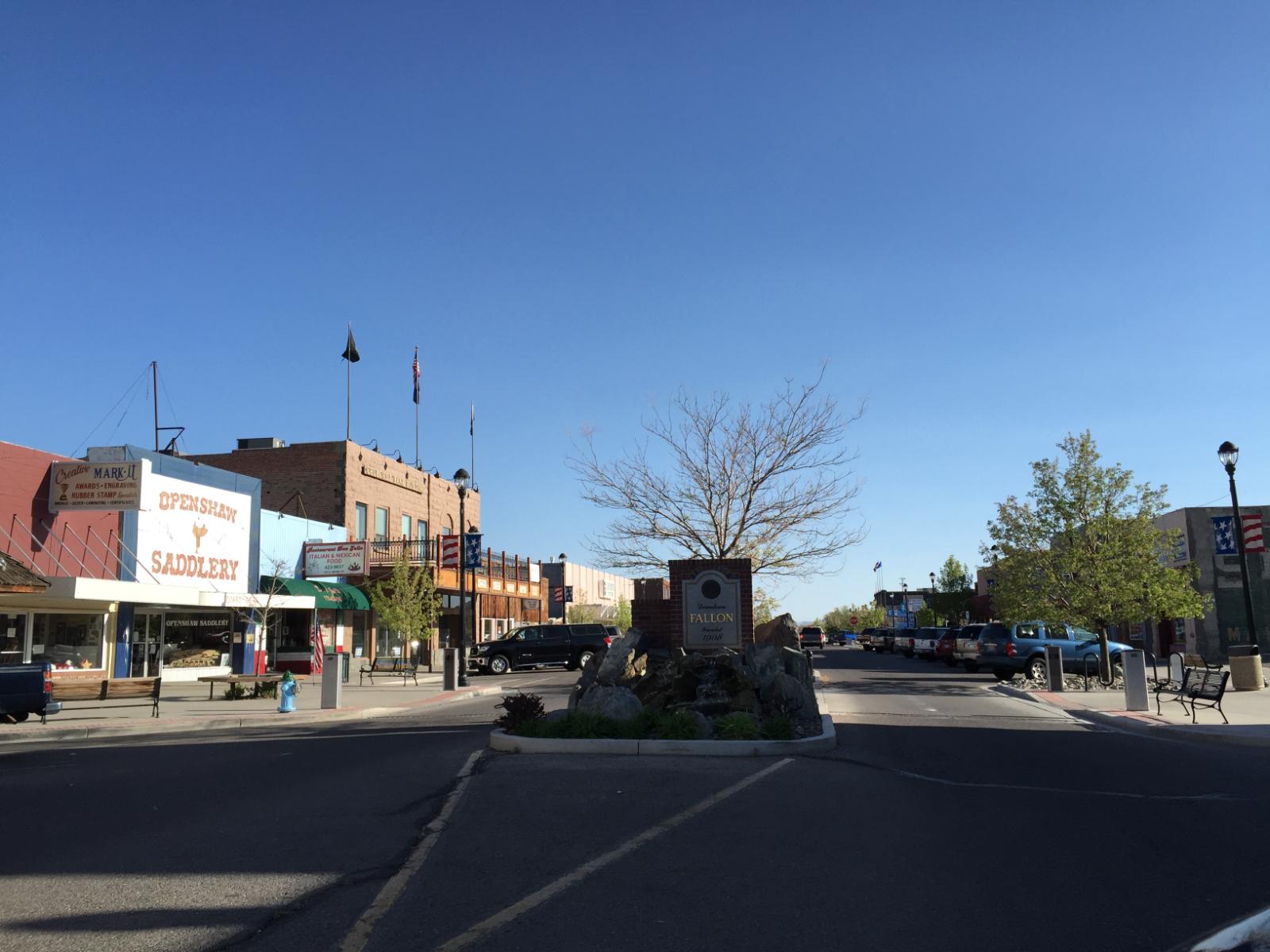
Why are people willing to pay so much to live here? What’s special about it?
Fallon appeals to military families stationed at nearby Naval Air Station Fallon, offering small-town community feel with modern amenities. Residents value the area’s agricultural heritage, outdoor recreation opportunities, and affordable cost of living compared to urban Nevada centers. The community provides authentic rural Nevada living while maintaining good schools, healthcare, and cultural activities that support family life.
Unlike typical military towns, Fallon has maintained its agricultural character and Western heritage alongside its defense industry role. The area offers excellent hunting, fishing, and outdoor recreation in nearby mountains and desert areas. Strong community ties and civic pride create a welcoming environment for both military and civilian families seeking small-town values.
How Fallon Rose to Prominence
Fallon was established in 1896 when the Southern Pacific Railroad built through the area, creating a crucial transportation link across central Nevada. Early settlers developed irrigation systems using the Carson River, transforming desert into productive farmland that earned the area the nickname “Oasis of Nevada.” Agriculture, particularly alfalfa and cattle ranching, dominated the local economy for decades.
World War II brought dramatic change when the Navy established Naval Air Station Fallon in 1942 for pilot training. The base became permanent after the war, evolving into the Navy’s premier tactical training facility known as “Top Gun” country. This military presence brought stable employment, population growth, and economic diversification while preserving the community’s agricultural roots and Western character.
3 Interesting Tidbits
1. Top Gun Training – Naval Air Station Fallon hosts the Navy Fighter Weapons School, famously known as “Top Gun,” where elite pilots train in advanced tactical warfare.
2. Hearts of Gold Cantaloupe – Fallon is famous for producing some of America’s sweetest cantaloupes, with the area’s alkaline soil and hot days creating ideal growing conditions.
3. Shoe Tree – The famous Shoe Tree along Highway 50 near Fallon became a roadside attraction where travelers hung thousands of shoes before it was cut down in 2010, spawning several successor trees.
26. Mesquite – 113.8% Home Price Increase Since 2010
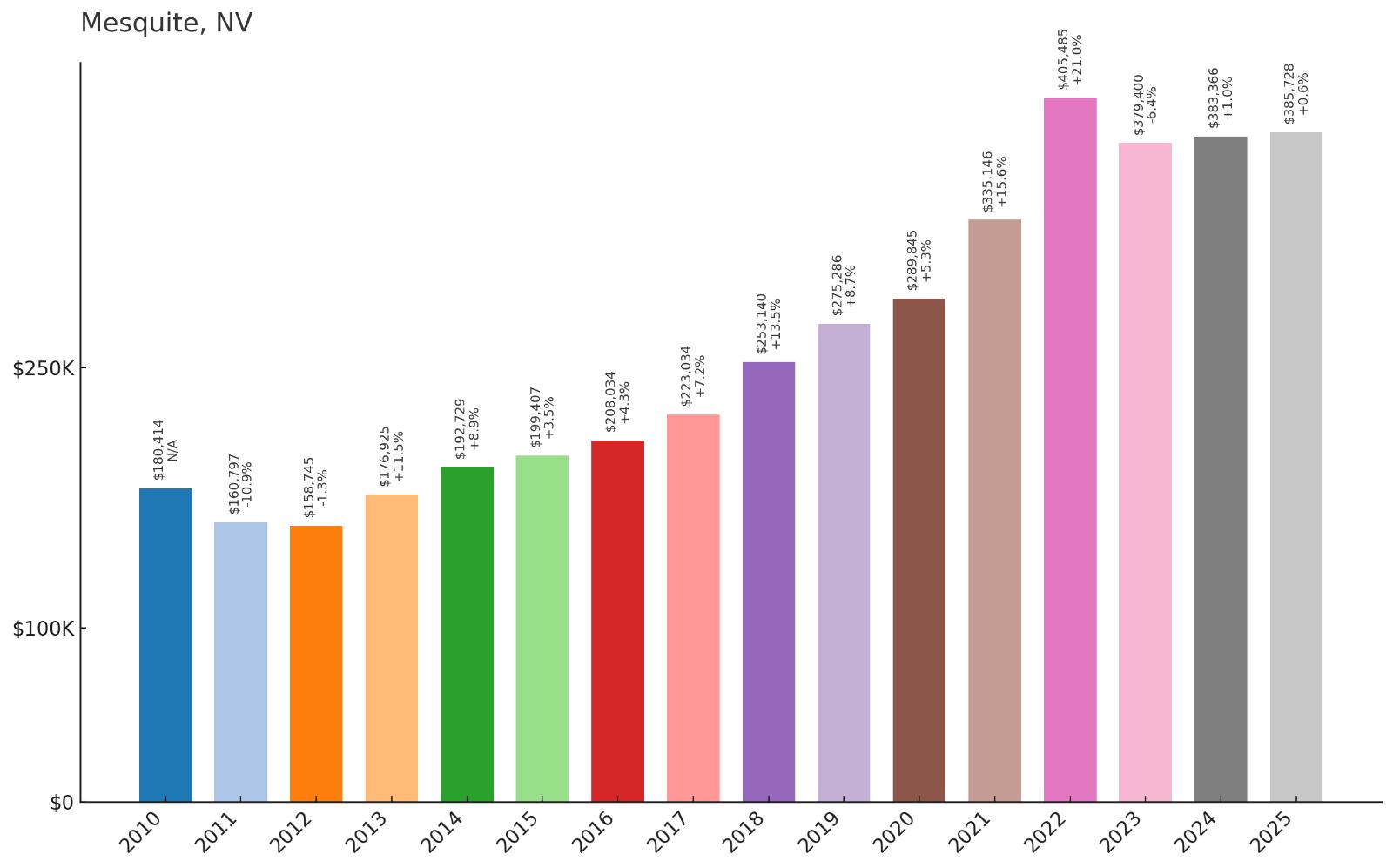
- 2010: $180,414
- 2011: $160,797
- 2012: $158,745
- 2013: $176,925
- 2014: $192,729
- 2015: $199,407
- 2016: $208,034
- 2017: $223,034
- 2018: $253,140
- 2019: $275,286
- 2020: $289,845
- 2021: $335,146
- 2022: $405,485
- 2023: $379,400
- 2024: $383,366
- 2025: $385,728
Mesquite has more than doubled its home values since 2010, reaching $385,728 in 2025. The community showed remarkable resilience through market fluctuations, with particularly strong growth after 2017 as its retirement-friendly amenities attracted new residents. Despite some cooling in 2023, the market has stabilized at elevated levels reflecting continued demand for this southern Nevada destination.
Why Mesquite?
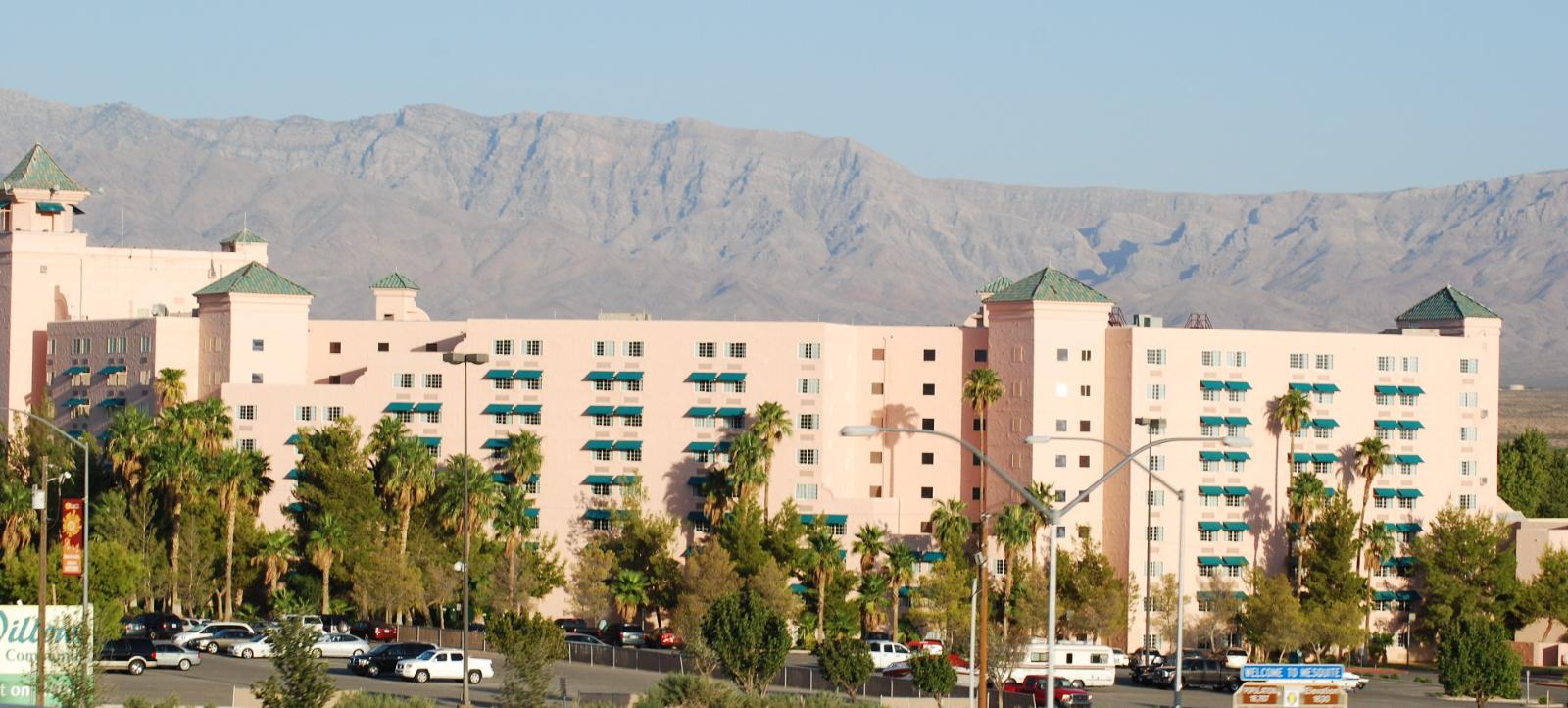
Why are people willing to pay so much to live here? What’s special about it?
Mesquite attracts retirees and golf enthusiasts with its championship golf courses, resort amenities, and favorable tax climate. The community offers desert beauty with red rock formations while maintaining proximity to Las Vegas entertainment and Utah national parks. Residents enjoy an active adult lifestyle with numerous recreational activities, mild winters, and strong property values that support long-term investment goals.
Unlike typical desert communities, Mesquite has developed into a resort destination with multiple golf courses, casinos, and recreational amenities that support both residents and tourists. The area provides a small-town feel with big-city conveniences, excellent healthcare facilities, and cultural activities. Master-planned communities offer maintenance-free living options particularly appealing to active retirees.
How Mesquite Rose to Prominence
Mesquite began as a small farming community in the 1880s when Mormon pioneers established settlements along the Virgin River valley. Early residents grew cotton, fruit, and vegetables using river irrigation, but the harsh desert environment kept the population small for nearly a century. The town remained largely agricultural until tourism and gaming development began transforming the area in the 1990s.
Modern Mesquite emerged in the 1990s when gaming companies recognized the area’s potential as a resort destination between Las Vegas and Salt Lake City. Major casino and golf course developments attracted tourists and eventually permanent residents seeking resort-style living. The city’s strategic location near Interstate 15 and its development of championship golf courses established it as a premier retirement destination.
3 Interesting Tidbits
1. Golf Paradise – Mesquite boasts more championship golf courses per capita than almost any other city in America, earning the nickname “Golf Capital of Nevada.”
2. Virgin River Gorge – The nearby Virgin River Gorge on Interstate 15 is considered one of the most spectacular highway drives in America, cutting through dramatic red rock canyons.
3. Dual State Lifestyle – Mesquite sits just minutes from the Utah border, allowing residents to enjoy Nevada’s tax benefits while accessing Utah’s national parks and outdoor recreation areas.
25. Fernley – 265.4% Home Price Increase Since 2010
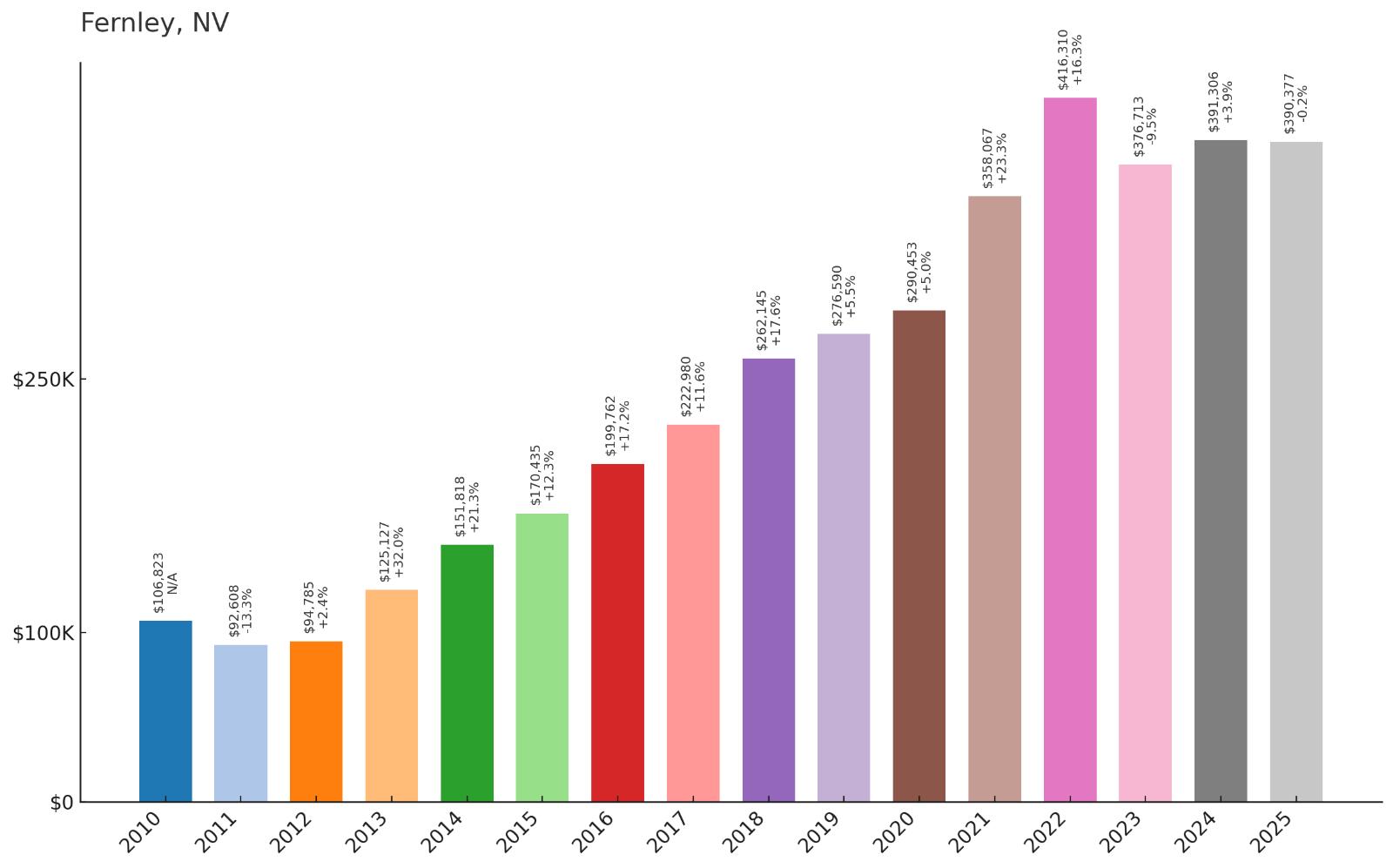
- 2010: $106,823
- 2011: $92,608
- 2012: $94,785
- 2013: $125,127
- 2014: $151,818
- 2015: $170,435
- 2016: $199,762
- 2017: $222,980
- 2018: $262,145
- 2019: $276,590
- 2020: $290,453
- 2021: $358,067
- 2022: $416,310
- 2023: $376,713
- 2024: $391,306
- 2025: $390,377
Fernley has achieved extraordinary growth, with home values increasing 265.4% since 2010 to reach $390,377. The community experienced one of Nevada’s most dramatic recovery stories, climbing from recession lows to peak values that reflect its emergence as a major distribution and logistics hub. Strong industrial growth has driven consistent demand for housing in this strategically located community.
Why Fernley?

Why are people willing to pay so much to live here? What’s special about it?
Fernley attracts residents with its combination of small-town charm and major employment opportunities in distribution and manufacturing. Families appreciate the affordable housing, good schools, and safe community environment while benefiting from proximity to Reno employment centers. The area offers rural feel with modern infrastructure and growing retail amenities that support comfortable suburban living.
Unlike other small Nevada towns, Fernley has transformed into an industrial powerhouse while maintaining its community character. Major employers like Amazon, Walmart, and Tesla have created thousands of jobs, driving population growth and housing demand. The combination of economic opportunity and quality of life appeals to both young families and established professionals seeking Nevada advantages.
How Fernley Rose to Prominence
Fernley was founded in 1904 as a railroad town along the Southern Pacific line, serving as a division point and maintenance facility. The town was named after Southern Pacific executive J.P. Fernley, and its early economy centered on railroad operations and agriculture using water from the Truckee Canal. For decades, Fernley remained a small railroad community with limited growth prospects.
The transformation began in the 2000s when major distribution companies recognized Fernley’s strategic location along Interstate 80 between California and eastern markets. Warehouse and fulfillment center construction accelerated after the Great Recession, with companies attracted by available land, transportation access, and Nevada’s business-friendly environment. The arrival of Tesla’s Gigafactory nearby further solidified the area’s role as a major industrial center.
3 Interesting Tidbits
1. Distribution Hub – Fernley has become one of the West’s major distribution centers, with massive fulfillment centers serving Amazon, Walmart, and other retail giants shipping nationwide.
2. Canal Town Heritage – The historic Truckee Canal, completed in 1905, brought Truckee River water to the area for irrigation and established Fernley’s agricultural foundation that lasted for generations.
3. Railroad Legacy – Fernley’s historic roundhouse and railroad infrastructure remind visitors of its origins as a crucial Southern Pacific Railroad maintenance and operations center.
24. Indian Springs – 7.5% Home Price Increase Since 2023

- 2010: N/A
- 2011: N/A
- 2012: N/A
- 2013: N/A
- 2014: N/A
- 2015: N/A
- 2016: N/A
- 2017: N/A
- 2018: N/A
- 2019: N/A
- 2020: N/A
- 2021: N/A
- 2022: N/A
- 2023: $365,276
- 2024: $383,511
- 2025: $392,566
Indian Springs shows limited data availability, with values only tracked since 2023 when median home prices reached $365,276. Current values at $392,566 represent modest 7.5% growth over the tracked period. The community’s remote desert location and limited development have kept price appreciation more restrained compared to other Nevada markets.
Why Indian Springs?

Why are people willing to pay so much to live here? What’s special about it?
Indian Springs appeals to buyers seeking ultimate privacy and rural desert living within commuting distance of Las Vegas. The community attracts those who want wide-open spaces, dark night skies, and freedom from urban restrictions while maintaining access to city amenities. Residents value the area’s military heritage, outdoor recreation opportunities, and authentic Western lifestyle that’s increasingly rare in southern Nevada.
Unlike developed Nevada communities, Indian Springs offers true frontier living with large lots, horse-friendly zoning, and minimal government oversight. The area provides escape from city congestion while maintaining reasonable access to Las Vegas employment and services. Desert beauty, mountain views, and wildlife viewing attract those seeking connection with Nevada’s natural environment.
How Indian Springs Rose to Prominence
Indian Springs was originally inhabited by Southern Paiute tribes who used natural springs in the area for thousands of years. European-American settlement began in the late 1800s with ranching and mining operations, but the area remained sparsely populated due to its harsh desert environment and remote location. Early settlers established small ranches using the limited water sources available.
World War II brought significant development when the military established Indian Springs Air Force Base in 1942 for bomber crew training. The base operated through the Cold War era, providing economic foundation for the small community. Though the base closed in the 1990s, military contractors and retirees continued to call the area home, maintaining its connection to defense industries while embracing civilian rural living.
3 Interesting Tidbits
1. Military Heritage – Indian Springs Air Force Base trained thousands of World War II bomber crews and later served as a strategic Cold War installation before transitioning to civilian use.
2. Desert Springs – Natural springs that gave the community its name continue to provide water in this arid region, creating oases that support wildlife and limited agriculture.
3. Dark Sky Paradise – The area’s remote location and minimal light pollution make it one of southern Nevada’s premier stargazing locations, attracting amateur astronomers and photographers.
23. Spring Creek – 64.8% Home Price Increase Since 2010
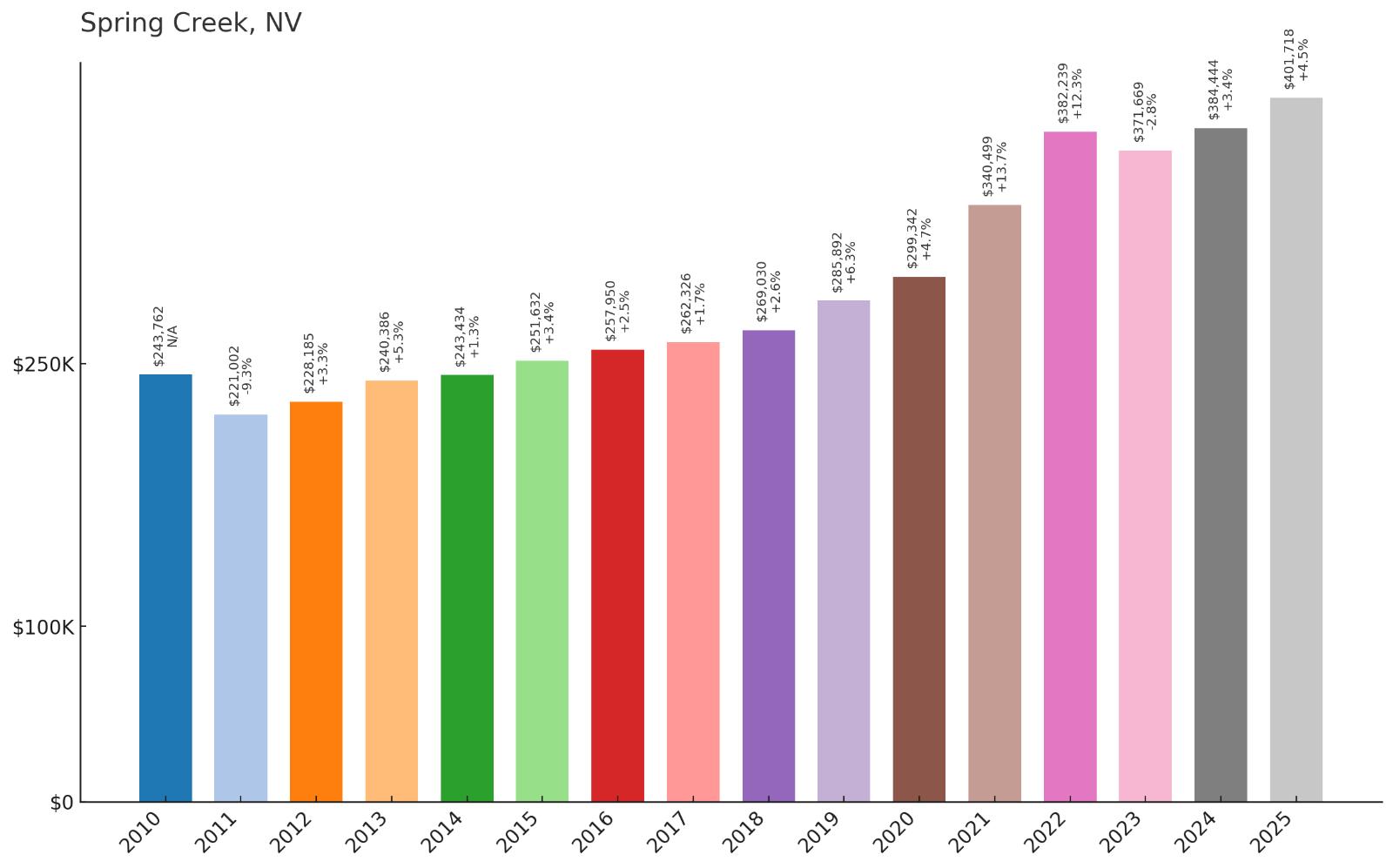
- 2010: $243,762
- 2011: $221,002
- 2012: $228,185
- 2013: $240,386
- 2014: $243,434
- 2015: $251,632
- 2016: $257,950
- 2017: $262,326
- 2018: $269,030
- 2019: $285,892
- 2020: $299,342
- 2021: $340,499
- 2022: $382,239
- 2023: $371,669
- 2024: $384,444
- 2025: $401,718
Spring Creek has shown steady growth with home values reaching $401,718, representing a solid 64.8% increase since 2010. The community experienced consistent but measured appreciation through most of the period, with acceleration during the pandemic boom years. This northeastern Nevada community has maintained stable growth patterns despite its rural location and limited size.
Why Spring Creek?
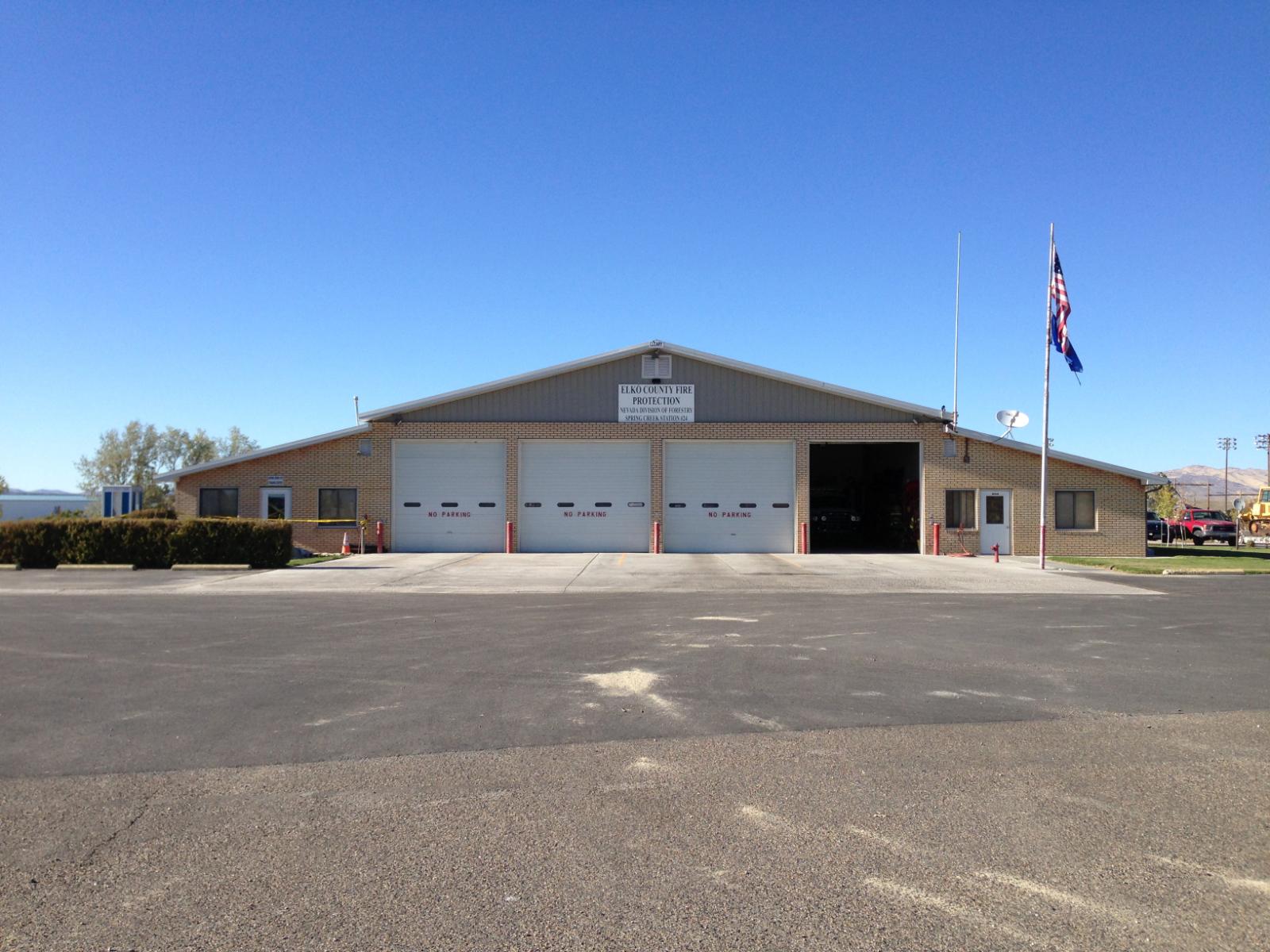
Why are people willing to pay so much to live here? What’s special about it?
Spring Creek attracts residents seeking upscale rural living with mountain views and outdoor recreation access near Elko. The community offers newer homes, planned development amenities, and small-town safety while maintaining proximity to mining industry employment. Families appreciate the excellent schools, low crime rates, and quality of life that combines suburban comfort with rural Nevada character.
Unlike typical rural Nevada towns, Spring Creek was developed as a planned community with modern infrastructure, parks, and recreational facilities. The area provides resort-style amenities including golf course living, walking trails, and community centers while maintaining the peaceful atmosphere that attracts families seeking escape from urban pressures. Geographic beauty and outdoor access enhance the lifestyle appeal.
How Spring Creek Rose to Prominence
Spring Creek began development in the 1970s as a master-planned community designed to serve Elko’s growing population and mining industry workforce. The area was carefully planned to provide suburban-style living in rural Nevada, with curved streets, parks, and modern utilities that contrasted with older grid-pattern Western towns. Development accelerated during gold mining booms as companies sought quality housing for their professional and management employees.
The community’s growth coincided with Nevada’s modern gold rush, which brought higher-income mining professionals to the Elko area seeking family-friendly neighborhoods. Spring Creek’s planned development approach created a suburban oasis in rural Nevada, attracting residents who wanted modern amenities without sacrificing access to outdoor recreation and small-town values. The community has maintained its planned character while growing steadily with the regional economy.
3 Interesting Tidbits
1. Planned Perfection – Spring Creek was one of Nevada’s first master-planned communities outside major metro areas, featuring curved streets and neighborhood parks designed for family living.
2. Mining Elite – The community was originally developed to attract mining company executives and professionals, creating an upscale enclave in rural northeastern Nevada.
3. Ruby Mountains Gateway – Spring Creek serves as a gateway to the Ruby Mountains, known as Nevada’s “Swiss Alps” for their dramatic peaks and alpine lakes accessible via hiking trails.
22. North Las Vegas – 250.6% Home Price Increase Since 2010
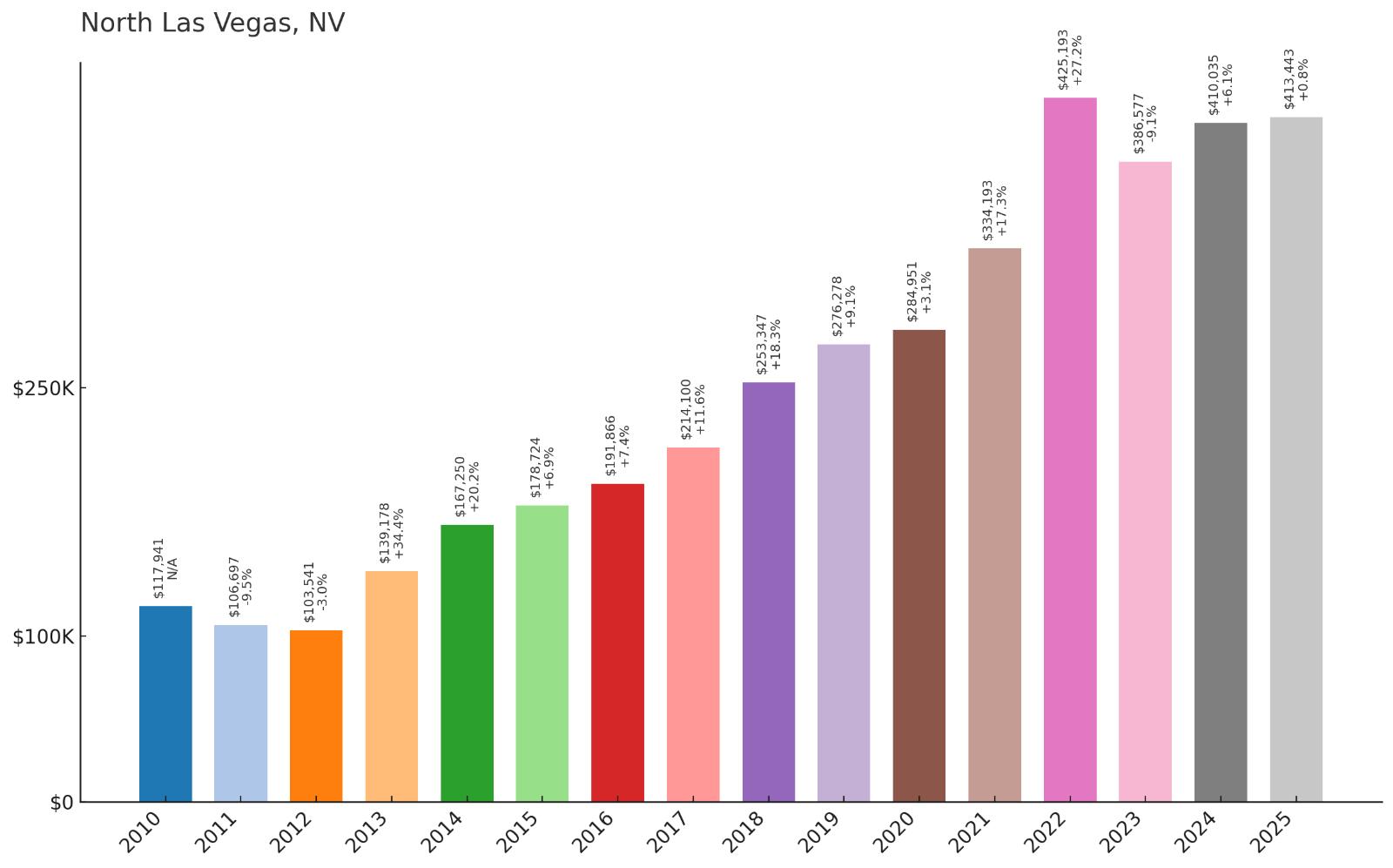
- 2010: $117,941
- 2011: $106,697
- 2012: $103,541
- 2013: $139,178
- 2014: $167,250
- 2015: $178,724
- 2016: $191,866
- 2017: $214,100
- 2018: $253,347
- 2019: $276,278
- 2020: $284,951
- 2021: $334,193
- 2022: $425,193
- 2023: $386,577
- 2024: $410,035
- 2025: $413,443
North Las Vegas has achieved dramatic transformation with home values climbing 250.6% since 2010 to reach $413,443. The city recovered strongly from recession lows, showing consistent growth that accelerated significantly after 2017 as the area shed its reputation and attracted new investment. This remarkable appreciation reflects the community’s evolution from struggling suburb to desirable residential destination.
Why North Las Vegas?

Why are people willing to pay so much to live here? What’s special about it?
North Las Vegas attracts homebuyers with its affordable entry point into Las Vegas Valley homeownership and rapid neighborhood improvements. Young families appreciate the newer subdivisions, improving schools, and proximity to job centers while benefiting from lower prices than central Las Vegas. The area offers suburban amenities, shopping centers, and recreational facilities that support family-oriented lifestyle goals.
Unlike expensive Las Vegas areas, North Las Vegas provides opportunities for first-time homebuyers and families seeking value in the metro market. Recent infrastructure investments, new retail developments, and improving public services have enhanced livability while maintaining affordability advantages. The community’s ongoing transformation creates potential for continued property value appreciation.
How North Las Vegas Rose to Prominence
North Las Vegas was incorporated in 1946 as a separate city from Las Vegas, initially serving as home to workers at nearby Nellis Air Force Base and Basic Magnesium plant during World War II. The area developed rapidly during the war years but struggled economically for decades afterward, earning a reputation as Las Vegas Valley’s less desirable suburb. Urban decay and limited investment kept property values low through the 1990s.
The transformation began in the 2000s with major redevelopment efforts, new master-planned communities, and significant infrastructure improvements. The city actively courted new businesses and residential developments while investing in public amenities and services. Recent growth reflects successful rebranding efforts and the broader Las Vegas housing shortage that pushed buyers to seek value in previously overlooked areas.
3 Interesting Tidbits
1. Comeback Story – North Las Vegas has transformed from one of Nevada’s most troubled cities to a rapidly growing community with improving schools and new developments.
2. Aviation Heritage – The area’s growth was originally driven by Nellis Air Force Base and aviation industry workers, establishing a military community culture that persists today.
3. Entertainment Hub – The Las Vegas Motor Speedway calls North Las Vegas home, hosting NASCAR races and major motorsports events that bring visitors to the area.
21. Sun Valley – 248.5% Home Price Increase Since 2010
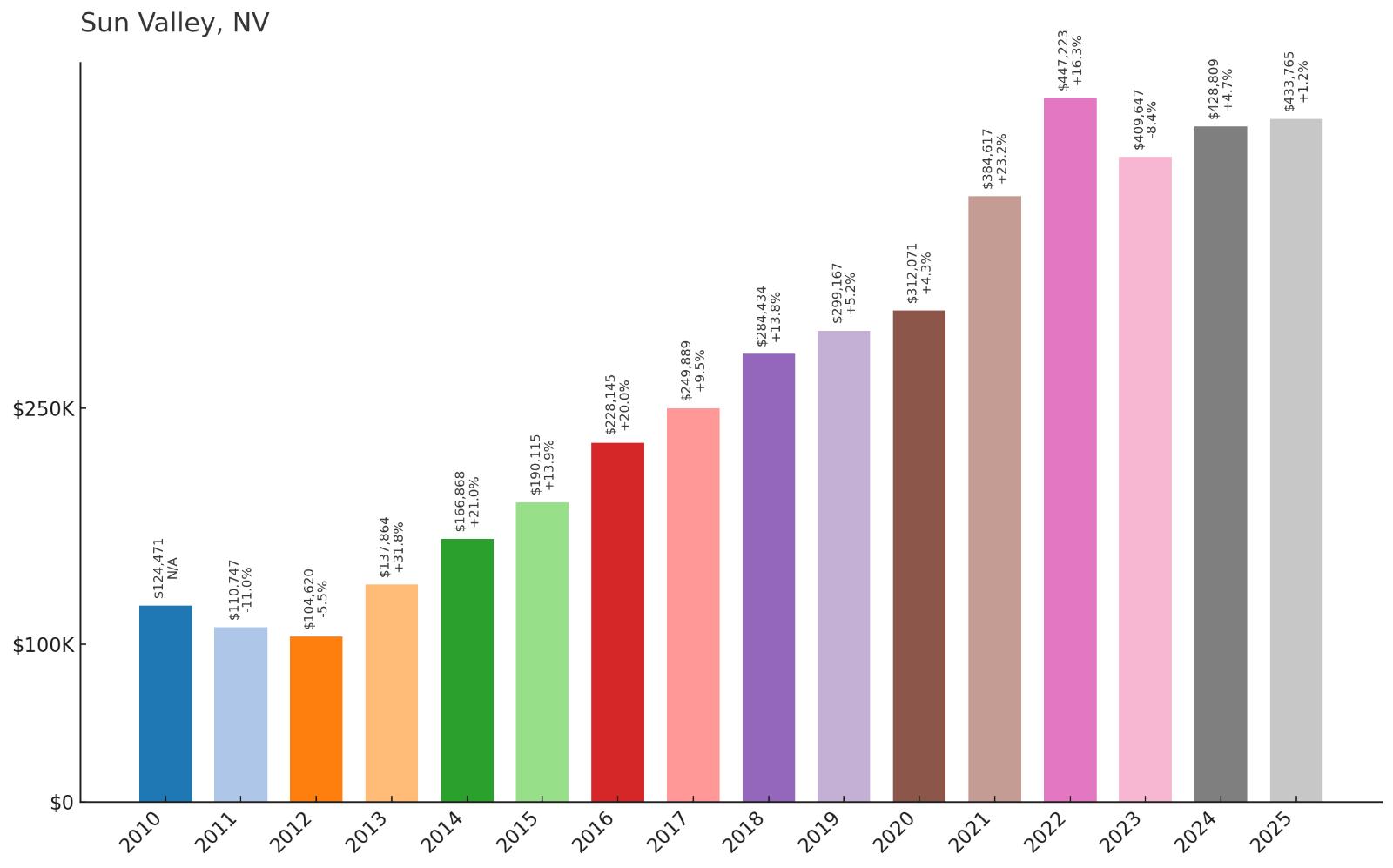
- 2010: $124,471
- 2011: $110,747
- 2012: $104,620
- 2013: $137,864
- 2014: $166,868
- 2015: $190,115
- 2016: $228,145
- 2017: $249,889
- 2018: $284,434
- 2019: $299,167
- 2020: $312,071
- 2021: $384,617
- 2022: $447,223
- 2023: $409,647
- 2024: $428,809
- 2025: $433,765
Sun Valley has experienced remarkable growth, with home values increasing 248.5% since 2010 to reach $433,765. The community showed strong recovery from recession lows, with particularly impressive gains after 2015 as Reno area expansion brought new attention to this previously overlooked area. Despite some volatility, the long-term trend reflects growing recognition of the area’s value proposition.
Why Sun Valley?

Why are people willing to pay so much to live here? What’s special about it?
Sun Valley attracts buyers seeking affordable access to the Reno metropolitan area with mountain views and outdoor recreation opportunities. The community offers larger lots, horse-friendly zoning, and rural character while maintaining reasonable commute times to Reno employment centers. Residents appreciate the small-town feel, tight-knit community, and authentic Nevada lifestyle that combines desert and mountain environments.
Unlike developed Reno suburbs, Sun Valley retains its rural character with unpaved roads, agricultural uses, and wide-open spaces that appeal to those seeking escape from suburban uniformity. The area provides affordable homeownership opportunities for families priced out of central Reno while offering superior outdoor access and community connection. Natural beauty and recreational access enhance the lifestyle appeal.
How Sun Valley Rose to Prominence
Sun Valley developed as an unincorporated community north of Reno beginning in the 1960s, initially attracting residents seeking affordable rural living near the city. The area remained largely agricultural and residential with limited commercial development, creating a country atmosphere that appealed to those wanting space and privacy. Early residents included retirees, horse enthusiasts, and families seeking alternatives to urban living.
Growth accelerated as Reno expanded and housing costs rose, pushing buyers to seek value in outlying areas like Sun Valley. The community’s proximity to Reno employment centers combined with rural zoning that allows horses and other animals created unique appeal for those seeking suburban-rural lifestyle. Recent appreciation reflects broader Reno area housing demand and recognition of Sun Valley’s lifestyle benefits.
3 Interesting Tidbits
1. Wild Horse Territory – Sun Valley is home to several wild horse herds that roam the surrounding desert ranges, creating unique wildlife viewing opportunities for residents.
2. Pyramid Lake Access – The community provides convenient access to Pyramid Lake, one of Nevada’s most beautiful and ecologically important lakes, popular for fishing and recreation.
3. Rural Roads – Many Sun Valley roads remain unpaved by design, maintaining the area’s rural character and keeping development pressure manageable for longtime residents.
20. Las Vegas – 215.2% Home Price Increase Since 2010
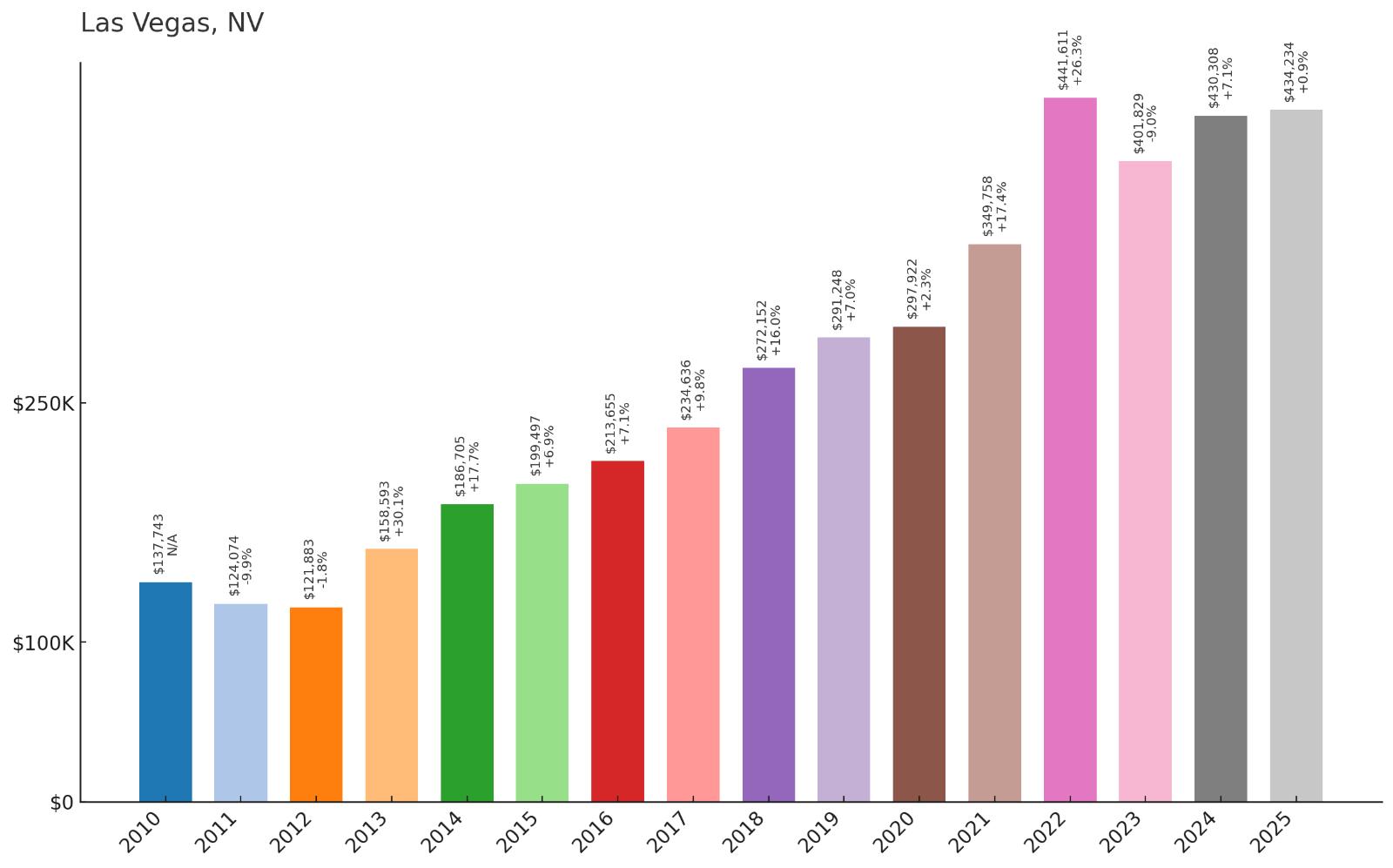
- 2010: $137,743
- 2011: $124,074
- 2012: $121,883
- 2013: $158,593
- 2014: $186,705
- 2015: $199,497
- 2016: $213,655
- 2017: $234,636
- 2018: $272,152
- 2019: $291,248
- 2020: $297,922
- 2021: $349,758
- 2022: $441,611
- 2023: $401,829
- 2024: $430,308
- 2025: $434,234
Las Vegas has more than tripled its home values since 2010, reaching $434,234 in 2025 after a remarkable 215.2% increase. The city showed strong recovery from recession lows, with sustained growth that peaked during the pandemic housing boom. Recent stabilization around $430,000-$440,000 reflects market adjustment while maintaining substantial long-term gains that demonstrate the area’s enduring appeal.
Why Las Vegas?
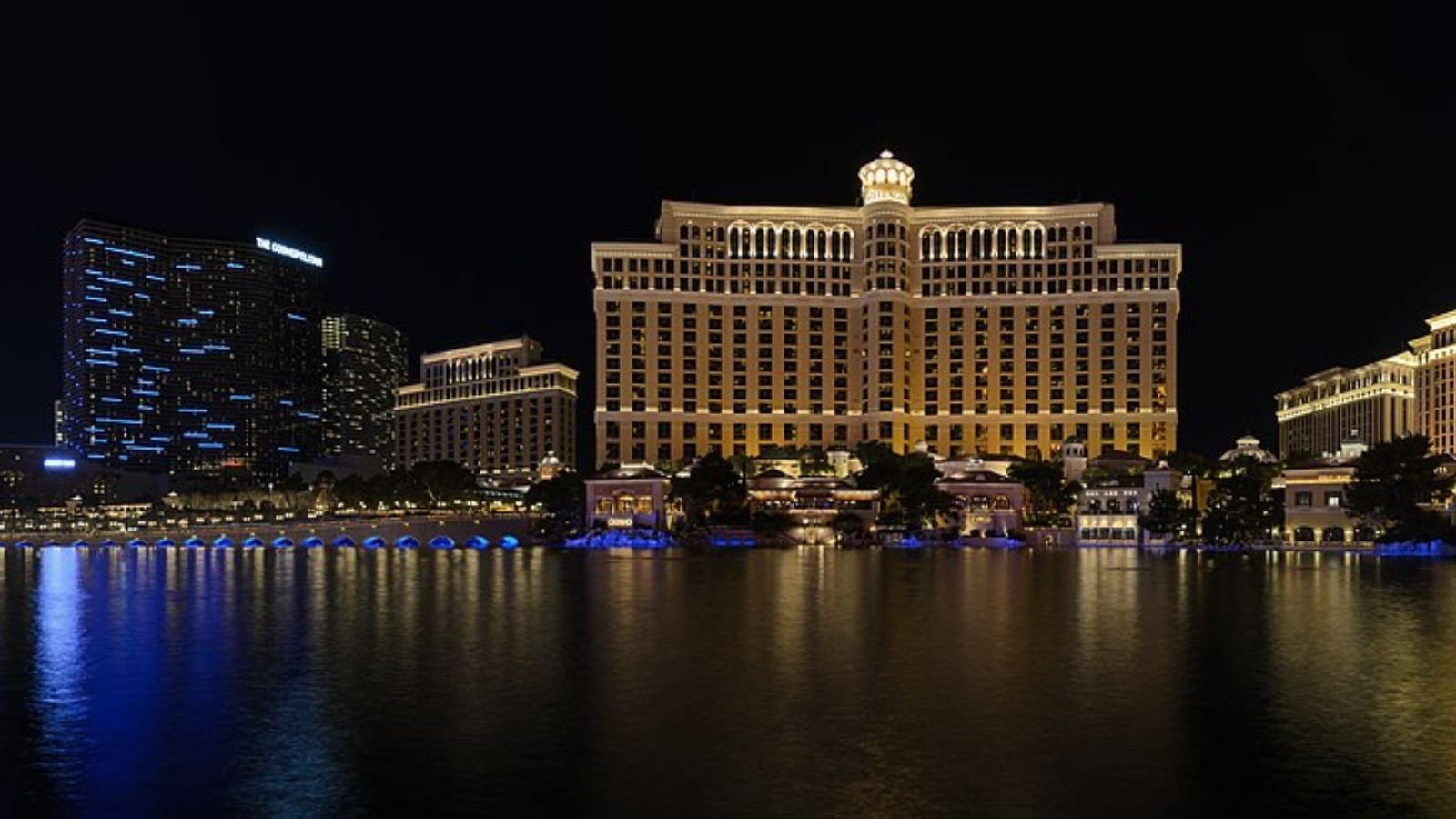
Why are people willing to pay so much to live here? What’s special about it?
Las Vegas attracts residents with its entertainment capital status, favorable tax environment, and year-round outdoor recreation opportunities. Families appreciate the diverse job market, modern amenities, and cultural attractions while enjoying no state income tax and relatively affordable housing compared to California. The city offers urban convenience with nearby natural beauty including Red Rock Canyon and Lake Mead recreational areas.
Unlike other major cities, Las Vegas combines metropolitan amenities with unique entertainment industry culture and desert lifestyle advantages. The area provides excellent dining, shopping, and cultural experiences while maintaining lower living costs than comparable West Coast cities. Strong job growth in technology, healthcare, and service industries creates economic diversity beyond tourism and gaming.
How Las Vegas Rose to Prominence
Las Vegas was founded in 1905 when the San Pedro, Los Angeles & Salt Lake Railroad established a division point in the valley, with the name meaning “the meadows” in Spanish due to natural springs that supported vegetation. Early growth came from railroad workers and nearby mining operations, but the community remained small until the 1930s when Hoover Dam construction brought thousands of workers and federal investment to the region.
The modern city emerged after Nevada legalized gambling in 1931 and entrepreneurs like Bugsy Siegel built lavish casino resorts on the Strip during the 1940s. Tourism and entertainment industries drove explosive growth through the latter 20th century, while recent decades have seen economic diversification into technology, healthcare, and professional services. California migration and favorable business climate continue fueling population and housing demand growth.
3 Interesting Tidbits
1. Entertainment Capital – Las Vegas hosts more major conventions, trade shows, and entertainment events than any other American city, supporting a massive hospitality and service economy.
2. Fastest Growing – From 1990 to 2000, Las Vegas was America’s fastest-growing major metropolitan area, with population growth that continues today at above-national rates.
3. Water Innovation – Despite desert location, Las Vegas has become a leader in water conservation and recycling, returning nearly all indoor water use back to Lake Mead through advanced treatment systems.
19. Moapa – 148.6% Home Price Increase Since 2010
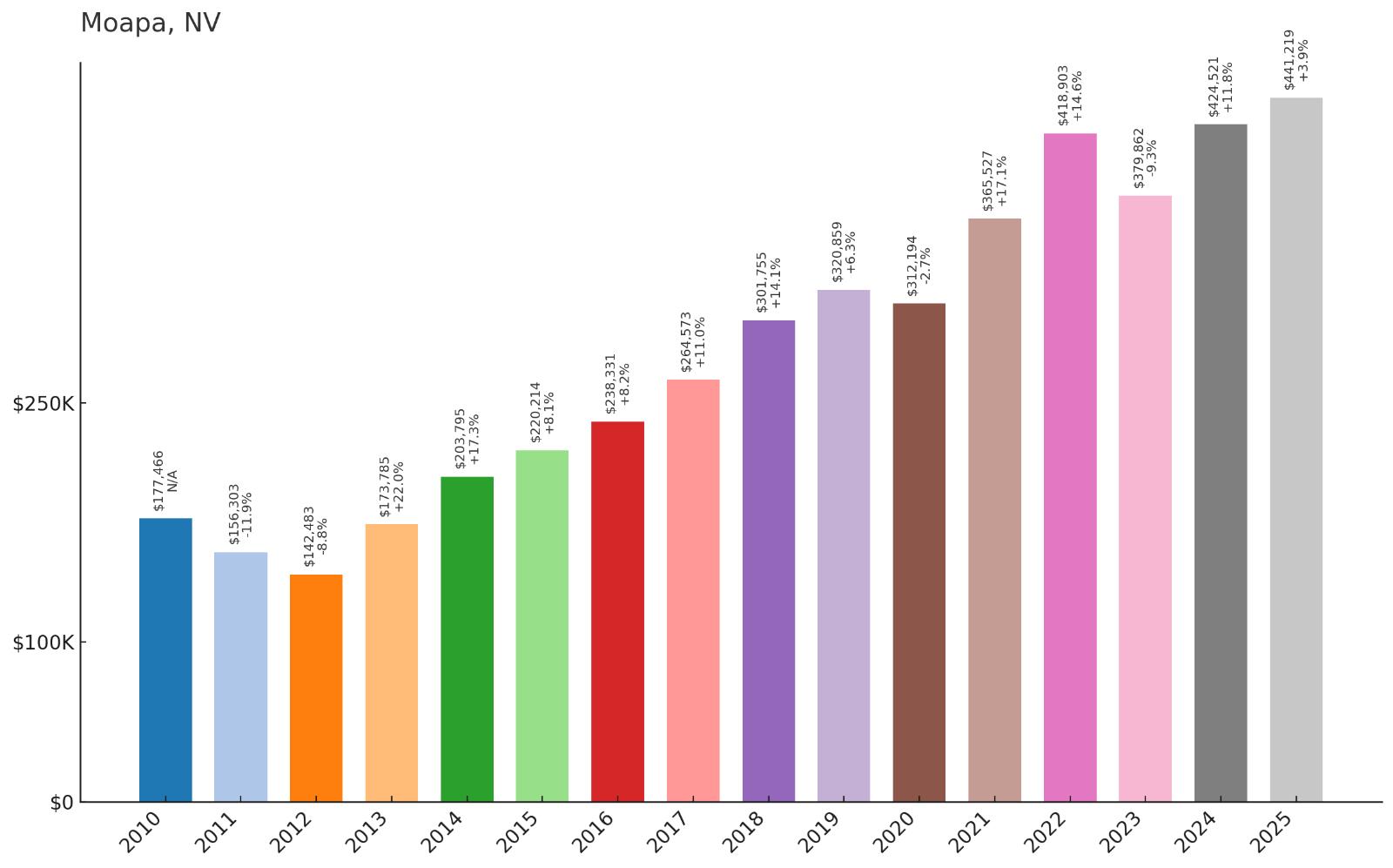
- 2010: $177,466
- 2011: $156,303
- 2012: $142,483
- 2013: $173,785
- 2014: $203,795
- 2015: $220,214
- 2016: $238,331
- 2017: $264,573
- 2018: $301,755
- 2019: $320,859
- 2020: $312,194
- 2021: $365,527
- 2022: $418,903
- 2023: $379,862
- 2024: $424,521
- 2025: $441,219
Moapa has achieved solid growth with home values reaching $441,219, representing a 148.6% increase since 2010. The community recovered well from early 2010s lows and showed consistent appreciation through most of the period. This small southern Nevada community has demonstrated surprising resilience and growth despite its rural location and agricultural heritage.
Why Moapa?

Why are people willing to pay so much to live here? What’s special about it?
Moapa attracts buyers seeking rural tranquility with natural hot springs, agricultural heritage, and proximity to outdoor recreation areas. The community offers authentic small-town living where residents know their neighbors, combined with larger properties that support hobby farming, horses, and outdoor activities. Natural hot springs and the nearby Moapa River create unique recreational opportunities in the Mojave Desert setting.
Unlike developed Nevada communities, Moapa maintains its agricultural character with working farms, ranches, and rural zoning that preserves open space and traditional land uses. The area provides escape from urban pressures while maintaining reasonable access to Las Vegas amenities and employment. Natural beauty, outdoor recreation access, and community connection appeal to those seeking authentic rural Nevada lifestyle.
How Moapa Rose to Prominence
Moapa was established in the 1860s by Mormon pioneers who were attracted to the area’s natural hot springs and the Muddy River, which provided reliable water for agriculture in the harsh desert environment. The name “Moapa” comes from the Southern Paiute word meaning “muddy water,” referring to the river that made settlement possible. Early settlers developed farms and ranches that took advantage of the warm springs for irrigation and year-round growing seasons.
The community remained largely agricultural through the 20th century, with alfalfa, cotton, and livestock forming the economic base. Population growth accelerated as Las Vegas expanded and people sought rural alternatives with larger properties and agricultural lifestyle opportunities. The area’s natural hot springs, now developed into resorts and spas, have become tourist attractions that complement the traditional farming economy.
3 Interesting Tidbits
1. Natural Hot Springs – Moapa is home to several natural hot springs that maintain constant temperatures year-round and have been developed into spa resorts and recreational facilities.
2. Warm Water Farming – The warm springs water allows year-round agriculture in the desert, making Moapa one of Nevada’s most productive farming areas despite harsh climate conditions.
3. Ancient Waters – The Muddy River system that flows through Moapa contains some of the oldest water in North America, with radiocarbon dating showing water sources thousands of years old.
18. Dayton – 207.0% Home Price Increase Since 2010
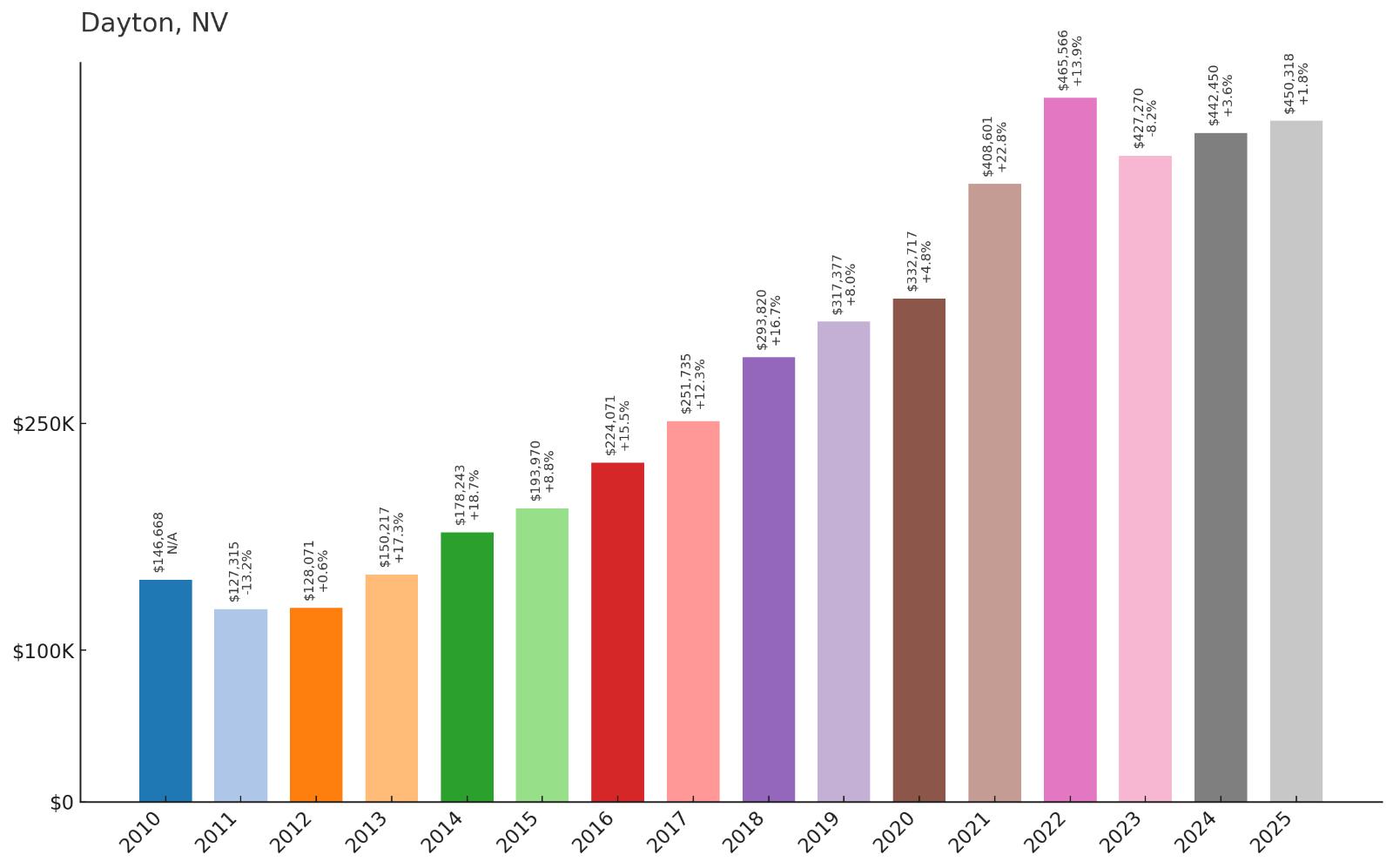
- 2010: $146,668
- 2011: $127,315
- 2012: $128,071
- 2013: $150,217
- 2014: $178,243
- 2015: $193,970
- 2016: $224,071
- 2017: $251,735
- 2018: $293,820
- 2019: $317,377
- 2020: $332,717
- 2021: $408,601
- 2022: $465,566
- 2023: $427,270
- 2024: $442,450
- 2025: $450,318
Dayton has achieved impressive growth with home values reaching $450,318, more than tripling since 2010 with a 207.0% increase. The community showed remarkable recovery from recession lows and sustained growth that accelerated significantly after 2016. This historic Nevada town has successfully balanced preservation of its heritage character with modern residential development that appeals to contemporary buyers.
Why Dayton?
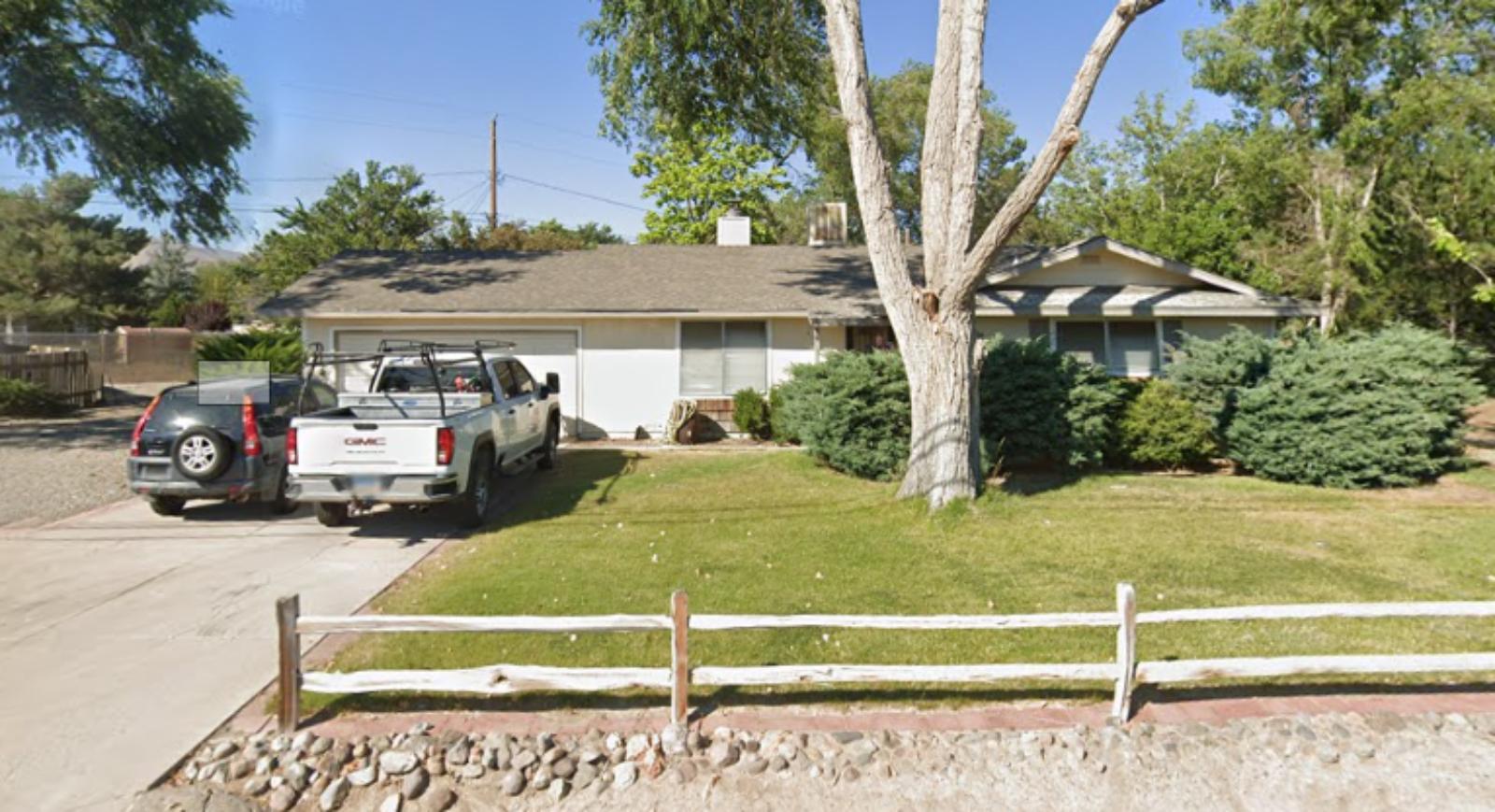
Why are people willing to pay so much to live here? What’s special about it?
Dayton attracts residents with its rich history, small-town character, and proximity to both Reno and Carson City employment centers. Families appreciate the area’s excellent schools, safe neighborhoods, and community events while enjoying larger lots and rural atmosphere not available in urban areas. The Carson River provides recreational opportunities and natural beauty that enhance the lifestyle appeal of this historic community.
Unlike newer Nevada developments, Dayton offers authentic Western heritage with preserved historic buildings, museums, and cultural sites that connect residents to Nevada’s mining and pioneer past. The community maintains small-town values and neighborly atmosphere while providing modern amenities and suburban conveniences. Balance of history and progress creates unique appeal for families seeking roots in Nevada tradition.
How Dayton Rose to Prominence
Dayton holds the distinction of being Nevada’s first permanent settlement, established in 1849 by Mormon pioneers and California Gold Rush travelers who found placer gold in the Carson River. Originally called “Nevada City,” the town became a supply center for nearby mining operations and served as Lyon County’s first seat of government. The Comstock Lode discovery brought boom times as Dayton became a milling center processing ore from Virginia City mines.
After the mining boom ended, Dayton remained a small agricultural and ranching community for over a century, preserving much of its 19th-century character. Modern growth began in the 1990s as Carson City and Reno expanded, attracting residents seeking historic charm with contemporary conveniences. Recent development has carefully balanced growth with historic preservation, creating an appealing community that honors its heritage while meeting modern needs.
3 Interesting Tidbits
1. Nevada’s First – Dayton was Nevada’s first permanent settlement and served as the territory’s first county seat, making it the birthplace of Nevada government and civilization.
2. Gold Rush Heritage – The discovery of gold in Dayton’s Gold Canyon in 1849 sparked Nevada’s first gold rush and led to the discovery of the famous Comstock Lode silver deposits.
3. Historic Cemetery – Dayton Cemetery, established in 1851, contains graves of Nevada’s earliest pioneers and remains an active cemetery connecting past and present residents.
17. Boulder City – 105.0% Home Price Increase Since 2010
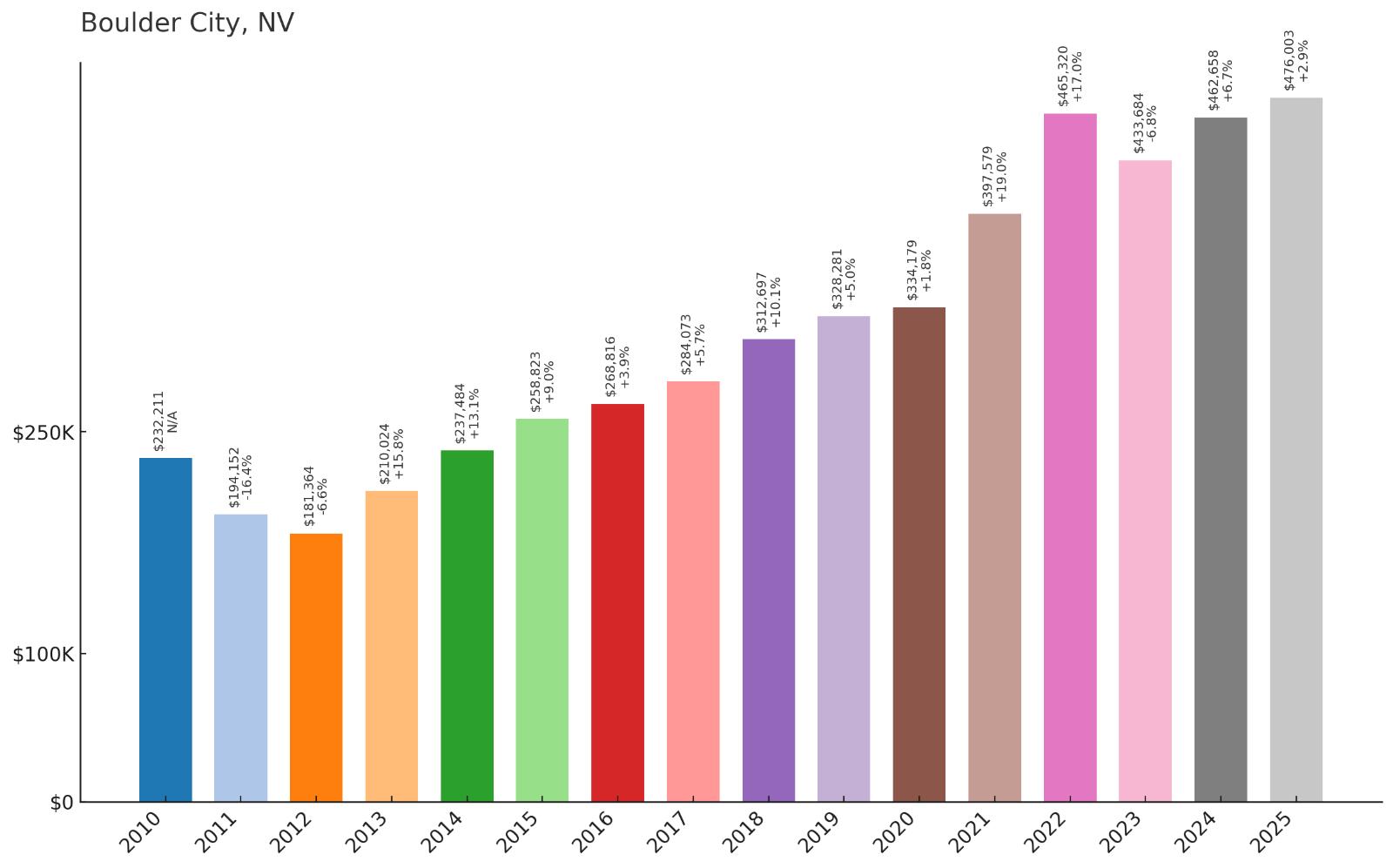
- 2010: $232,211
- 2011: $194,152
- 2012: $181,364
- 2013: $210,024
- 2014: $237,484
- 2015: $258,823
- 2016: $268,816
- 2017: $284,073
- 2018: $312,697
- 2019: $328,281
- 2020: $334,179
- 2021: $397,579
- 2022: $465,320
- 2023: $433,684
- 2024: $462,658
- 2025: $476,003
Boulder City has doubled its home values since 2010, reaching $476,003 with a solid 105.0% increase over the period. The community showed steady appreciation with acceleration during recent years, reflecting its unique position as Nevada’s only city that prohibits gambling. This distinctive character combined with proximity to Lake Mead has supported consistent demand and property value growth.
Why Boulder City?

Why are people willing to pay so much to live here? What’s special about it?
Boulder City attracts residents seeking family-friendly community atmosphere without the gambling culture that defines most Nevada cities. Families appreciate the excellent schools, safe neighborhoods, and historic charm while enjoying access to Lake Mead recreation and proximity to Las Vegas employment. The city’s unique prohibition on gambling creates a distinctive community character that appeals to those seeking traditional small-town values.
Unlike typical Nevada communities, Boulder City maintains strict development controls and architectural standards that preserve its historic character and planned community feel. The area offers outdoor recreation paradise with Lake Mead, hiking trails, and desert beauty while maintaining suburban amenities and services. Small-town atmosphere combined with recreational access creates appeal for families and retirees seeking quality of life.
How Boulder City Rose to Prominence
Boulder City was created by the federal government in 1931 as a model company town to house workers building Hoover Dam. The Bureau of Reclamation planned every aspect of the community, from architectural styles to recreational facilities, creating one of America’s last complete company towns. The city’s founders prohibited alcohol and gambling to maintain focus on the massive construction project and family-friendly environment.
After Hoover Dam’s completion in 1936, Boulder City survived the end of construction by diversifying its economy and maintaining its unique character. The city incorporated in 1960 and retained its gambling prohibition, making it Nevada’s only municipality without casinos. This distinctive identity, combined with Lake Mead recreation and historic preservation efforts, has attracted residents seeking alternatives to typical Nevada lifestyle while remaining close to Las Vegas opportunities.
3 Interesting Tidbits
1. No Gambling Zone – Boulder City is the only incorporated city in Nevada where gambling is prohibited, creating a unique family-oriented community atmosphere in the Silver State.
2. Hoover Dam Legacy – The city was specifically built to house Hoover Dam construction workers and remains one of America’s best-preserved examples of 1930s planned community design.
3. Lake Mead Gateway – Boulder City serves as the primary gateway to Lake Mead National Recreation Area, America’s first national recreation area and one of its largest man-made lakes.
16. Carson City – 187.1% Home Price Increase Since 2010
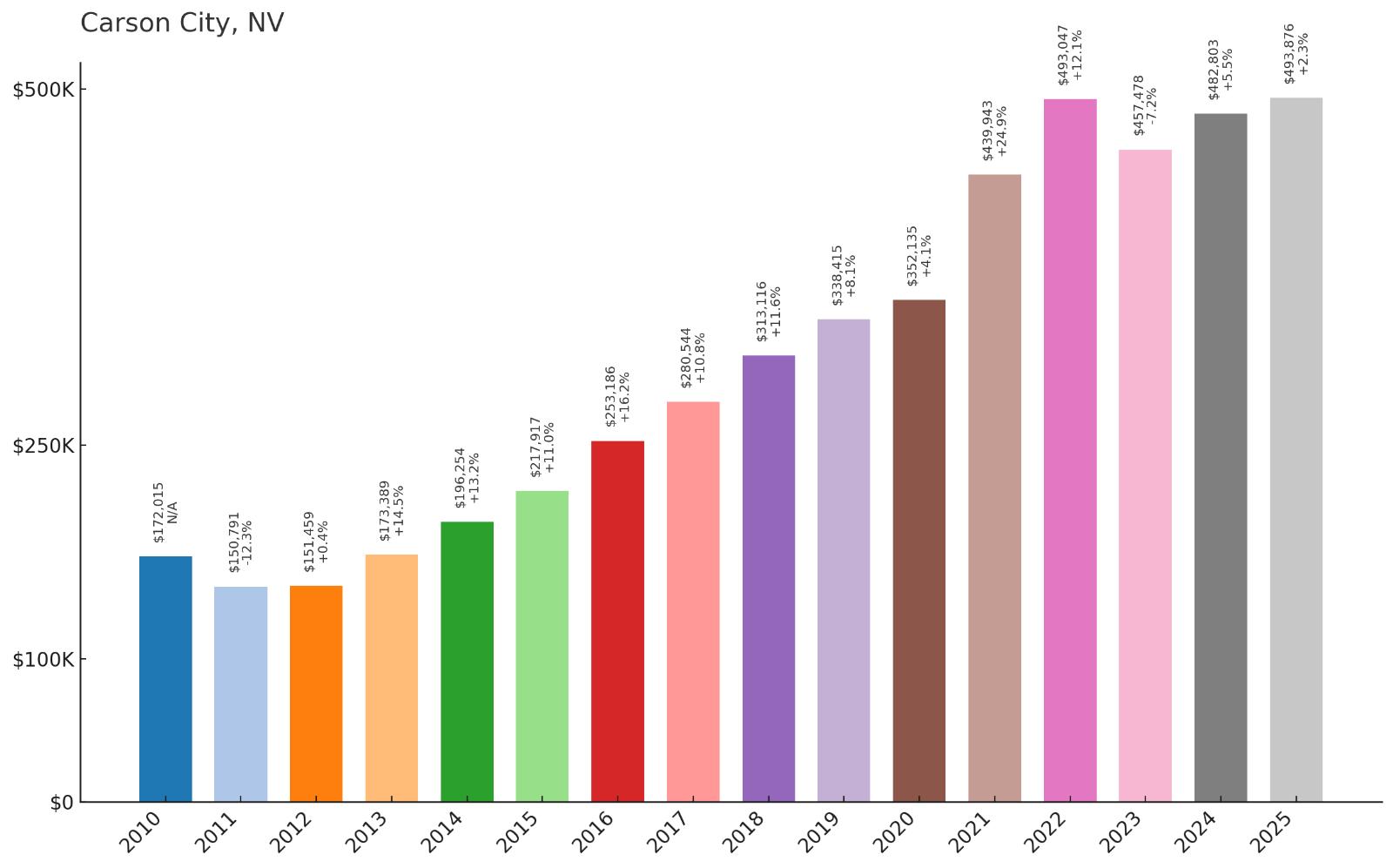
- 2010: $172,015
- 2011: $150,791
- 2012: $151,459
- 2013: $173,389
- 2014: $196,254
- 2015: $217,917
- 2016: $253,186
- 2017: $280,544
- 2018: $313,116
- 2019: $338,415
- 2020: $352,135
- 2021: $439,943
- 2022: $493,047
- 2023: $457,478
- 2024: $482,803
- 2025: $493,876
Carson City has achieved strong growth with home values reaching $493,876, representing a 187.1% increase since 2010. The state capital showed consistent appreciation throughout the period with notable acceleration after 2015 as government stability and regional growth drove demand. Recent values approaching $500,000 reflect the community’s appeal as both a government center and gateway to Lake Tahoe recreation.
Why Carson City?
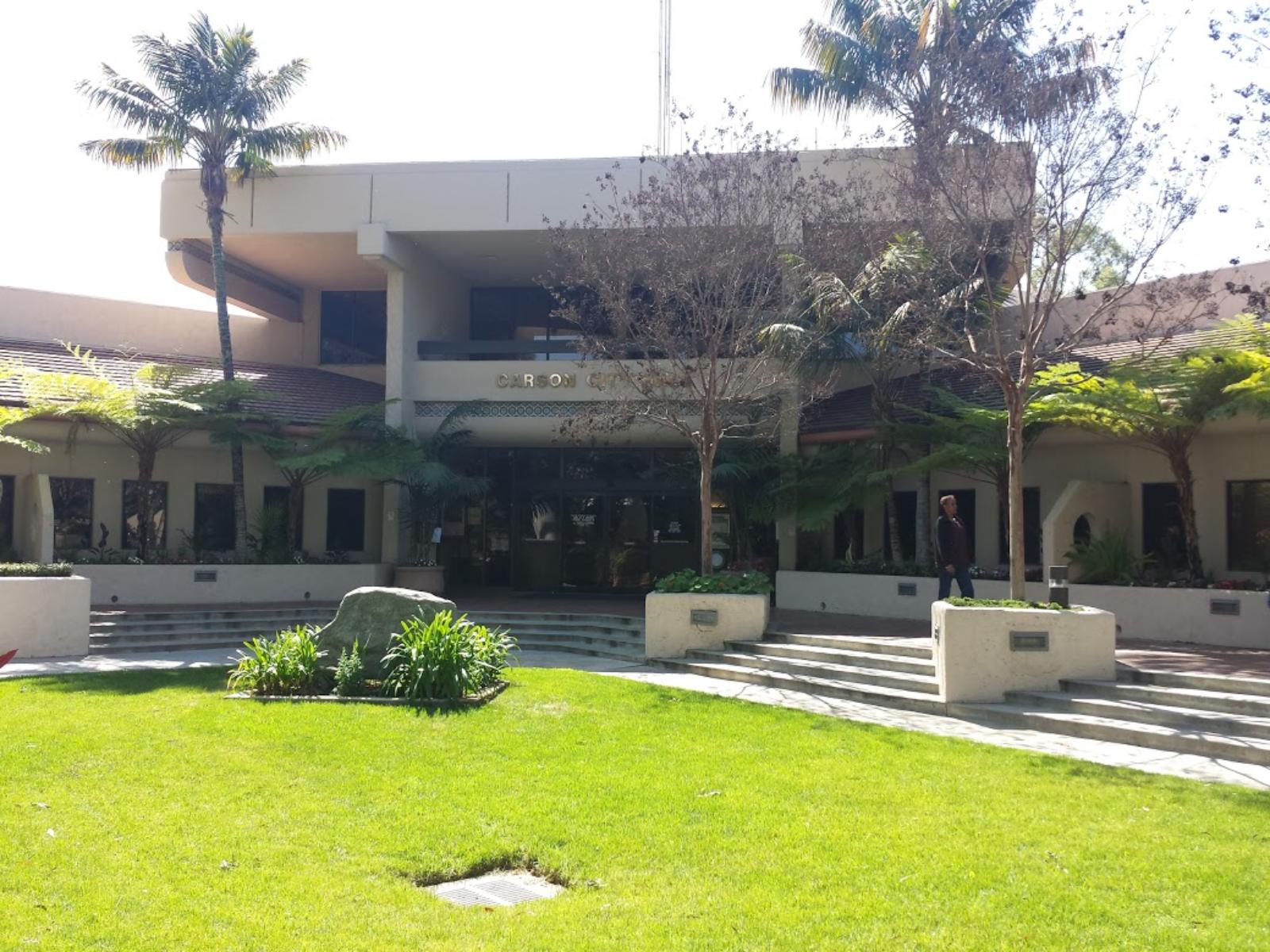
Why are people willing to pay so much to live here? What’s special about it?
Carson City attracts residents with stable government employment, historic charm, and proximity to both Lake Tahoe recreation and Reno metropolitan amenities. Families appreciate the small capital city atmosphere, good schools, and community events while enjoying outdoor recreation access that includes skiing, hiking, and lake activities. The area offers authentic Nevada history with modern conveniences and economic stability unusual in rural Western communities.
Unlike larger cities, Carson City provides intimate community feel where residents can participate in local government and community activities while enjoying capital city cultural amenities. The combination of stable government employment, historic preservation, and recreational access creates unique lifestyle advantages. Lake Tahoe proximity and Sierra Nevada beauty enhance the area’s appeal for outdoor enthusiasts and retirees alike.
How Carson City Rose to Prominence
Carson City was founded in 1858 and named for mountain man Kit Carson, becoming Nevada’s territorial capital in 1861 when the Nevada Territory was created. The discovery of the Comstock Lode silver deposits nearby brought wealth and importance to the small community, which was strategically located between California and the mining regions. When Nevada achieved statehood in 1864, Carson City remained the capital despite its small size.
The city’s prominence grew with the Virginia & Truckee Railroad, which connected Carson City to Virginia City mines and California markets, bringing prosperity and permanent institutions. Government employment provided economic stability when mining declined, while the city maintained its role as Nevada’s political center. Modern growth reflects the appeal of capital city amenities, outdoor recreation access, and proximity to both Lake Tahoe and Reno opportunities.
3 Interesting Tidbits
1. Smallest Capital – Carson City is one of America’s smallest state capitals by population, creating an intimate government atmosphere where citizens can actively participate in state affairs.
2. Historic Railroad – The Virginia & Truckee Railroad, one of the West’s most famous short lines, connected Carson City to the Comstock mines and continues operating today as a heritage railway.
3. Mint Legacy – Carson City hosted a U.S. Mint from 1870 to 1893, producing silver coins marked with “CC” that are now highly sought after by collectors worldwide.
15. Henderson – 169.3% Home Price Increase Since 2010

- 2010: $183,675
- 2011: $165,018
- 2012: $160,529
- 2013: $199,375
- 2014: $234,306
- 2015: $251,942
- 2016: $266,305
- 2017: $284,457
- 2018: $319,809
- 2019: $338,616
- 2020: $349,205
- 2021: $409,740
- 2022: $504,697
- 2023: $461,475
- 2024: $489,166
- 2025: $494,576
Henderson has achieved strong growth with home values reaching $494,576, representing a 169.3% increase since 2010. Nevada’s second-largest city showed consistent appreciation with notable acceleration after 2017 as its master-planned communities and family-friendly reputation attracted buyers. The community has successfully maintained premium market position within Las Vegas Valley while offering suburban amenities and excellent quality of life.
Why Henderson?
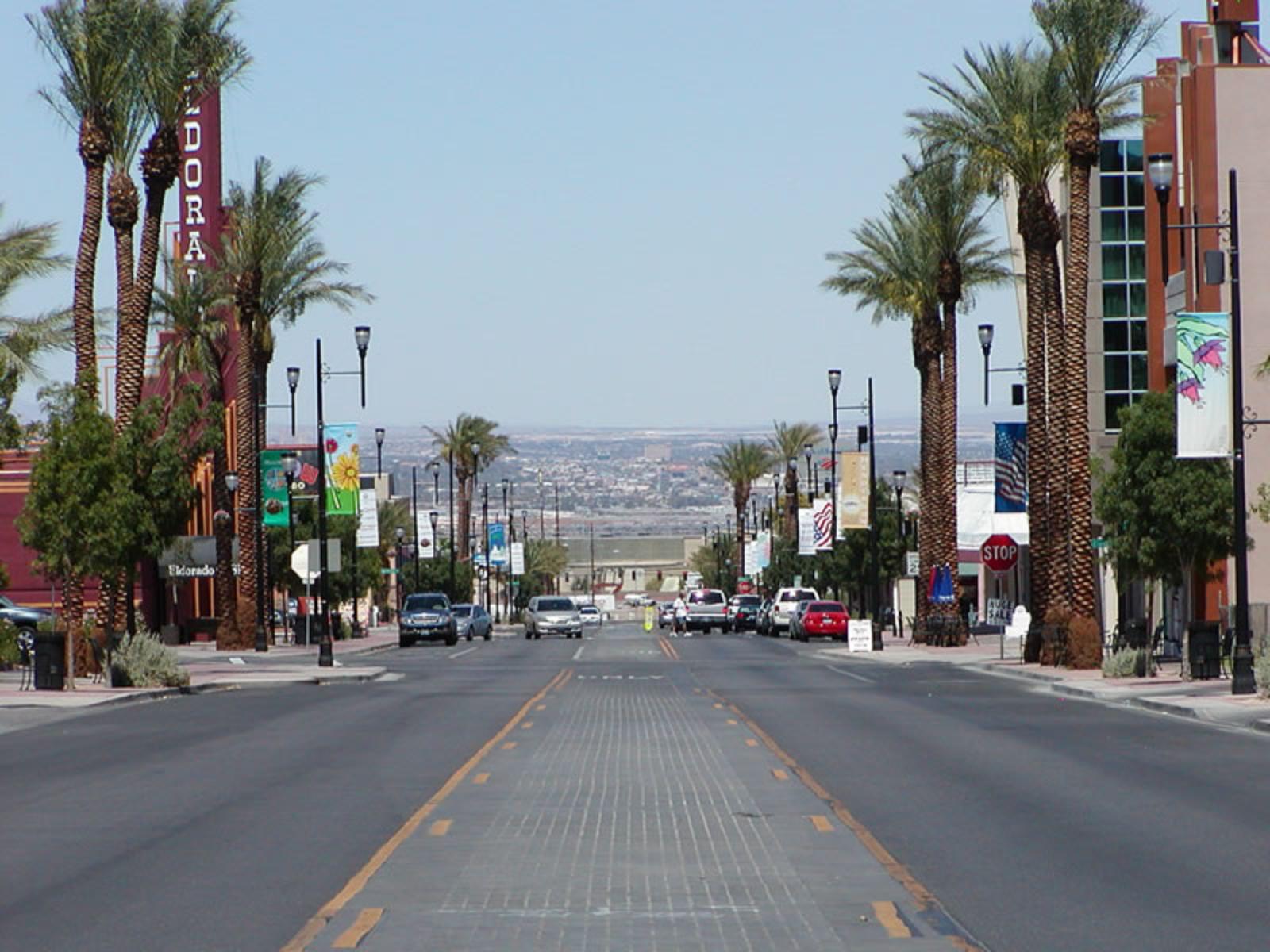
Why are people willing to pay so much to live here? What’s special about it?
Henderson attracts families with its reputation as one of America’s safest cities, excellent schools, and master-planned communities that offer resort-style amenities. Residents appreciate the suburban atmosphere, well-maintained neighborhoods, and extensive parks and recreation facilities while maintaining proximity to Las Vegas employment and entertainment. The city provides family-oriented lifestyle with higher property values that reflect superior quality of life and municipal services.
Unlike central Las Vegas, Henderson offers planned community living with strict development standards, extensive green space, and suburban safety that appeals to families and professionals. The area features numerous master-planned communities with golf courses, trails, and community centers that create resort-like living environments. Strong municipal government and fiscal management support excellent services and infrastructure that justify premium housing costs.
How Henderson Rose to Prominence
Henderson was founded in 1943 as a company town to support the Basic Magnesium Plant, built to produce magnesium for World War II aircraft manufacturing. The federal government created the planned community to house thousands of defense workers, providing modern infrastructure and amenities unusual for wartime industrial towns. After the war, the city struggled economically until Las Vegas growth brought new opportunities and residents seeking suburban alternatives.
Modern Henderson emerged in the 1970s and 1980s with master-planned community development that attracted families seeking suburban lifestyle in Las Vegas Valley. Companies like American Nevada Corporation developed large-scale planned communities with amenities, parks, and services that established Henderson’s reputation for quality living. The city’s careful growth management and commitment to high development standards created premium residential areas that command higher property values.
3 Interesting Tidbits
1. Safest City – Henderson consistently ranks among America’s safest cities of its size, with low crime rates and excellent emergency services that attract families seeking security.
2. Master-Planned Capital – Henderson contains more master-planned communities than almost any other American city, with developments like Green Valley and Anthem setting national standards for suburban planning.
3. Magnesium Heritage – The city’s origin as a World War II magnesium production center is preserved in street names, historic sites, and the heritage museum that celebrates its defense industry roots.
14. Logandale – 144.9% Home Price Increase Since 2010
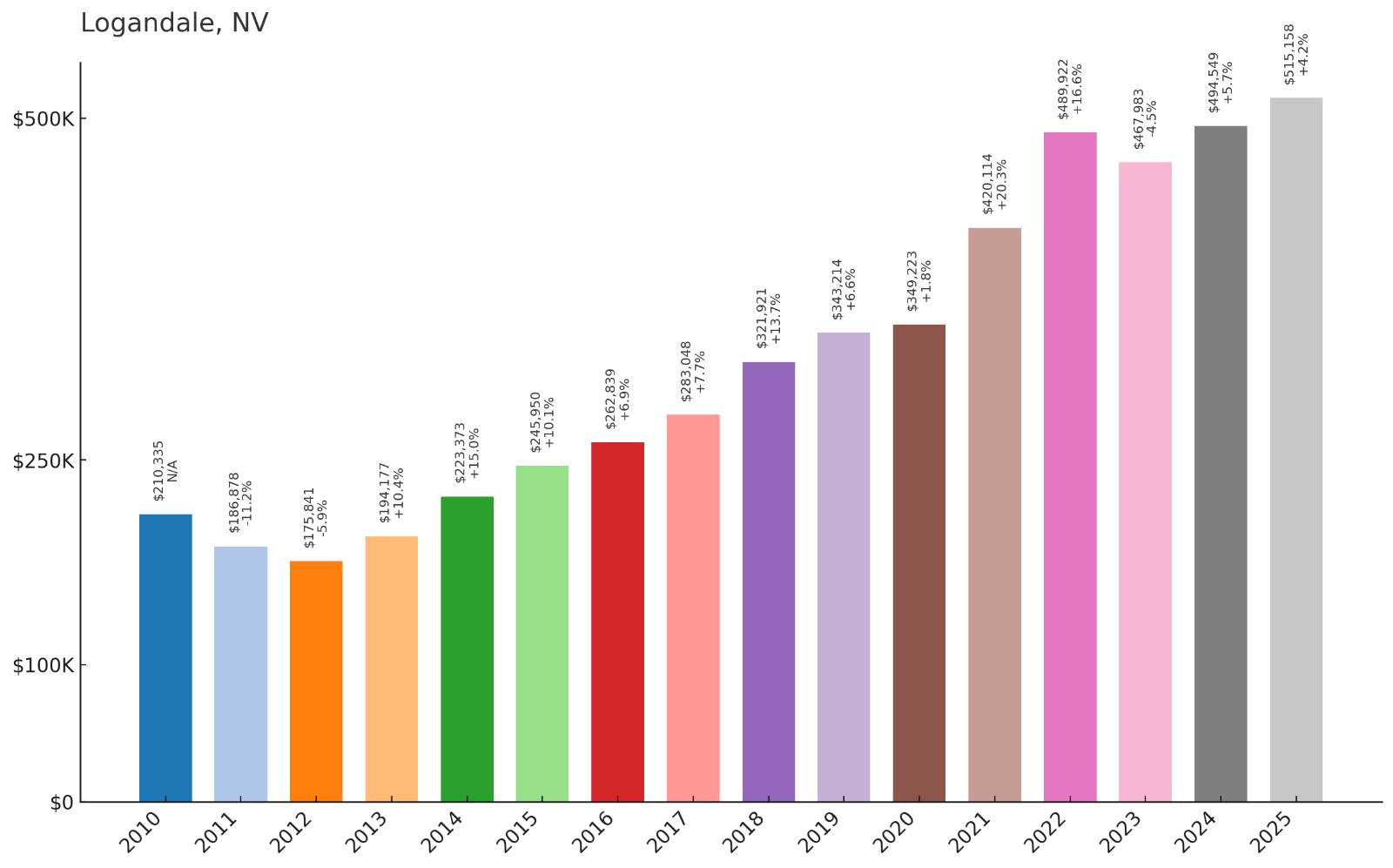
- 2010: $210,335
- 2011: $186,878
- 2012: $175,841
- 2013: $194,177
- 2014: $223,373
- 2015: $245,950
- 2016: $262,839
- 2017: $283,048
- 2018: $321,921
- 2019: $343,214
- 2020: $349,223
- 2021: $420,114
- 2022: $489,922
- 2023: $467,983
- 2024: $494,549
- 2025: $515,158
Logandale has achieved solid growth with home values reaching $515,158, representing a 144.9% increase since 2010. The community recovered from recession lows and showed consistent appreciation with notable acceleration after 2017. This small agricultural community has successfully balanced rural character with growing residential demand from buyers seeking authentic rural Nevada lifestyle.
Why Logandale?

Why are people willing to pay so much to live here? What’s special about it?
Logandale attracts buyers seeking agricultural lifestyle with horse-friendly properties, natural hot springs, and small-town community atmosphere. Residents appreciate the area’s farming heritage, larger lots for animals and gardens, and scenic desert mountain setting that provides privacy and rural tranquility. The community offers authentic Western lifestyle with modern conveniences and proximity to both Las Vegas and Utah recreational opportunities.
Unlike suburban Nevada communities, Logandale maintains working farms, ranches, and agricultural operations that create authentic rural character increasingly rare in the Southwest. The area provides escape from urban pressures while supporting horse ownership, farming pursuits, and outdoor recreation activities. Natural hot springs and agricultural heritage create unique lifestyle advantages for those seeking rural Nevada living.
How Logandale Rose to Prominence
Logandale was settled in the 1870s by Mormon pioneers who established farms along the Muddy River, taking advantage of natural hot springs and river water for irrigation in the harsh desert environment. The community was named for Ephraim Logan, an early settler who helped establish the agricultural foundation that continues today. Early residents grew cotton, grapes, and other crops using warm spring water that allowed year-round growing seasons.
The town remained primarily agricultural through most of the 20th century, with alfalfa, livestock, and specialty crops forming the economic base. Recent growth reflects increased interest in rural lifestyle, horse properties, and agricultural living as Las Vegas expansion pushed buyers to seek alternatives. The combination of agricultural heritage, natural amenities, and rural character has attracted new residents while preserving the community’s farming traditions.
3 Interesting Tidbits
1. Hot Spring Agriculture – Logandale’s natural hot springs provide warm water for irrigation, allowing year-round crop production and creating one of Nevada’s most productive agricultural areas.
2. Date Palm Capital – The community is home to Nevada’s largest date palm grove, with trees originally planted by early Mormon settlers that continue producing fruit over 140 years later.
3. Virgin Valley Opals – The nearby Virgin Valley produces some of the world’s finest black fire opals, making the area a destination for rockhounds and gem collectors from around the world.
13. Sparks – 189.0% Home Price Increase Since 2010

- 2010: $181,502
- 2011: $160,315
- 2012: $152,182
- 2013: $190,802
- 2014: $225,144
- 2015: $256,542
- 2016: $291,500
- 2017: $313,134
- 2018: $352,398
- 2019: $367,767
- 2020: $381,409
- 2021: $472,242
- 2022: $550,777
- 2023: $502,934
- 2024: $523,790
- 2025: $524,485
Sparks has achieved remarkable growth with home values reaching $524,485, representing a 189.0% increase since 2010. The city showed strong recovery from recession lows with consistent appreciation that accelerated significantly after 2015 as Reno-Sparks economic diversification attracted new residents. This transformation from railroad town to tech hub has driven substantial property value appreciation.
Why Sparks?

Why are people willing to pay so much to live here? What’s special about it?
Sparks attracts residents with its combination of small-town charm and proximity to Reno employment centers, offering family-friendly neighborhoods with excellent schools and recreational amenities. The community provides authentic Nevada character with historic downtown, community events, and Sierra Nevada mountain access while maintaining suburban conveniences. Residents appreciate the area’s economic growth, outdoor recreation opportunities, and strong sense of community identity.
Unlike larger Reno, Sparks maintains distinct community identity with hometown festivals, local businesses, and neighborhood feel that appeals to families seeking connection and community involvement. The city offers excellent value with newer housing developments, quality schools, and recreational facilities while providing easy access to Reno employment and cultural amenities. Balance of small-town character with metropolitan access creates unique lifestyle advantages.
How Sparks Rose to Prominence
Sparks was founded in 1904 as a railroad town when the Southern Pacific Railroad moved its shops and yards from Wadsworth to a new location east of Reno. The city was named for Nevada Governor John Sparks and quickly became a major transportation hub with extensive rail facilities and worker housing. For decades, Sparks remained primarily a blue-collar railroad community with strong union traditions and working-class character.
Economic transformation began in the 1980s and accelerated in the 2000s as technology companies and distribution centers chose the Reno-Sparks area for operations. Major employers like Tesla, Amazon, and various tech companies established facilities, bringing higher-paying jobs and attracting educated professionals. This economic diversification combined with quality of life improvements has driven population growth and property value appreciation while preserving community character.
3 Interesting Tidbits
1. Railroad Heritage – Sparks was built around one of the West’s largest railroad switching yards and maintains its transportation industry heritage with the annual Railroad Days festival and preserved historic facilities.
2. Nugget Casino – John Ascuaga’s Nugget was one of Nevada’s most famous family-owned casinos, serving as Sparks’ landmark and community gathering place for over 60 years until recent ownership changes.
3. Victorian Avenue – The historic downtown Victorian Avenue district preserves early 20th-century commercial architecture and serves as the heart of community celebrations and local business activity.
12. Wellington – 142.1% Home Price Increase Since 2010
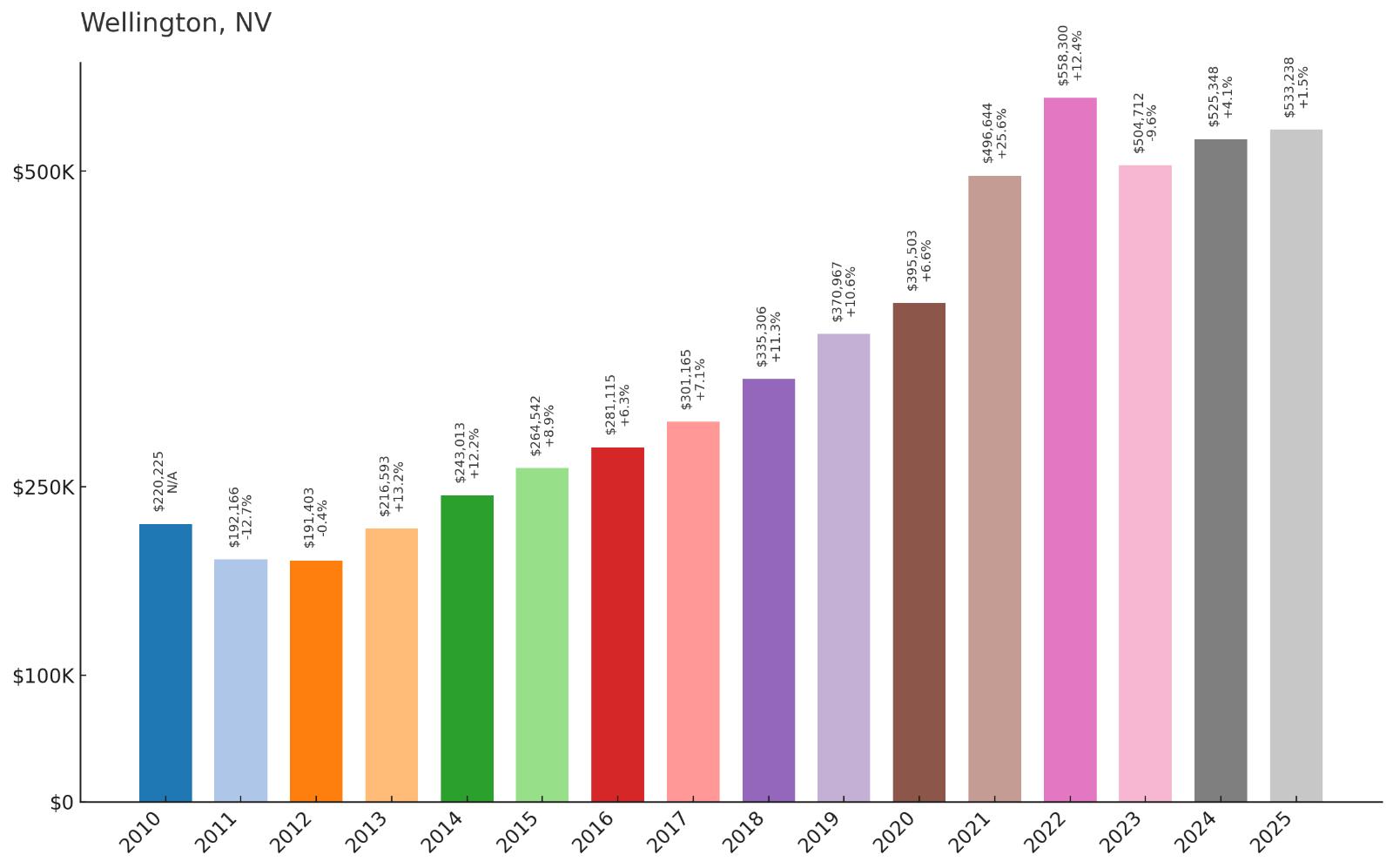
- 2010: $220,225
- 2011: $192,166
- 2012: $191,403
- 2013: $216,593
- 2014: $243,013
- 2015: $264,542
- 2016: $281,115
- 2017: $301,165
- 2018: $335,306
- 2019: $370,967
- 2020: $395,503
- 2021: $496,644
- 2022: $558,300
- 2023: $504,712
- 2024: $525,348
- 2025: $533,238
Wellington has achieved strong growth with home values reaching $533,238, representing a 142.1% increase since 2010. The community showed consistent appreciation with notable acceleration after 2018 as buyers discovered this small town’s charm and proximity to Carson Valley amenities. This agricultural community has successfully balanced rural character with residential growth that appeals to those seeking authentic ranch lifestyle.
Why Wellington?
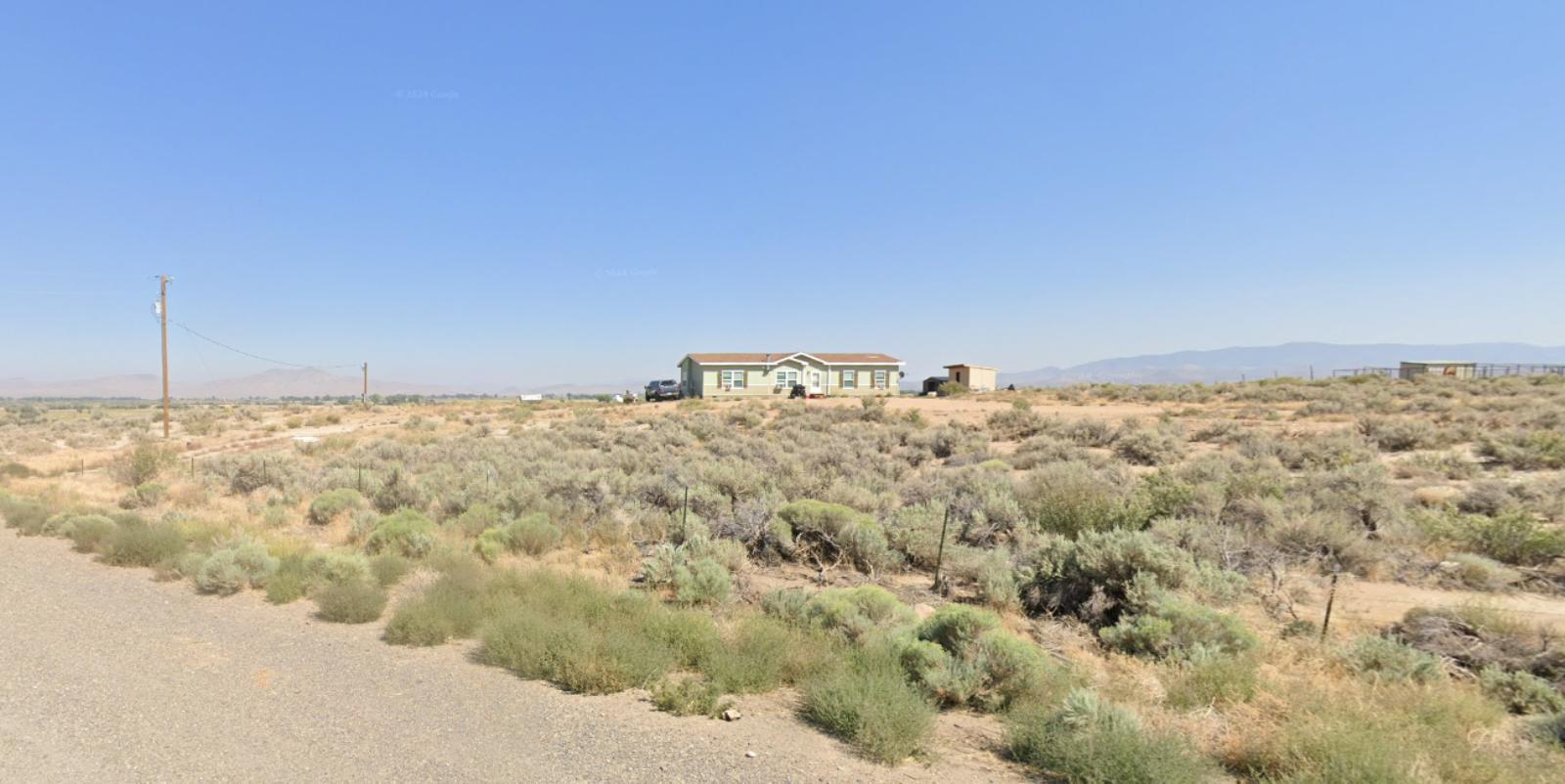
Why are people willing to pay so much to live here? What’s special about it?
Wellington attracts residents seeking authentic ranch lifestyle with working cattle operations, agricultural heritage, and stunning Sierra Nevada views. The community offers large properties suitable for horses and farming, combined with small-town atmosphere where neighbors help each other and traditional Western values remain strong. Rural character and agricultural opportunities appeal to those escaping suburban uniformity while maintaining access to Carson Valley amenities.
Unlike developed Nevada areas, Wellington maintains its agricultural identity with working ranches, hay fields, and cattle operations that create authentic Western atmosphere increasingly rare in the modern West. The area provides privacy, space, and rural lifestyle advantages while keeping reasonable access to Carson City, Reno, and Lake Tahoe recreational opportunities. Agricultural heritage and natural beauty enhance lifestyle appeal for rural living enthusiasts.
How Wellington Rose to Prominence
Wellington was established in the 1860s as a supply station along the freight route between California and the Comstock mining region, serving travelers and freight wagons crossing the Sierra Nevada. The area’s natural meadows and water sources made it ideal for ranching, and cattle operations began in the late 1800s when large spreads were established to supply beef to mining communities. Agricultural development continued as irrigation systems expanded farming possibilities.
The town remained primarily agricultural through the 20th century, with cattle ranching, hay production, and related activities forming the economic foundation. Recent growth reflects increased interest in rural lifestyle and agricultural properties as Carson Valley development pushed buyers seeking authentic ranch living. The community has preserved its agricultural character while attracting new residents who appreciate Western heritage and rural values.
3 Interesting Tidbits
1. Cattle Country – Wellington remains an active cattle ranching center with several large operations that have run cattle in the area for over 150 years, maintaining authentic Western heritage.
2. Freight Road Heritage – The community developed along one of the West’s major freight routes, where wagon trains carrying supplies to mining camps would stop for rest, supplies, and fresh animals.
3. Sierra Views – Wellington offers some of Nevada’s most spectacular Sierra Nevada mountain views, with the range rising dramatically from the valley floor to create stunning natural backdrops.
11. Reno – 187.9% Home Price Increase Since 2010
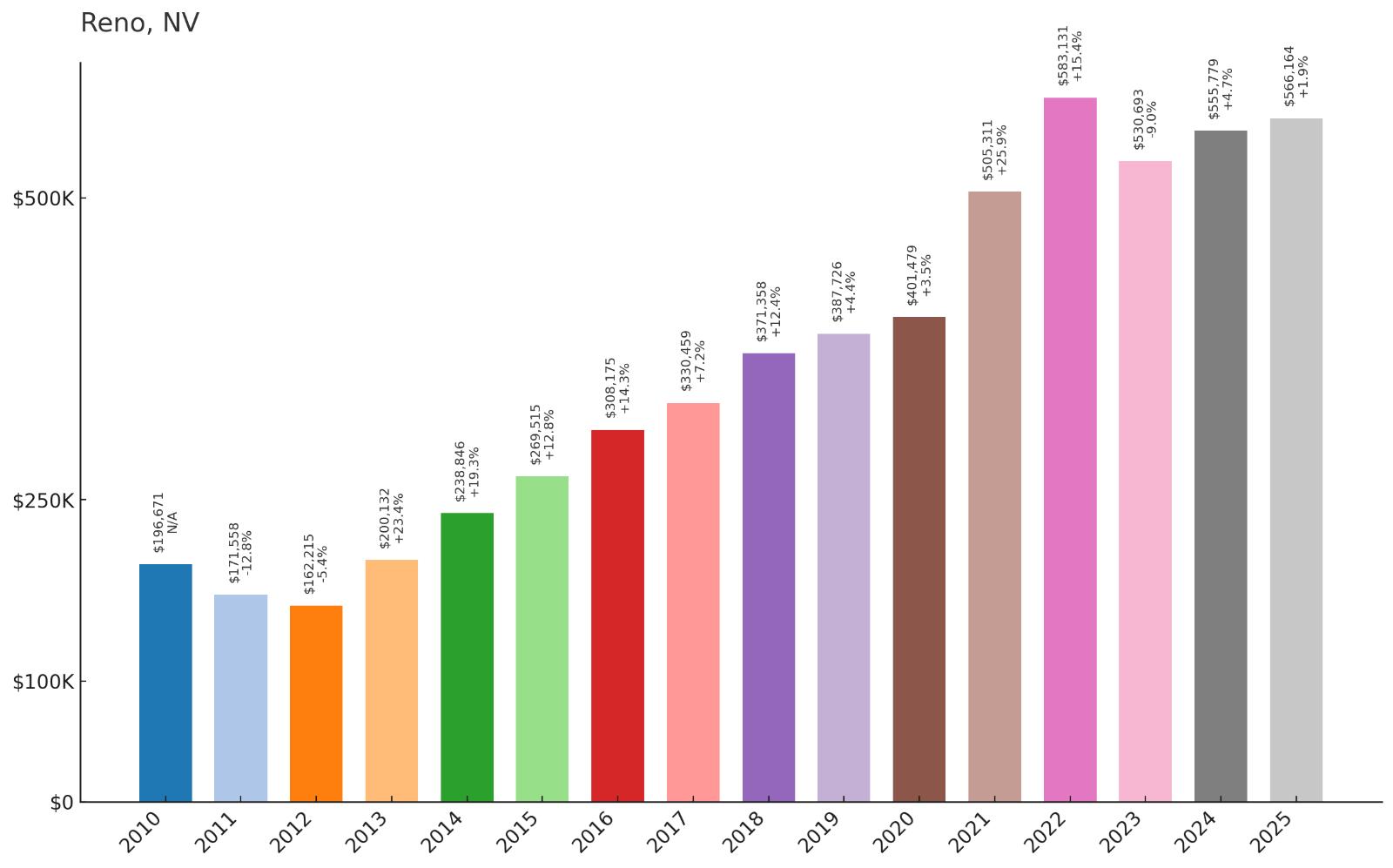
- 2010: $196,671
- 2011: $171,558
- 2012: $162,215
- 2013: $200,132
- 2014: $238,846
- 2015: $269,515
- 2016: $308,175
- 2017: $330,459
- 2018: $371,358
- 2019: $387,726
- 2020: $401,479
- 2021: $505,311
- 2022: $583,131
- 2023: $530,693
- 2024: $555,779
- 2025: $566,164
Reno has achieved impressive growth with home values reaching $566,164, representing a 187.9% increase since 2010. The “Biggest Little City in the World” showed strong recovery from recession lows with sustained appreciation that accelerated after 2015 as economic diversification attracted tech companies and new residents. This transformation from gaming-dependent economy to diverse tech hub has driven substantial property value appreciation.
Why Reno?

Why are people willing to pay so much to live here? What’s special about it?
Reno attracts residents with its combination of urban amenities and outdoor recreation access, offering four-season mountain lifestyle with no state income tax and business-friendly environment. Professionals appreciate the growing tech industry, cultural attractions, and university presence while enjoying world-class skiing, hiking, and lake activities within minutes of downtown. The city provides California refugees with familiar amenities at lower costs and better tax treatment.
Unlike typical Western cities, Reno offers unique combination of urban sophistication and outdoor adventure, with Lake Tahoe skiing just an hour away and desert recreation in all directions. The area’s economic diversification beyond gaming has created opportunities in technology, healthcare, and logistics while maintaining the entertainment and cultural amenities that make city living attractive. Progressive politics and environmental consciousness appeal to educated professionals seeking alternatives to expensive California markets.
How Reno Rose to Prominence
Reno was founded in 1868 when the Central Pacific Railroad built a bridge across the Truckee River and established a depot. The city was named for Civil War general Jesse Reno and grew as a transportation hub serving nearby mining regions and California-bound travelers. Early prosperity came from railroad operations, regional commerce, and proximity to Comstock Lode silver mines that brought wealth and population to the area.
The modern city emerged when Nevada legalized gambling in 1931 and divorce laws made Reno a destination for quick divorces, earning fame as a gaming and entertainment center. Recent decades have brought economic diversification as technology companies, logistics operations, and professional services have located in the area. The combination of business-friendly policies, outdoor recreation access, and quality of life continues attracting new residents and businesses to the region.
3 Interesting Tidbits
1. Divorce Capital – Reno was once known as the “Divorce Capital of the World” due to Nevada’s liberal divorce laws that attracted celebrities and wealthy individuals seeking quick marriage dissolution.
2. Tesla Effect – The Tesla Gigafactory located east of Reno has transformed the regional economy, attracting thousands of tech and manufacturing jobs while spurring massive population growth.
3. Burning Man Gateway – Reno serves as the primary gateway for Burning Man festival, with the temporary city in nearby Black Rock Desert making Reno a crucial supply and staging area for the annual event.
10. Mount Charleston – 108.6% Home Price Increase Since 2010
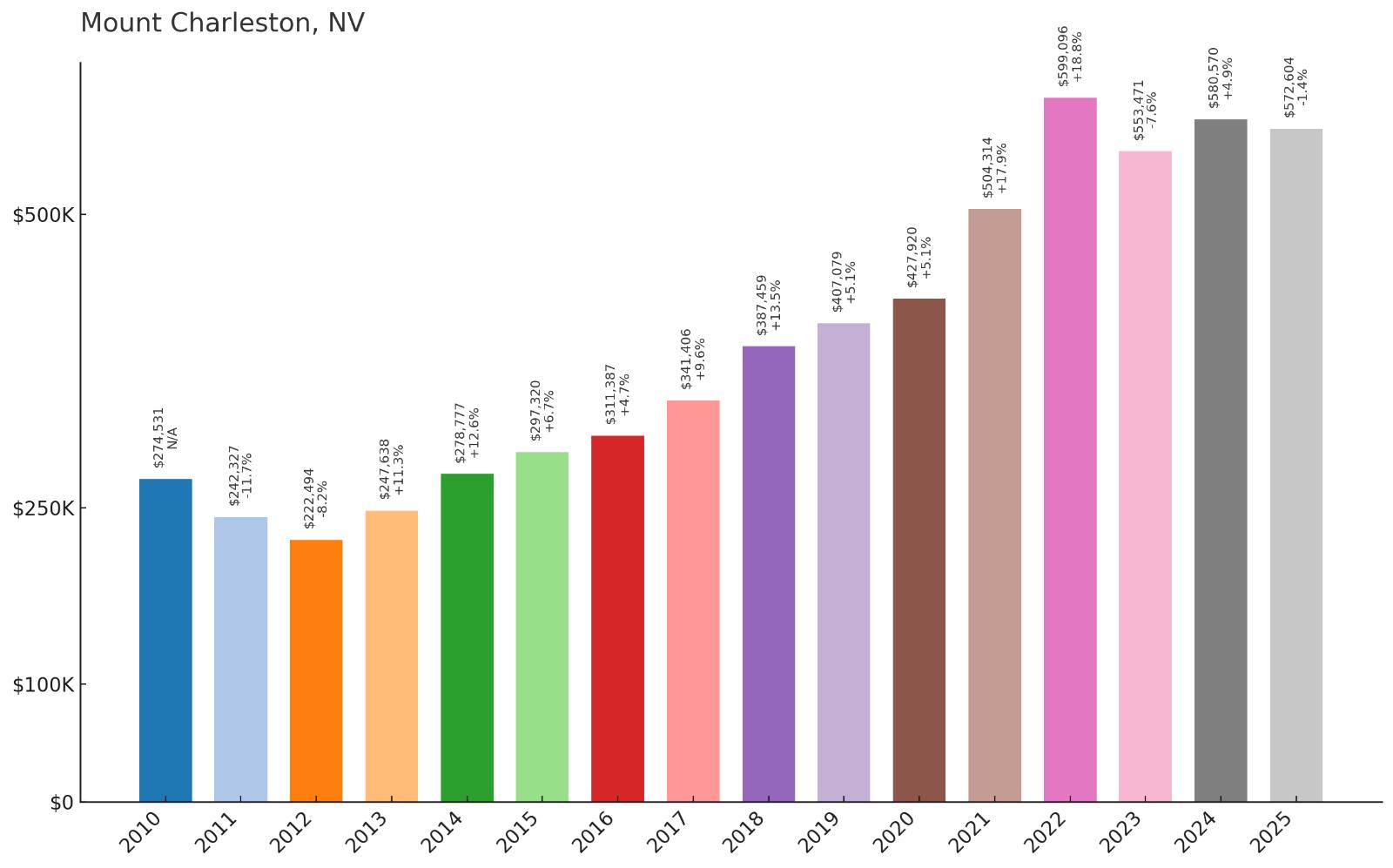
- 2010: $274,531
- 2011: $242,327
- 2012: $222,494
- 2013: $247,638
- 2014: $278,777
- 2015: $297,320
- 2016: $311,387
- 2017: $341,406
- 2018: $387,459
- 2019: $407,079
- 2020: $427,920
- 2021: $504,314
- 2022: $599,096
- 2023: $553,471
- 2024: $580,570
- 2025: $572,604
Mount Charleston has achieved solid growth with home values reaching $572,604, more than doubling since 2010 with a 108.6% increase. This unique mountain community showed consistent appreciation with notable acceleration after 2017 as Las Vegas residents sought cooler mountain retreats. The area’s distinctive alpine environment and proximity to Las Vegas create unique appeal despite recent value fluctuations.
Why Mount Charleston?
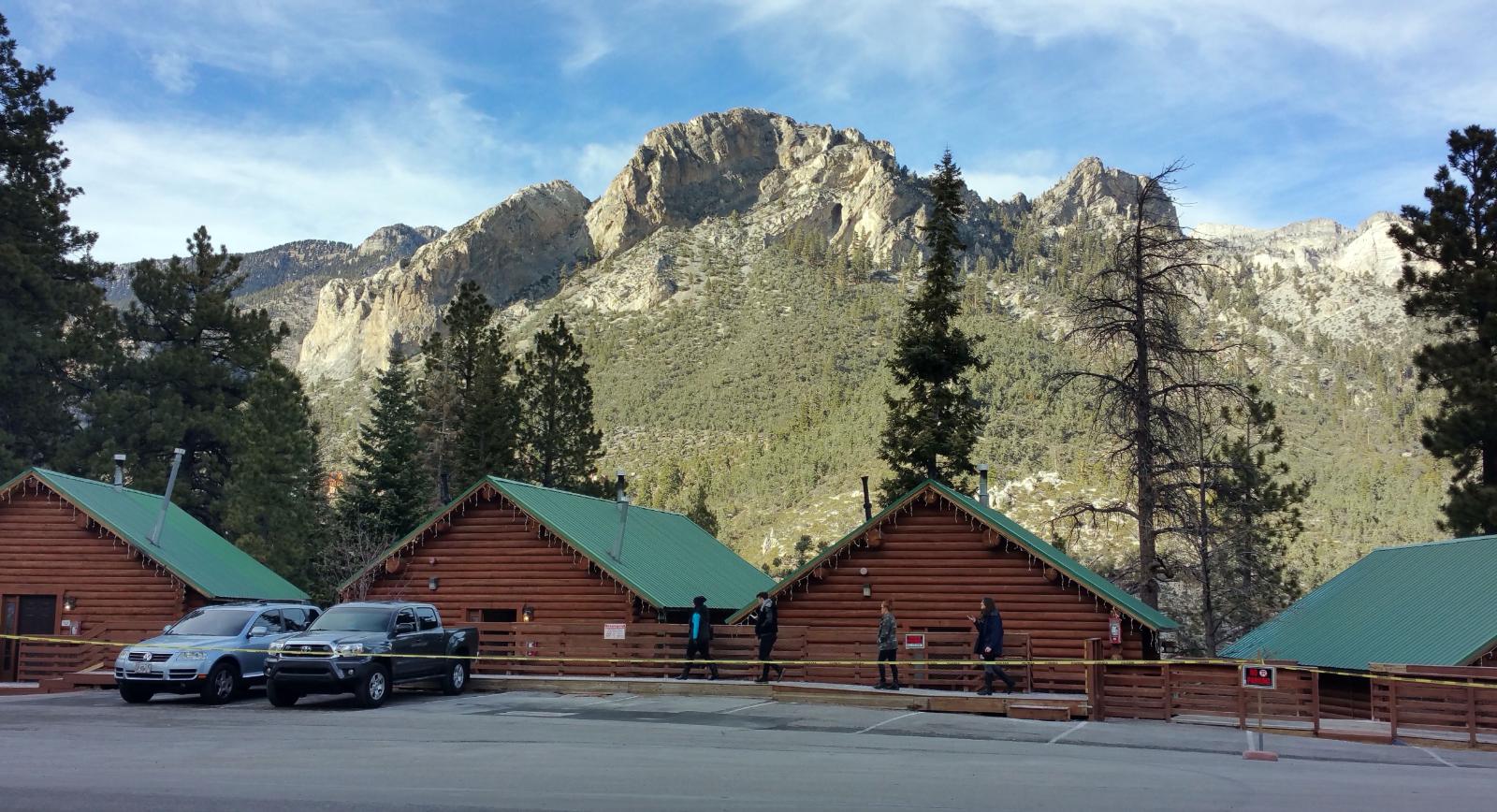
Why are people willing to pay so much to live here? What’s special about it?
Mount Charleston attracts residents seeking mountain retreat lifestyle with cooler temperatures, pine forests, and dramatic elevation changes from the Las Vegas desert below. The community offers genuine alpine living with seasonal weather, mountain recreation, and escape from desert heat while maintaining reasonable access to Las Vegas employment and services. Residents enjoy hiking trails, wildlife viewing, and four-season outdoor activities unavailable elsewhere in southern Nevada.
Unlike typical Nevada desert communities, Mount Charleston provides true mountain living with snow in winter, cool summers, and forest environments that feel more like Colorado than Nevada. The area offers unique lifestyle advantages including privacy, natural beauty, and recreational access while serving as a retreat from Las Vegas urban pressures. Limited development and environmental restrictions preserve mountain character that appeals to those seeking authentic alpine experience.
How Mount Charleston Rose to Prominence
Mount Charleston’s development began in the 1960s when entrepreneurs recognized the area’s potential as a mountain retreat for Las Vegas residents seeking escape from desert heat. Early cabins and vacation homes were built along mountain roads, taking advantage of cooler temperatures and forest environments unique in southern Nevada. The community remained small and seasonal until improved road access and utility services supported year-round living.
Growth accelerated in the 1990s and 2000s as Las Vegas expansion and rising temperatures made mountain retreats more appealing to desert residents. The area developed into a unique community combining vacation retreat character with permanent residential options for those seeking mountain lifestyle. Environmental restrictions and limited buildable land have preserved the area’s natural character while creating scarcity that supports property values.
3 Interesting Tidbits
1. Sky Island – Mount Charleston is considered a “sky island” ecosystem, with mountain forests and wildlife isolated high above the surrounding Mojave Desert like an island in the sky.
2. Temperature Refuge – Summer temperatures in Mount Charleston can be 30-40 degrees cooler than Las Vegas, making it a popular escape destination when desert temperatures exceed 110°F.
3. Bristlecone Pines – The mountain is home to ancient bristlecone pine trees, some of which are thousands of years old and among the longest-living organisms on Earth.
9. Smith – 152.8% Home Price Increase Since 2010
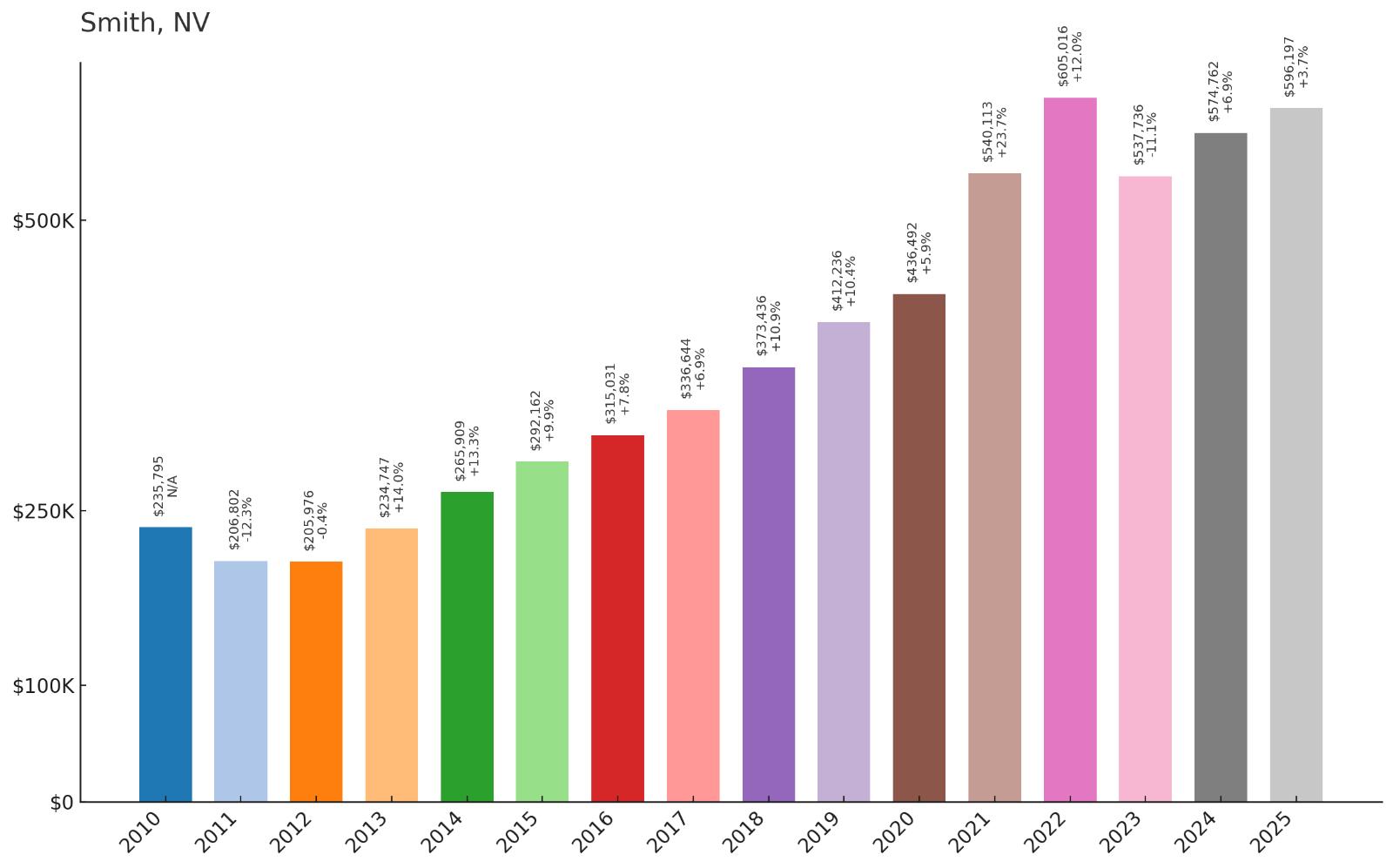
- 2010: $235,795
- 2011: $206,802
- 2012: $205,976
- 2013: $234,747
- 2014: $265,909
- 2015: $292,162
- 2016: $315,031
- 2017: $336,644
- 2018: $373,436
- 2019: $412,236
- 2020: $436,492
- 2021: $540,113
- 2022: $605,016
- 2023: $537,736
- 2024: $574,762
- 2025: $596,197
Smith has achieved strong growth with home values reaching $596,197, representing a 152.8% increase since 2010. This small Nevada community showed consistent appreciation with notable acceleration after 2018 as buyers discovered its rural appeal and proximity to larger population centers. The area’s agricultural character and open spaces have attracted residents seeking authentic rural Nevada lifestyle.
Why Smith?

Why are people willing to pay so much to live here? What’s special about it?
Smith attracts residents seeking genuine rural lifestyle with agricultural opportunities, wide-open spaces, and authentic Western character increasingly rare in modern Nevada. The community offers larger properties suitable for farming, ranching, and horse ownership while maintaining small-town atmosphere where neighbors know each other and traditional values remain strong. Scenic beauty and agricultural heritage appeal to those escaping suburban development pressures.
Unlike developed Nevada areas, Smith maintains its agricultural and ranching identity with working operations, rural roads, and minimal commercial development that preserves authentic Western atmosphere. The area provides privacy, space, and rural lifestyle advantages while keeping reasonable access to larger communities for employment and services. Agricultural opportunities and natural beauty enhance appeal for those seeking authentic Nevada rural living.
How Smith Rose to Prominence
Smith developed as an agricultural and ranching community in the early 1900s when settlers established farms and cattle operations in the valley. The area’s natural grasslands and water sources made it suitable for livestock and hay production, creating the agricultural foundation that continues today. Early residents built the irrigation systems and ranch infrastructure that still support agricultural operations throughout the valley.
The community remained primarily agricultural through most of the 20th century, with cattle ranching, hay production, and related activities forming the economic base. Recent growth reflects increased interest in rural lifestyle and agricultural properties as other Nevada areas became more developed. The area has maintained its agricultural character while attracting new residents who appreciate rural values and Western heritage.
3 Interesting Tidbits
1. Agricultural Heritage – Smith Valley has been continuously farmed and ranched for over 120 years, with some families operating the same land for multiple generations.
2. Hay Production – The valley is one of Nevada’s major hay-producing areas, with alfalfa and grass hay crops supporting both local livestock and export markets.
3. Wild Horse Range – The surrounding hills and valleys are home to wild horse herds that have roamed the area for generations, creating unique wildlife viewing opportunities.
8. Gardnerville – 170.0% Home Price Increase Since 2010
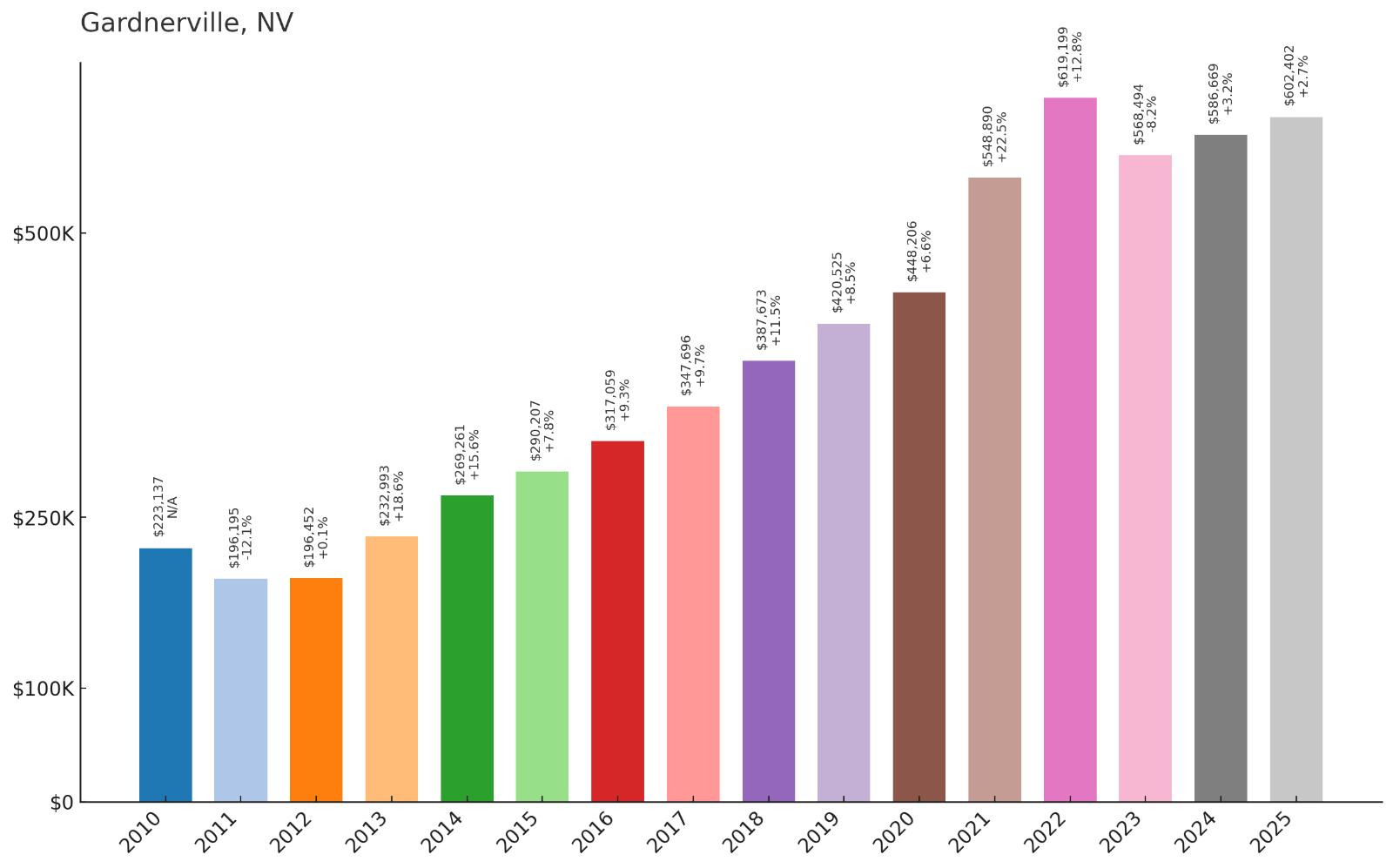
- 2010: $223,137
- 2011: $196,195
- 2012: $196,452
- 2013: $232,993
- 2014: $269,261
- 2015: $290,207
- 2016: $317,059
- 2017: $347,696
- 2018: $387,673
- 2019: $420,525
- 2020: $448,206
- 2021: $548,890
- 2022: $619,199
- 2023: $568,494
- 2024: $586,669
- 2025: $602,402
Gardnerville has achieved impressive growth with home values reaching $602,402, representing a 170.0% increase since 2010. This Carson Valley community showed consistent appreciation with notable acceleration after 2017 as its combination of small-town charm and Sierra Nevada proximity attracted buyers. The area’s agricultural heritage and recreational access have supported strong demand and sustained property value growth.
Why Gardnerville?

Why are people willing to pay so much to live here? What’s special about it?
Gardnerville attracts residents with its charming small-town atmosphere, agricultural heritage, and stunning Sierra Nevada mountain views. Families appreciate the community’s excellent schools, safe neighborhoods, and recreational opportunities while enjoying access to Lake Tahoe recreation and Carson City employment. The area offers authentic Western lifestyle with modern conveniences and agricultural opportunities that appeal to those seeking rural character with suburban amenities.
Unlike larger Nevada communities, Gardnerville maintains its historic charm with downtown festivals, local businesses, and agricultural operations that create authentic small-town atmosphere. The combination of Sierra Nevada beauty, recreational access, and community character appeals to retirees, families, and professionals seeking quality of life advantages. Agricultural heritage and mountain setting enhance lifestyle appeal beyond typical suburban options.
How Gardnerville Rose to Prominence
Gardnerville was founded in 1879 by John Gardner, who established a general store and trading post to serve ranchers and travelers in Carson Valley. The community developed around agricultural activities, with cattle ranching, farming, and related businesses creating the economic foundation. The arrival of the Virginia & Truckee Railroad brought connections to larger markets and supported continued growth through the early 20th century.
The town maintained its agricultural character while gradually adding services and amenities that attracted residents seeking small-town lifestyle with mountain recreation access. Growth accelerated in recent decades as Reno and Carson City expansion brought new residents seeking alternatives to urban living. The community has successfully balanced growth with historic preservation, maintaining character while adding modern amenities and services.
3 Interesting Tidbits
1. Basque Festival – Gardnerville hosts one of the West’s largest Basque festivals, celebrating the cultural heritage of Basque immigrants who came to the area as sheep ranchers in the 1800s.
2. Carson Valley Heritage – The downtown historic district preserves 19th-century commercial architecture and serves as the cultural center for Carson Valley’s agricultural and ranching heritage.
3. Minden Connection – Gardnerville and neighboring Minden function as twin cities sharing services and identity while maintaining separate local governments and distinct character areas.
7. Minden – 154.7% Home Price Increase Since 2010
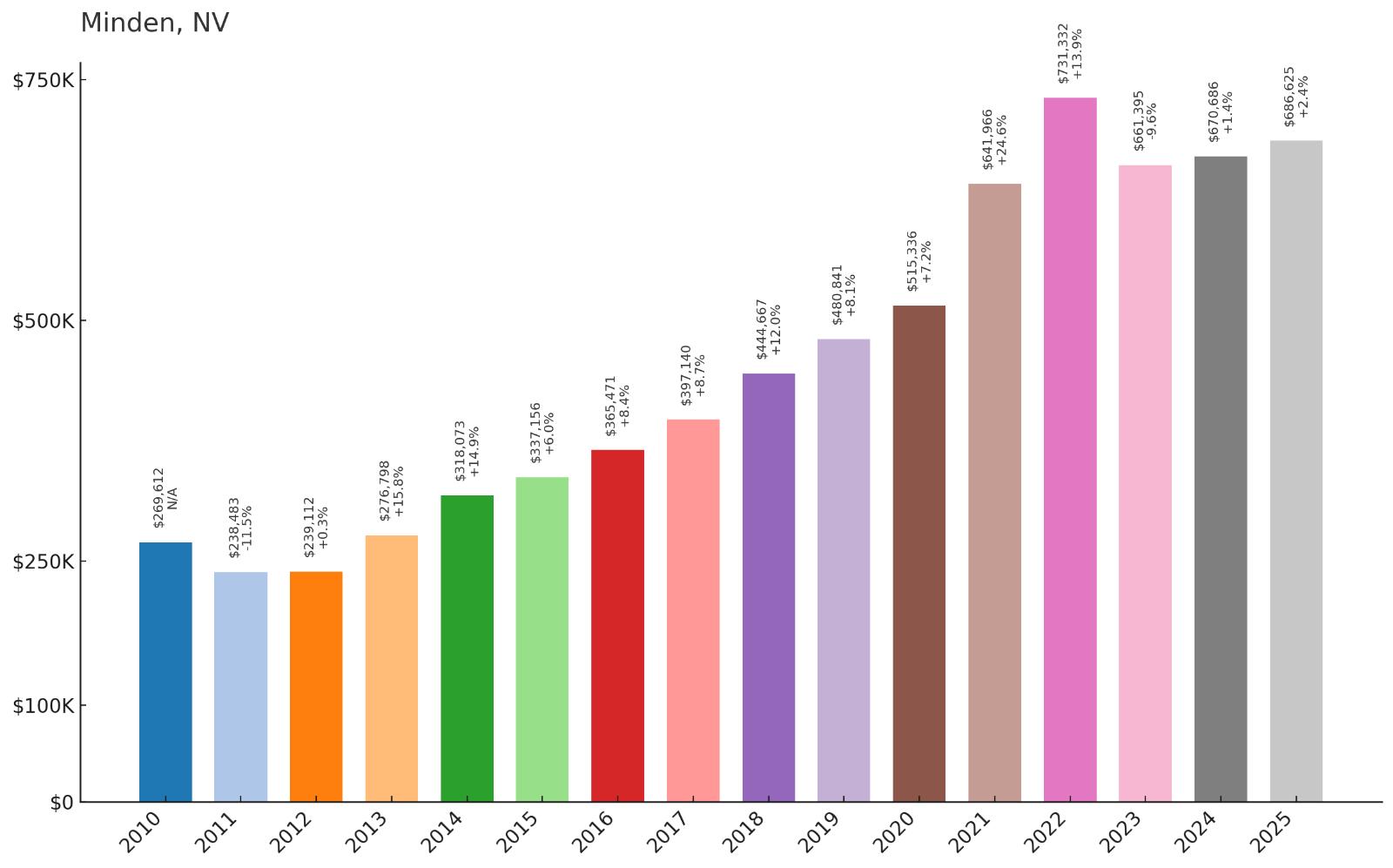
- 2010: $269,612
- 2011: $238,483
- 2012: $239,112
- 2013: $276,798
- 2014: $318,073
- 2015: $337,156
- 2016: $365,471
- 2017: $397,140
- 2018: $444,667
- 2019: $480,841
- 2020: $515,336
- 2021: $641,966
- 2022: $731,332
- 2023: $661,395
- 2024: $670,686
- 2025: $686,625
Minden has achieved strong growth with home values reaching $686,625, representing a 154.7% increase since 2010. This planned Carson Valley community showed consistent appreciation with significant acceleration after 2018 as buyers recognized its combination of planned amenities and natural beauty. The area’s master-planned character and Sierra Nevada setting have created sustained demand among quality-conscious buyers.
Why Minden?

Why are people willing to pay so much to live here? What’s special about it?
Minden attracts residents with its master-planned community amenities, gorgeous Sierra Nevada views, and proximity to Lake Tahoe recreation. The community offers golf course living, planned neighborhoods, and small-town atmosphere while maintaining access to Reno employment and California markets. Residents appreciate the area’s scenic beauty, recreational opportunities, and planned development that provides suburban conveniences in a mountain valley setting.
Unlike typical Nevada communities, Minden was developed as a planned community with golf courses, parks, and amenities designed to create resort-style living in Carson Valley. The area combines mountain beauty with suburban conveniences, appealing to retirees and professionals seeking quality of life advantages. Planned development and natural setting create unique lifestyle benefits that justify premium housing costs.
How Minden Rose to Prominence
Minden was established in 1906 as a planned community by the Carson & Colorado Railroad, designed to serve as a model town with wide streets, parks, and modern amenities. The town was carefully platted with a central business district and residential areas that reflected early 20th-century planning principles. Railroad connections supported agricultural development and provided access to markets for Carson Valley ranchers and farmers.
The community remained relatively small until modern development began in the 1980s with golf course and residential projects that transformed Minden into a destination community. The combination of planned development, natural beauty, and recreational amenities attracted retirees and affluent residents seeking mountain lifestyle with urban conveniences. Recent growth reflects continued appeal of planned community living in spectacular natural settings.
3 Interesting Tidbits
1. Planned Perfection – Minden was one of the West’s early planned communities, designed by railroad company with wide streets, central park, and geometric layout that still defines the town center today.
2. Golf Paradise – The community features multiple championship golf courses that attract players from throughout the region and support resort-style living in Carson Valley.
3. German Heritage – Minden was named after Minden, Germany, reflecting the German heritage of some early railroad officials and the community’s European-influenced planning approach.
6. Stateline – 82.8% Home Price Increase Since 2010

- 2010: $423,064
- 2011: $370,688
- 2012: $365,841
- 2013: $412,310
- 2014: $493,559
- 2015: $517,190
- 2016: $516,206
- 2017: $535,179
- 2018: $561,709
- 2019: $599,345
- 2020: $647,272
- 2021: $838,187
- 2022: $946,254
- 2023: $806,415
- 2024: $760,159
- 2025: $773,254
Stateline has shown steady growth with home values reaching $773,254, representing an 82.8% increase since 2010. This Lake Tahoe gaming community experienced significant acceleration during the pandemic housing boom, with values nearly doubling between 2020 and 2022 before moderating. The area’s unique position on the Nevada-California border and Lake Tahoe access maintain premium market appeal despite recent volatility.
Why Stateline?

Why are people willing to pay so much to live here? What’s special about it?
Stateline attracts residents with its unique lakefront location, gaming and entertainment venues, and access to world-class skiing and recreation at Lake Tahoe. The community offers casino employment opportunities, resort amenities, and stunning alpine lake views while providing Nevada tax advantages for residents working in California. Year-round recreation including skiing, hiking, and water sports creates lifestyle appeal that justifies premium housing costs.
Unlike typical Nevada communities, Stateline combines casino resort atmosphere with alpine lake living, creating unique entertainment and recreation opportunities. The area provides immediate access to Lake Tahoe beaches, hiking trails, and ski resorts while maintaining gaming industry employment and entertainment options. Border location allows residents to enjoy Nevada tax benefits while accessing California recreational and cultural opportunities.
How Stateline Rose to Prominence
Stateline developed in the 1940s and 1950s when Nevada’s liberal gambling laws created opportunities for casino development on the California border at Lake Tahoe. Entrepreneurs recognized the potential to attract California gamblers to Nevada casinos while providing resort amenities in the spectacular lake setting. Early casinos like Harrah’s and Harvey’s established the gaming foundation that continues to drive the local economy.
The community evolved from simple gambling halls to full-service resort destination with hotels, restaurants, entertainment venues, and recreational amenities. Growth accelerated as Lake Tahoe became a premier vacation destination and permanent residence option for those seeking alpine lifestyle. The combination of gaming industry employment, recreation access, and tax advantages continues attracting residents despite high housing costs.
3 Interesting Tidbits
1. Border Town – Stateline literally straddles the Nevada-California border, allowing visitors to walk between states and residents to enjoy tax advantages of Nevada residence.
2. Casino Capital – The community hosts some of Lake Tahoe’s largest casinos and entertainment venues, making it the gaming center for the entire Tahoe basin region.
3. Ski Access – Stateline provides immediate access to Heavenly Ski Resort, one of California’s largest ski areas, with gondola transportation from casino hotels directly to the slopes.
5. Verdi – 150.9% Home Price Increase Since 2010
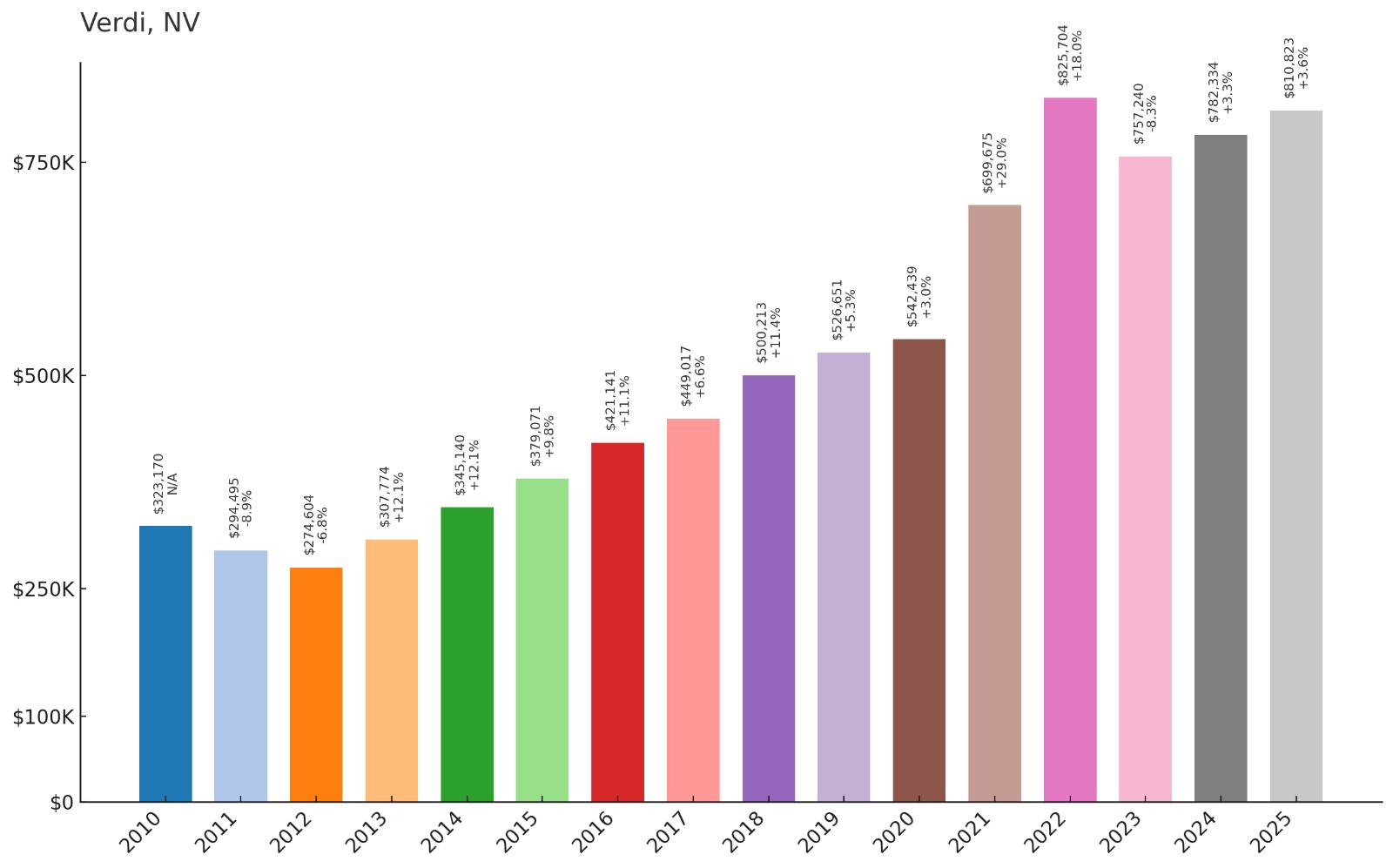
- 2010: $323,170
- 2011: $294,495
- 2012: $274,604
- 2013: $307,774
- 2014: $345,140
- 2015: $379,071
- 2016: $421,141
- 2017: $449,017
- 2018: $500,213
- 2019: $526,651
- 2020: $542,439
- 2021: $699,675
- 2022: $825,704
- 2023: $757,240
- 2024: $782,334
- 2025: $810,823
Verdi has achieved remarkable growth with home values reaching $810,823, representing a 150.9% increase since 2010. This small border community showed consistent appreciation with dramatic acceleration after 2020 as buyers discovered its California-Nevada border advantages and Truckee River setting. The area’s unique position and recreational access have created sustained demand among affluent buyers seeking mountain lifestyle.
Why Verdi?
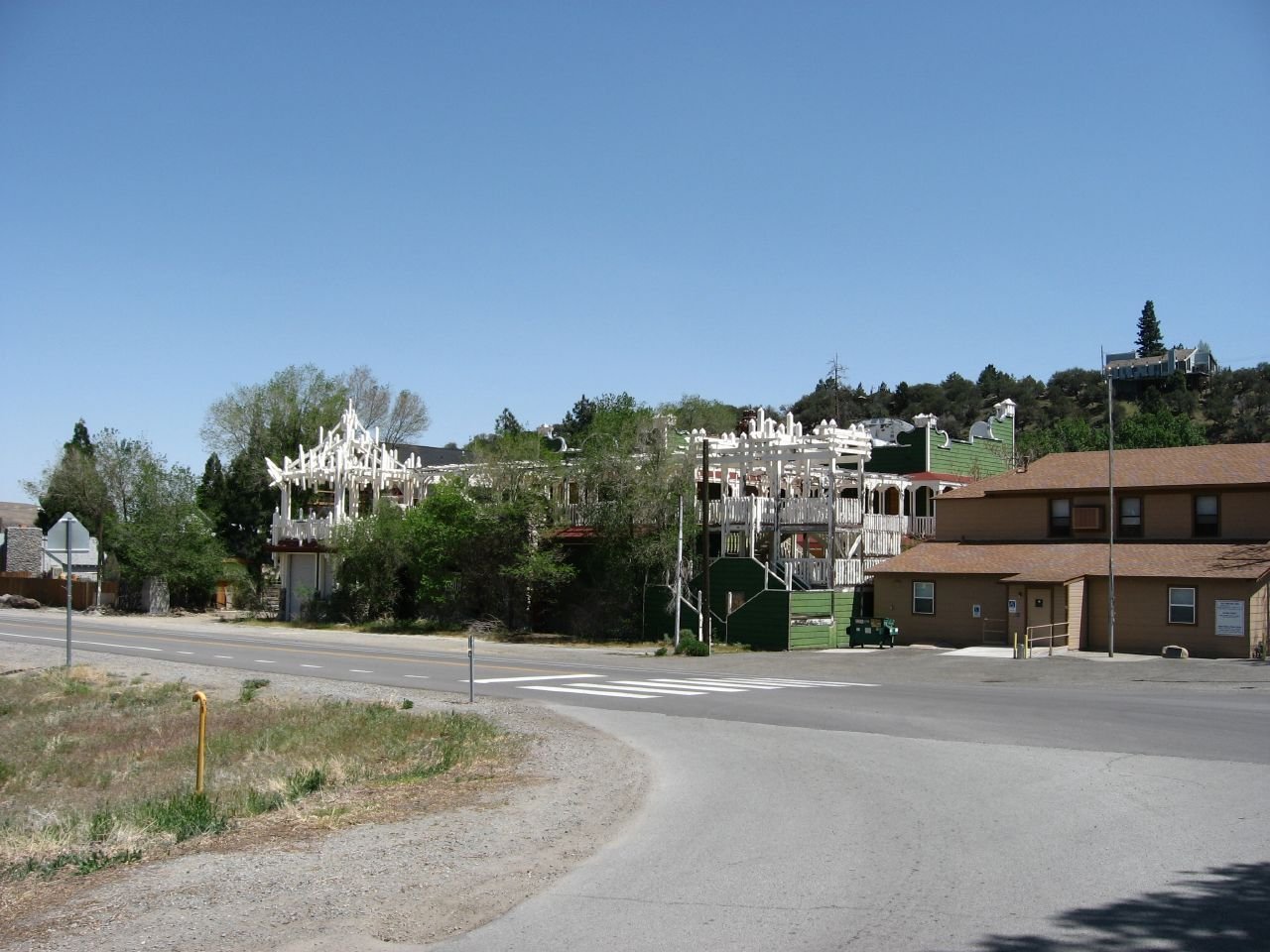
Why are people willing to pay so much to live here? What’s special about it?
Verdi attracts residents with its unique location straddling the Nevada-California border, offering Nevada tax benefits while maintaining access to California employment and amenities. The community provides mountain lifestyle with Truckee River recreation, hiking access, and proximity to Lake Tahoe while avoiding California’s high taxes and regulations. Rural character and natural beauty appeal to those seeking authentic mountain living with financial advantages.
Unlike typical Nevada communities, Verdi combines border location benefits with genuine mountain recreation access and rural character that feels more like Colorado than Nevada. The area offers larger properties, river access, and hiking opportunities while providing easy commutes to California employment centers. Natural beauty and tax advantages create unique lifestyle and financial benefits that justify premium housing costs.
How Verdi Rose to Prominence
Verdi was established in 1868 as a railroad town when the Central Pacific Railroad built through the area, creating a depot and maintenance facility near the California border. The town was named for Giuseppe Verdi, the famous Italian opera composer, reflecting the cultural interests of railroad officials. Early economy centered on railroad operations and lumber mills that processed timber from surrounding forests.
The community remained small and railroad-dependent until modern development began attracting residents seeking border location advantages and mountain lifestyle. The combination of Nevada tax benefits, California employment access, and recreational amenities has driven recent growth and property value appreciation. Proximity to both Reno and California markets while maintaining rural mountain character creates unique appeal for affluent buyers.
3 Interesting Tidbits
1. Opera Connection – Verdi is one of the few American towns named for an opera composer, reflecting the cultural sophistication of 19th-century railroad developers.
2. Border Benefits – The town straddles the Nevada-California border, allowing residents to live in Nevada for tax purposes while working in California’s higher-wage economy.
3. River Town – The Truckee River flows through Verdi, providing year-round water recreation and creating riparian habitat that supports diverse wildlife in the Sierra Nevada foothills.
4. Genoa – 129.9% Home Price Increase Since 2010

- 2010: $496,312
- 2011: $431,946
- 2012: $434,151
- 2013: $458,961
- 2014: $507,900
- 2015: $534,548
- 2016: $570,130
- 2017: $598,480
- 2018: $657,448
- 2019: $710,018
- 2020: $763,901
- 2021: $1,013,246
- 2022: $1,225,767
- 2023: $1,089,941
- 2024: $1,136,136
- 2025: $1,141,008
Genoa has achieved strong growth with home values reaching $1,141,008, representing a 129.9% increase since 2010. Nevada’s oldest settlement showed consistent appreciation with dramatic acceleration after 2020 as buyers recognized its historic significance and Carson Valley location. The community’s authentic Western heritage and proximity to Lake Tahoe have created sustained demand among affluent buyers seeking historic character with modern amenities.
Why Genoa?
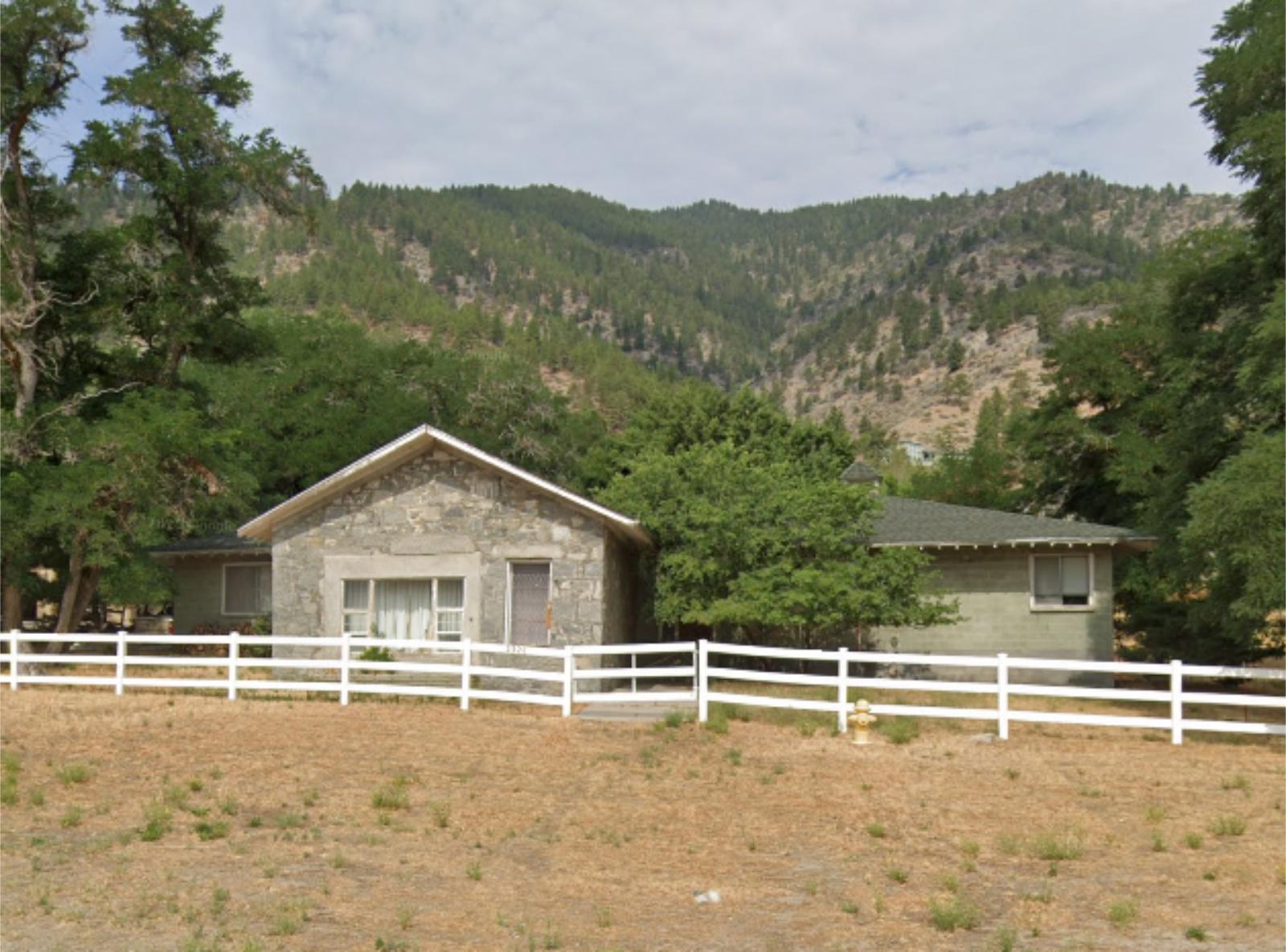
Why are people willing to pay so much to live here? What’s special about it?
Genoa attracts residents with its distinction as Nevada’s first settlement, offering authentic Western history combined with stunning Sierra Nevada views and Carson Valley location. The community provides small-town charm with historic buildings, cultural events, and agricultural heritage while maintaining proximity to Lake Tahoe recreation and Reno employment. Historic significance and natural beauty create unique lifestyle advantages that appeal to affluent buyers seeking authentic Nevada heritage.
Unlike newer Nevada developments, Genoa offers genuine 19th-century Western atmosphere with preserved historic buildings, museums, and cultural sites that connect residents to Nevada’s founding story. The area combines historic preservation with natural beauty and recreational access, creating lifestyle benefits unavailable in typical suburban communities. Agricultural heritage and mountain setting enhance appeal beyond standard historic preservation efforts.
How Genoa Rose to Prominence
Genoa was established in 1850 as Nevada’s first permanent settlement, originally called Mormon Station when Mormon pioneers established a trading post to serve California-bound emigrants. The community served as a crucial supply stop for wagon trains crossing the Sierra Nevada, providing provisions, livestock, and equipment for the dangerous mountain passage. The name was changed to Genoa in 1855 to honor Christopher Columbus’s birthplace.
The town played a central role in early Nevada territorial government and served as the first seat of Carson County when the territory was organized. Historic buildings including Nevada’s oldest courthouse and pioneer-era residences create an authentic Western atmosphere preserved through careful heritage tourism development. Modern appeal combines historic significance with Carson Valley beauty and recreational access that attracts affluent residents and visitors.
3 Interesting Tidbits
1. Nevada’s First – Genoa holds the distinction of being Nevada’s oldest permanent settlement, established in 1850 as Mormon Station to serve California-bound emigrants.
2. Courthouse Legacy – The historic Genoa Courthouse, built in 1865, served as Nevada’s first territorial courthouse and now operates as a museum showcasing early Nevada government and law.
3. Candy Dance – Genoa’s annual Candy Dance festival, held since 1919, was originally created to raise money for streetlights and has become one of Nevada’s most beloved heritage celebrations.
3. Zephyr Cove – 150.4% Home Price Increase Since 2010
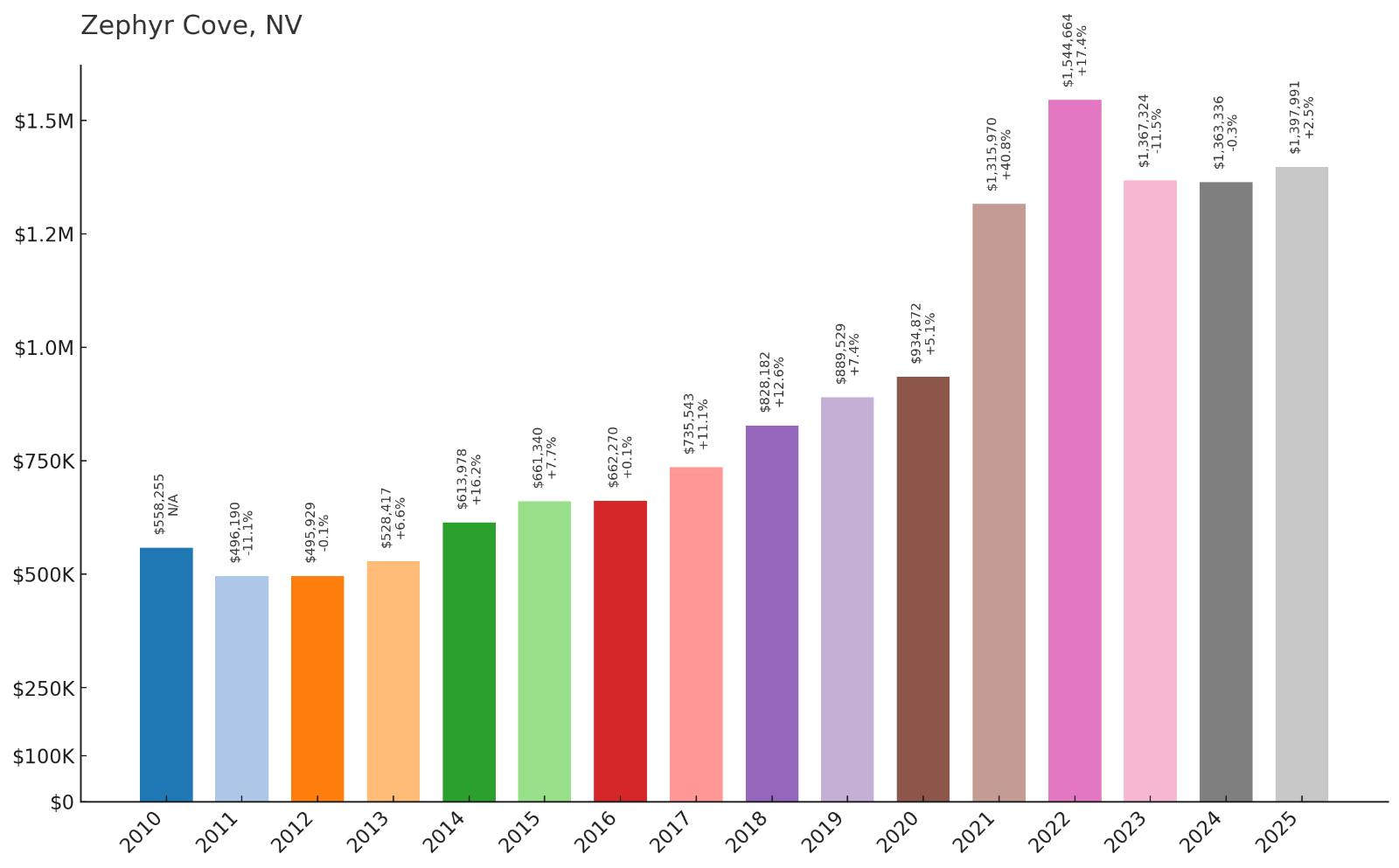
- 2010: $558,255
- 2011: $496,190
- 2012: $495,929
- 2013: $528,417
- 2014: $613,978
- 2015: $661,340
- 2016: $662,270
- 2017: $735,543
- 2018: $828,182
- 2019: $889,529
- 2020: $934,872
- 2021: $1,315,970
- 2022: $1,544,664
- 2023: $1,367,324
- 2024: $1,363,336
- 2025: $1,397,991
Zephyr Cove has achieved impressive growth with home values reaching $1,397,991, representing a 150.4% increase since 2010. This exclusive Lake Tahoe community showed consistent appreciation with dramatic acceleration after 2020 as pandemic buyers sought mountain retreats with lake access. The area’s pristine lakefront location and recreational amenities have created sustained demand among wealthy buyers seeking premium mountain lifestyle.
Why Zephyr Cove?
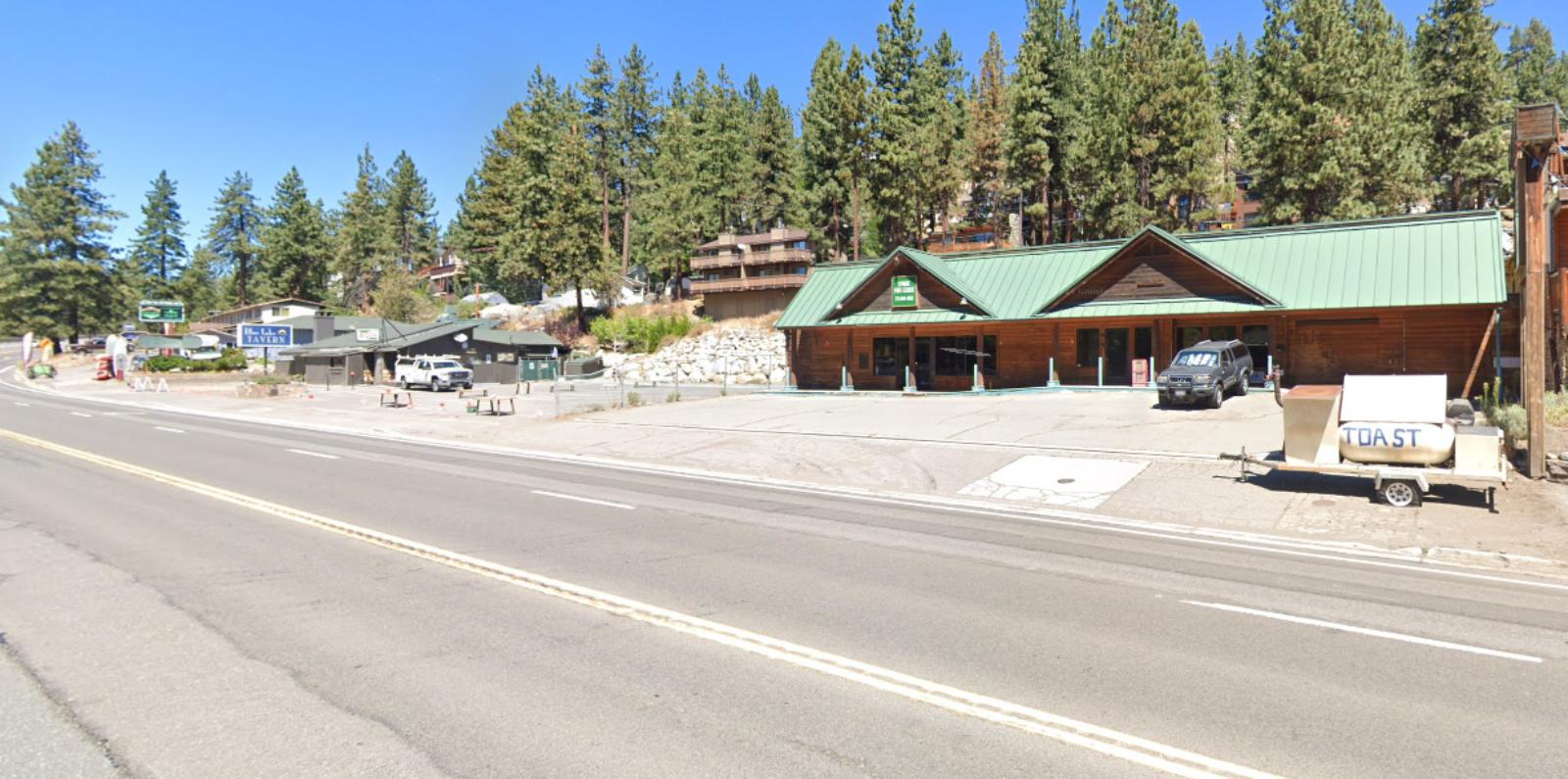
Why are people willing to pay so much to live here? What’s special about it?
Zephyr Cove attracts affluent residents with its exclusive lakefront location on Lake Tahoe’s eastern shore, offering direct beach access, marina facilities, and stunning alpine lake views. The community provides luxury mountain living with world-class recreation including boating, skiing, and hiking while maintaining Nevada tax advantages over California Tahoe communities. Premium lakefront properties and resort amenities justify exceptional housing costs for those seeking ultimate Lake Tahoe lifestyle.
Unlike other Tahoe communities, Zephyr Cove offers direct lake access with private beaches, marina services, and lakefront properties that create resort-style living in a pristine alpine setting. The area combines luxury amenities with natural beauty and recreational opportunities that appeal to wealthy buyers seeking the ultimate mountain retreat. Limited development and environmental restrictions preserve exclusivity and natural character.
How Zephyr Cove Rose to Prominence
Zephyr Cove was developed in the early 1900s as a Lake Tahoe resort destination, with the natural cove providing protected harbor for steamships that transported visitors around the lake. Early development included rustic cabins and resort facilities that took advantage of the area’s natural beauty and recreational opportunities. The protected cove location made it ideal for boat launches and water recreation activities.
Modern development began in the 1960s and 1970s as improved highway access made Lake Tahoe more accessible to urban residents seeking mountain retreats. The combination of lakefront location, recreational amenities, and Nevada tax advantages attracted affluent buyers who developed the area into an exclusive residential community. Limited buildable land and environmental restrictions have preserved natural character while creating scarcity that supports premium property values.
3 Interesting Tidbits
1. Steamship Legacy – Zephyr Cove served as a major steamship landing in the early 1900s, when paddle-wheel boats transported visitors around Lake Tahoe before automobile access was developed.
2. MS Dixie II – The historic paddle-wheel boat MS Dixie II operates from Zephyr Cove, offering scenic lake cruises that continue the area’s maritime tourism tradition.
3. Protected Cove – The natural cove formation provides protected waters ideal for boating and water sports, making it one of Lake Tahoe’s premier marina and recreation locations.
2. Incline Village – 142.2% Home Price Increase Since 2010
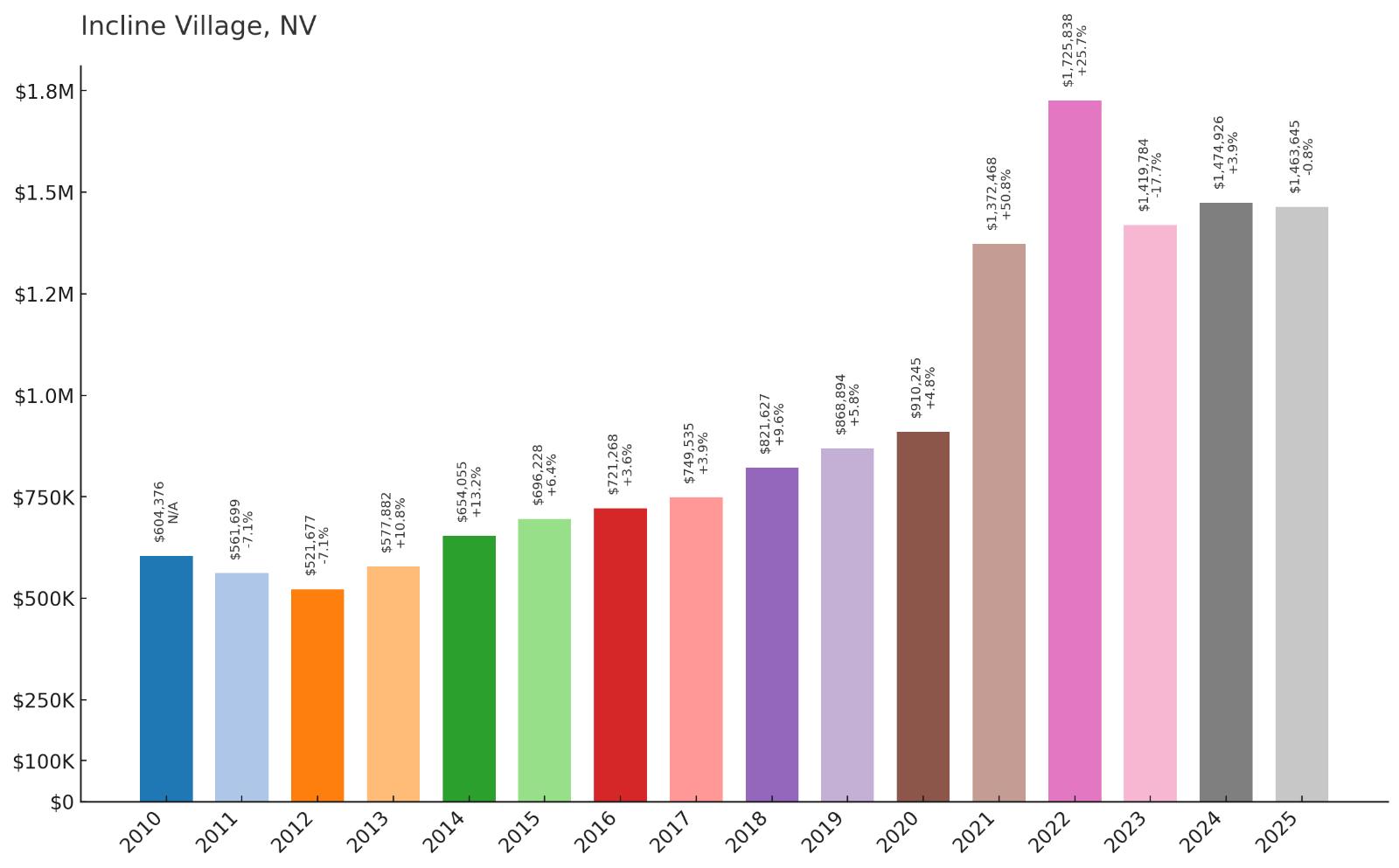
- 2010: $604,376
- 2011: $561,699
- 2012: $521,677
- 2013: $577,882
- 2014: $654,055
- 2015: $696,228
- 2016: $721,268
- 2017: $749,535
- 2018: $821,627
- 2019: $868,894
- 2020: $910,245
- 2021: $1,372,468
- 2022: $1,725,838
- 2023: $1,419,784
- 2024: $1,474,926
- 2025: $1,463,645
Incline Village has achieved substantial growth with home values reaching $1,463,645, representing a 142.2% increase since 2010. This premier Lake Tahoe community showed consistent appreciation with dramatic acceleration after 2020 as pandemic buyers sought luxury mountain retreats. The area’s exclusive amenities, championship golf courses, and pristine lake access have created sustained demand among wealthy buyers seeking the ultimate Tahoe lifestyle.
Why Incline Village?

Why are people willing to pay so much to live here? What’s special about it?
Incline Village attracts affluent residents with its status as Lake Tahoe’s most exclusive community, offering championship golf courses, private beaches, and luxury amenities in a pristine alpine setting. The community provides world-class recreation including skiing at Diamond Peak, beach access, and hiking trails while maintaining strict development standards that preserve natural beauty. Nevada tax advantages and exclusive amenities justify premium housing costs for wealthy buyers seeking ultimate mountain luxury.
Unlike other Tahoe communities, Incline Village was developed as a comprehensive resort community with amenities typically found only at exclusive resorts, including championship golf courses, tennis facilities, and private beach clubs. The area combines luxury lifestyle with environmental preservation, creating unique living experience that appeals to wealthy professionals and retirees. Exclusive character and natural beauty maintain property values despite market fluctuations.
How Incline Village Rose to Prominence
Incline Village was developed in the 1960s by Arthur Wood, who purchased 9,000 acres of Lake Tahoe shoreline and created one of America’s most exclusive planned communities. The development was designed to provide luxury mountain living with resort-style amenities while preserving the area’s natural beauty through careful planning and environmental restrictions. Golf courses, beaches, and recreational facilities were integrated with residential development to create comprehensive resort community.
The community’s reputation grew as it attracted wealthy residents and celebrities seeking privacy and luxury in spectacular natural settings. Strict architectural standards and development restrictions preserved environmental quality while creating exclusivity that appeals to affluent buyers. The combination of luxury amenities, natural beauty, and community character established Incline Village as Lake Tahoe’s premier residential destination.
3 Interesting Tidbits
1. Celebrity Hideaway – Incline Village has long been a favorite retreat for celebrities and wealthy individuals seeking privacy and luxury in spectacular Lake Tahoe setting.
2. Championship Golf – The community features two championship golf courses designed by Robert Trent Jones, consistently ranked among America’s most scenic and challenging mountain courses.
3. Private Beaches – Incline Village residents enjoy access to private beaches and recreation facilities that are restricted to community members, creating exclusive Lake Tahoe lifestyle advantages.
1. Glenbrook – 130.6% Home Price Increase Since 2010

- 2010: $1,125,522
- 2011: $997,756
- 2012: $978,578
- 2013: $1,049,161
- 2014: $1,195,989
- 2015: $1,341,147
- 2016: $1,390,939
- 2017: $1,488,122
- 2018: $1,615,536
- 2019: $1,703,295
- 2020: $1,815,402
- 2021: $2,616,857
- 2022: $3,225,442
- 2023: $2,702,751
- 2024: $2,723,757
- 2025: $2,595,136
Glenbrook stands as Nevada’s most expensive community with home values reaching $2,595,136, representing a 130.6% increase since 2010. This ultra-exclusive Lake Tahoe enclave showed consistent appreciation with dramatic acceleration after 2020 as wealthy buyers sought the ultimate in luxury mountain living. The community’s combination of pristine lakefront location, historic significance, and extreme exclusivity has created Nevada’s premier luxury real estate market.
Why Glenbrook?

Why are people willing to pay so much to live here? What’s special about it?
Glenbrook attracts the ultra-wealthy with its status as Lake Tahoe’s most exclusive and historic community, offering unparalleled privacy, pristine lakefront properties, and luxury amenities in a spectacular natural setting. The community provides ultimate mountain luxury with private beaches, historic estates, and recreational facilities while maintaining strict privacy and exclusivity that appeals to celebrities, business leaders, and wealthy families. Historic significance and natural beauty create unique lifestyle advantages unavailable anywhere else in Nevada.
Unlike any other Nevada community, Glenbrook combines extreme exclusivity with historic significance as one of Lake Tahoe’s original resort developments, featuring some of the most expensive residential properties in the American West. The area offers ultimate privacy and luxury with lakefront estates, private facilities, and carefully controlled development that preserves natural character. Limited access and extraordinary amenities justify exceptional housing costs for those seeking the absolute pinnacle of mountain living.
How Glenbrook Rose to Prominence
Glenbrook was established in the 1860s as one of Lake Tahoe’s first resort destinations, serving wealthy visitors who arrived by stagecoach and later by railroad connections. The area became famous for its luxury accommodations and pristine natural setting, attracting San Francisco’s elite who built summer estates along the protected shoreline. Historic development included some of Lake Tahoe’s first luxury lodges and private residences designed for affluent tourists.
The community evolved into an exclusive residential enclave as automobile access made permanent residence feasible for wealthy individuals seeking mountain retreats. Careful development restrictions and private ownership have preserved the area’s historic character while creating one of America’s most exclusive residential communities. The combination of historic significance, natural beauty, and extreme exclusivity established Glenbrook as the ultimate Lake Tahoe luxury destination.
3 Interesting Tidbits
1. Tahoe’s First Resort – Glenbrook was one of Lake Tahoe’s original luxury resort destinations, serving San Francisco’s wealthy elite in the late 1800s with exclusive accommodations and recreational facilities.
2. Timber Baron Legacy – The community was developed by lumber baron Duane Bliss, whose timber operations helped build the Comstock mining region while creating one of Tahoe’s first luxury destinations.
3. Ultra-Exclusive – Glenbrook remains so exclusive that it’s difficult for outsiders to even visit, with private roads and security that maintain privacy for some of America’s wealthiest residents.



